Archived Blog Posts
Does Water Damage Decrease Home Value? Expert Insights and Tips
8/13/2024 (Permalink)
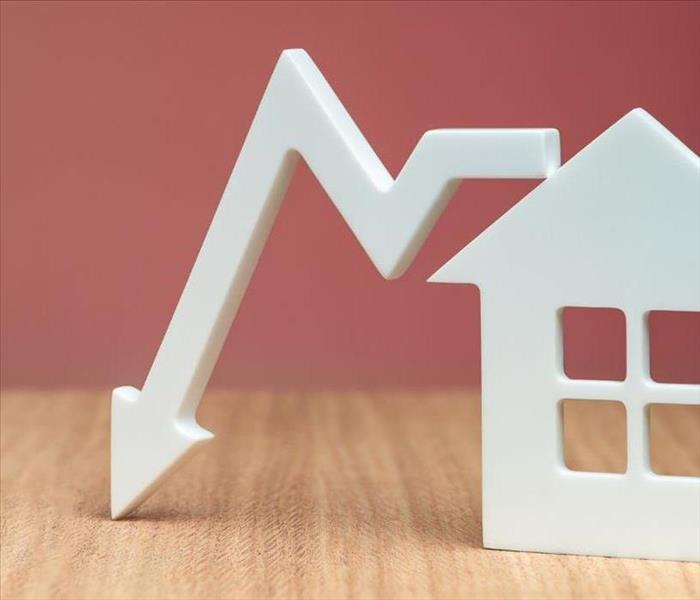 Home value going down?
Home value going down?
Does water damage decrease home value? Water damage is a serious concern for homeowners. Whether caused by a burst pipe, heavy rainfall, or a leaking roof, water damage can significantly impact the value of your home. It is important you understand how water damage Weymouth MA or water damage in general can affect your property. We'll explore how water damage can decrease home value and provide expert tips on managing and mitigating its effects.
Water Damage and Its Impact
Water damage happens when water intrudes into your home, leading to destructive processes such as rotting wood, mold growth, rusting of steel, and delaminating materials like plywood. Common causes include plumbing leaks, roof leaks, and natural disasters like floods. Water damage can severely affect a property both structurally and aesthetically. Structural issues may include weakened foundations, warped floors, and damaged walls. Aesthetically, water damage can cause stains, peeling paint, and unpleasant smells. But more importantly, does water damage decrease home value? The answer is a resounding yes.
How Water Damage Decreases Home Value
Water damage can reduce home value in several specific ways. Here's an in-depth look at each aspect:
Structural Issues
One of the most severe consequences of water damage is its impact on a home's structural integrity. When water infiltrates a building, it can seep into the foundation, walls, and floors, causing them to weaken over time. Key structural issues include foundation damage, warped floors and walls, and compromised structural beams.
Mold Growth
Mold is another major issue associated with water damage. Mold grows in damp environments, and once it starts growing, it can spread quickly. The presence of mold can significantly decrease home value for several reasons, such as health hazards, extensive remediation costs, and persistent smells.
Cosmetic Damage
Visible signs of water damage can make a home much less appealing to potential buyers. These cosmetic issues can significantly decrease the home value after water damage. Some common cosmetic problems include stains and discoloration, peeling paint and wallpaper, damaged flooring, and rotting wood.
Assessing the Extent of Water Damage
To understand how much water damage your home has sustained, start by doing a thorough inspection. Look for visible signs like water stains on walls and ceilings, warped or buckled floors, and any musty smells indicating mold presence. For a more accurate assessment, consider hiring a professional. Water damage restoration experts use specialized equipment to detect hidden moisture and assess structural damage.
Mitigating Water Damage to Preserve Home Value
Once you've identified water damage, taking immediate steps to mitigate it is necessary:
- Remove Standing Water: Use pumps and wet vacuums to remove standing water. The faster you act, the less damage will happen, minimizing the risk of further structural and cosmetic issues.
- Dry Affected Areas: Use fans, dehumidifiers, and proper ventilation to dry out the affected areas thoroughly. Ensuring complete dryness prevents mold growth and additional damage.
- Clean and Disinfect: Clean and disinfect to prevent mold growth. Use appropriate cleaning agents to ensure all surfaces are safe and free from bacteria and contaminants.
- Repair and Restore: Tackle the root cause of the water damage to prevent future incidents. Repair structural damage and restore the aesthetic appearance of your home to maintain its market value.
Does Water Damage Decrease Home Value? Selling a House with Water Damage
Selling a house with water damage presents unique challenges. Potential buyers are likely to be wary of the hidden costs and health risks associated with water damage. To successfully sell home with water damage, transparency is key. Consider the following tips when selling a house with water damage:
- Disclose the Damage: Legally, you must disclose any known water damage to potential buyers. Being upfront builds trust and avoids legal issues later, ensuring a smoother transaction process.
- Provide Repair Estimates: Offer estimates for repairs to help buyers understand the cost implications. This transparency can make buyers feel more confident about purchasing a home with past water damage.
- Consider Repairs Before Selling: If possible, repair the damage before listing your home. A well-maintained property is more attractive to buyers and can fetch a higher price, helping you recover some of the repair costs.
Legal and Disclosure Requirements
When selling your home, you are legally required to disclose any water damage. This includes past incidents that have been repaired. Buyers have a right to know about the history of the property they are considering purchasing, especially when it comes to significant issues like water damage. Disclosure laws vary by state, but generally, failure to disclose such information can lead to severe legal consequences. These can include lawsuits from buyers who may feel misled or deceived, financial penalties, and even the potential nullification of the sale. Transparency and honesty in real estate transactions are not just ethical obligations but legal ones as well.
Working with Professionals
Working with water damage restoration professionals is necessary to tackle and mitigate water damage successfully. These experts have the knowledge and skills required to handle all aspects of water damage, from initial assessment to complete restoration. They can detect hidden moisture, ensure thorough drying, and prevent mold growth using specialized tools and equipment. Their experience allows them to identify potential issues that may not be immediately visible, helping to prevent further damage down the line.
SERVPRO of Weymouth, Hingham and Quincy: Your Partner in Water Damage Restoration
Don't let water damage decrease your home's value! Contact SERVPRO of Weymouth, Hingham, and Quincy today for expert water damage restoration services. Our professionals are ready to help you restore your home and ensure it remains safe and valuable. Call us at (781) 337-0344 or fill out an online form on our website.
Tips for Water Damaged Floor Repair: Restore Your Home Quickly and Successfully
8/7/2024 (Permalink)
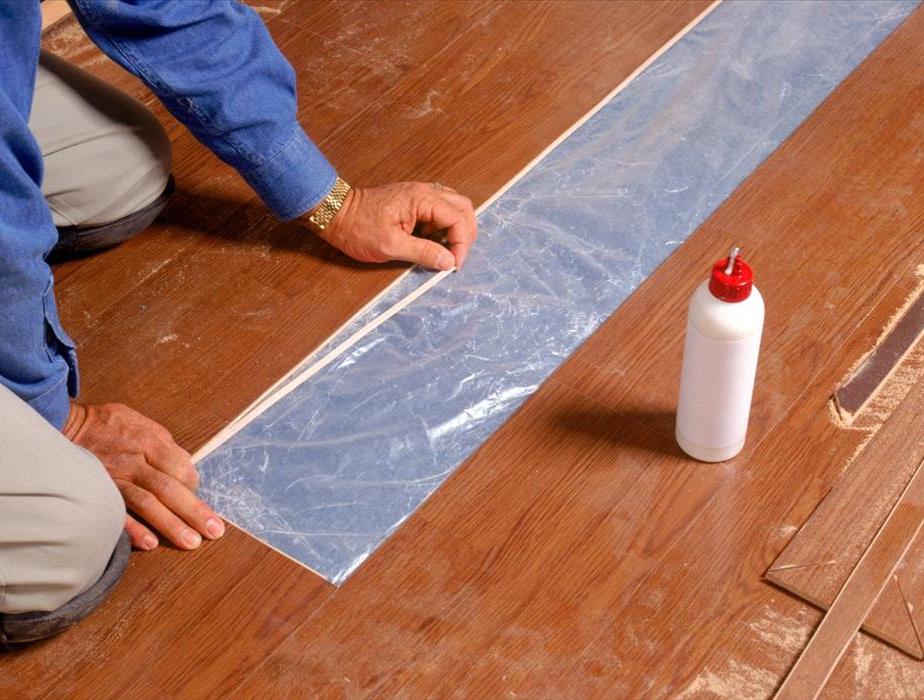 Water damaged floor
Water damaged floor
Water damage to floors is a common issue that many homeowners face. Whether it's due to a burst pipe, a leaking roof, or a natural disaster, water can wreak havoc on your wood floors. Timely water damaged floor repair is crucial to prevent further damage and restore your home to its original condition. If you're in need of professional help, consider Weymouth MA water damage restoration services or your local experts to get the job done right.
Identifying Water Damage
Before you can repair the damage, you need to identify it. Here are some signs of water damage on wood flooring:
- Discoloration: Look for dark or light spots on your floors.
- Warping: Check for areas where the wood is buckling or cupping.
- Soft spots: Press down gently on the floor to see if any areas feel spongy.
How to Repair Water Damaged Wood Floor
Repairing a water damaged wood floor may seem challenging, but with the right steps and tools, it can be manageable. Here's a detailed step-by-step guide on how to repair water damaged wood floor:
Assess the Damage
Start by using a moisture meter to check if the floor is completely dry. This step is important because repairing wood that still contains moisture can lead to further damage. Make sure the moisture levels are back to normal before proceeding with any repairs.
Remove Damaged Boards
Once you’ve confirmed that the floor is dry, carefully take out any boards that are beyond repair. Use a pry bar and a hammer to lift the damaged boards. Be cautious to avoid damaging the surrounding boards that are still in good condition.
Replace with New Wood
Next, you’ll need to replace the damaged boards with new wood. When selecting new boards, try to match them with your existing floor as closely as possible in terms of wood type, grain pattern, and color. This will help maintain a consistent look across your floor. Cut the new boards to fit the gaps left by the removed boards
Sand the Area
Once the new boards are in place, sand the repaired area to ensure it’s level with the rest of the floor. Start with a coarse grit sandpaper to remove any rough edges and then move to a finer grit to smooth the surface. Sanding will help blend the new boards with the existing floor, making the repair less noticeable.
Apply Wood Filler
After sanding, apply wood filler to fill any gaps or cracks between the new and existing boards. Use a putty knife to spread the wood filler evenly, making sure to press it into the gaps. Once the wood filler is dry, sand the area again to create a smooth, even surface.
Finish the Floor
Finally, finish the floor by applying a finish that matches the rest of your floor. This could be a stain, varnish, or sealant, depending on what was originally used on your floor. Apply the finish according to the manufacturer’s instructions, ensuring an even coat to blend the repaired area seamlessly with the rest of the floor.
Special Tips for Water Damaged Floor Repair
To repair water damaged hardwood floor you will need to use specific techniques. Here are some tips:
- Check for mold: If you find mold, you may need to call a professional for removal.
- Use the right tools: Make sure you have the proper equipment for hardwood repair.
- Consider the wood type: Different woods react differently to water. Oak, for example, may warp more than maple.
Water Damaged Wood Floor Repair: Do’s and Don’ts
When repairing water damaged wood floors, keep these do’s and don’ts in mind:
- Do dry the area thoroughly before starting repairs.
- Don’t ignore mold. It can cause serious health issues.
- Do use high-quality materials for the repair.
- Don’t rush the process. Take your time to do it right.
When to Call Professionals
Sometimes, the damage may be too extensive for a DIY fix, and professional help becomes necessary. For instance, severe warping or buckling of your wood floors may require specialized tools and expertise that only professionals possess. These situations are challenging to handle on your own and could lead to further damage if not properly tackled. In addition, if you notice any mold growth, it's important to call in professionals immediately.
Preventing Future Water Damage
To avoid future water damage, follow these tips:
- Maintain Your Plumbing: Regularly check for leaks in pipes, faucets, and appliances. Even small leaks can lead to significant water damage over time. Fixing leaks quickly can prevent water from seeping into your floors and causing damage.
- Use Area Rugs: Protect high-traffic areas with rugs to minimize wear and tear on your wood floors. Rugs can absorb minor spills and reduce the impact of foot traffic, which helps to preserve the finish and integrity of your floors.
- Control Humidity: Use dehumidifiers to keep indoor humidity levels low, especially during humid seasons. High humidity can cause wood floors to expand and contract, leading to warping and gaps.
Contact SERVPRO of Weymouth, Hingham and Quincy for Quick Help With All Your Water Damage Issues
If you're dealing with water damage in your home, don't wait until the problem gets worse. Contact SERVPRO of Weymouth, Hingham, and Quincy for fast, professional assistance. Our experienced team is equipped to handle all your water damage restoration needs. Whether you need help with severe warping, mold removal, or extensive repairs, we have the expertise and tools to get the job done right. Call us at (781) 337-0344 or complete an online form on our website.
How to Identify and Fix HVAC Water Damage in Your Home
7/30/2024 (Permalink)
 HVAC system with tech
HVAC system with tech
HVAC systems are necessary for maintaining a comfortable indoor environment. They regulate temperature, humidity, and air quality. However, these systems can sometimes cause water damage in your home, leading to significant problems if not tackled quickly. We will help you understand how to identify and fix HVAC water damage in your home. Keep in mind that water damage Weymouth MA services or any other local experts are available to assist you.
Common Causes of Water Damage from HVAC Systems
Water damage from an HVAC system can stem from various sources, often catching homeowners by surprise. Understanding these potential causes is important for preventing expensive repairs and maintaining a safe home environment:
- Clogged Condensate Drains: One of the most common causes of water damage from an HVAC system is a clogged condensate drain. The condensate drain is responsible for removing the moisture that the system extracts from the air. When this drain becomes clogged with dirt, debris, or mold, the water has nowhere to go and can overflow, leading to water damage.
- Frozen Evaporator Coils: Frozen evaporator coils can also cause HVAC water damage. When the coils freeze, they can cause the system to leak water as the ice melts. This usually happens due to insufficient airflow, a dirty air filter, or low refrigerant levels.
- Disconnected or Broken Drain Lines: Drain lines that are disconnected or broken can lead to significant water damage. These lines are designed to carry excess water away from the HVAC system. If they become disconnected or broken, water can leak out and cause damage to the surrounding areas.
- Poor Insulation and Condensation Issues: Poor insulation around the HVAC system can lead to condensation issues. When warm, humid air comes into contact with the cold surfaces of the HVAC system, it can cause condensation. This condensation can drip onto nearby surfaces and cause water damage.
How to Identify HVAC Water Damage
Identifying HVAC water damage early can prevent more serious problems down the line. Here are some ways to spot potential issues:
- Visual Inspections: Look for water stains, discoloration, and mold growth on walls, ceilings, and floors near the system.
- Musty Smells: If you notice a persistent musty smell, it’s worth checking your HVAC system for leaks or other issues.
Steps to Fix HVAC Water Damage
If you identify water damage from your HVAC system, it’s important to take action immediately to prevent further damage. Here’s a step-by-step guide on how to handle HVAC water damage successfully:
Turn Off the HVAC System
The first step is to turn off the HVAC system. This will prevent further water leakage and reduce the risk of electrical hazards. Shutting off the system also stops any additional damage from happening.
Remove Excess Water
Once the HVAC system is off, remove any excess water. You can use a wet/dry vacuum, which is effective for sucking up standing water, or absorbent towels to soak up smaller amounts. Removing excess water quickly will prevent it from seeping into other areas and causing more extensive damage.
Dry the Affected Area
Drying the affected area is very important for preventing mold growth and further damage. Use fans to increase air circulation and speed up the drying process. Dehumidifiers can help remove moisture from the air, making the drying process more efficient. Try to dry the area as thoroughly and quickly as possible to minimize the risk of mold and mildew.
Repair or Replace Damaged Components
Identifying and fixing broken or malfunctioning components of the HVAC system is the next step. Here are some common issues and how to tackle them:
- Clearing a Clogged Condensate Drain: If the condensate drain is clogged, water can back up and overflow. To clear the clog, locate the drain line, and use a wet/dry vacuum to remove any blockages.
- Repairing a Broken Drain Line: Inspect the line for any visible cracks or disconnections. Reattach any loose connections and replace any sections that are damaged beyond repair.
- Replacing a Dirty Air Filter: A dirty air filter can cause the evaporator coils to freeze, leading to water damage. Replace the air filter with a new one to ensure proper airflow and prevent the coils from freezing again.
- Fixing Leaks in the System: Inspect the HVAC system for any signs of leaks. If you find any, tighten loose connections or use sealant to repair small leaks. For larger issues, you may need to replace the affected parts.
Clean and Disinfect
After repairing the HVAC system, it’s important that you clean and disinfect the affected area to prevent mold growth. Use a mixture of water and detergent to clean surfaces, followed by a disinfectant to kill any remaining mold spores. Pay special attention to areas that have been damp for an extended period.
Preventing Water Damage from an HVAC System
Preventing water damage from an HVAC system involves regular maintenance and a few preventive measures.
- Regular Maintenance and Inspections: Schedule regular maintenance and inspections for your HVAC system. This will help identify potential issues before they become serious problems.
- Clearing and Maintaining Condensate Drains: Regularly check and clear the condensate drains to ensure they are not clogged. This will help prevent overflow and water damage.
- Insulating HVAC Components: Properly insulate HVAC components to reduce condensation. This can help prevent water damage caused by condensation buildup.
Contact SERVPRO of Weymouth, Hingham and Quincy for Quick Water Damage Solutions
If you’re dealing with HVAC issues or any other type of water damage, don’t wait for the problem to worsen. Contact SERVPRO of Weymouth, Hingham, and Quincy today for fast and reliable water damage solutions. Call us at (781) 337-0344 or fill out an online form on our website.
Everything You Need to Know about Fire Legal Liability Coverage
7/16/2024 (Permalink)
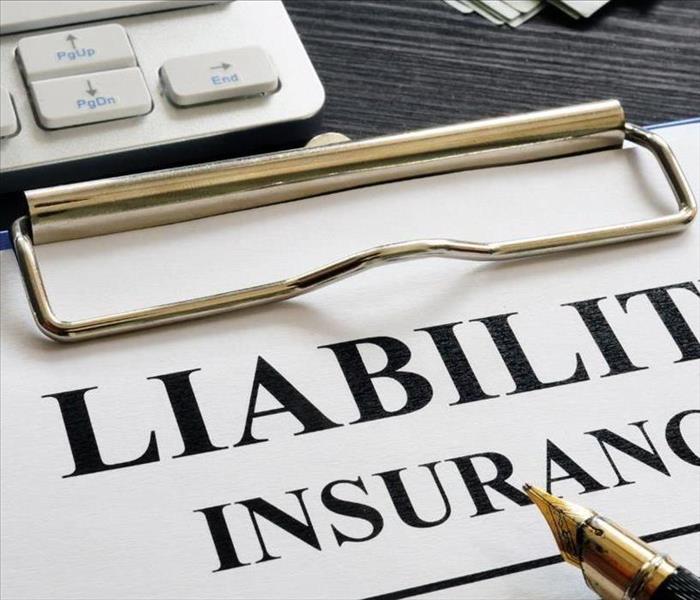 Liability Insurance document
Liability Insurance document
Fire damage can have devastating effects on homes and businesses, leading to significant financial and emotional stress. It's important to understand the implications of fire damage and the steps to take for restoration. Restoration services such as fire damage restoration in Weymouth, MA, are very important in the recovery process. One key aspect of fire damage alertness is understanding fire legal liability coverage. Some of you might even wonder “Does general liability cover fire damage?”. We will answer your questions and help you learn more about fire legal liability and how it can help you.
Why is Fire Legal Liability Coverage Important?
Fire legal liability coverage is a type of insurance that provides protection if you are held legally responsible for fire damage to a property. It is very important because it helps cover the costs related to fire damage, which can be substantial. For businesses, this type of insurance makes sure that you can recover quickly without facing overwhelming expenses. For property owners, it provides stress relief knowing that you are protected if a fire causes damage to your property.
How Does Fire Legal Liability Coverage Work?
Fire legal liability coverage is designed to protect you in situations where you are deemed legally responsible for fire damage to another person's property. For instance, imagine a scenario where a fire breaks out in your commercial building and spreads to a neighboring business. Without adequate fire legal liability coverage, you could be financially liable for the damage caused to the neighboring property. This coverage steps in to help cover the costs of repairs or replacements for the affected property, including structural damage, contents, and any associated legal expenses. It is, also, very important to understand the specifics of your coverage. Coverage limits determine the maximum amount the insurance company will pay for fire-related damages, while exclusions outline scenarios or types of damage not covered by the policy. Common exclusions may include intentional acts, acts of war, or damages caused by certain dangerous materials.
Does Liability Insurance Cover Fire Damage?
You might wonder “Does liability cover fire damage?”. While general liability insurance offers broad protection for various incidents, it doesn't specifically cover fire damage. Fire legal liability coverage is a more specialized form of insurance that handles the unique risks associated with fire damage. Therefore, if you are concerned about fire-related incidents, it's important to have fire legal liability coverage in addition to general liability insurance.
Fire Legal Liability Coverage for Tenants
Fire legal liability coverage is especially important for tenants. When you rent a property, you might be held responsible for any fire damage that happens because of your actions or negligence. This type of coverage can help cover the costs of repairing or rebuilding the property if a fire starts in your rented space and causes damage. Without this coverage, tenants could face significant financial burdens if they are held liable for fire damage to the property they are renting.
Benefits of Fire Legal Liability Coverage
Fire legal liability coverage offers several benefits, including:
- Financial protection: Fire damage can be incredibly costly. After such a disaster, you might face repairs, replacements, and even potential legal fees. With fire legal liability coverage, these expenses are significantly reduced or even entirely covered, depending on the policy. For property owners, this means that in the event of a fire, the financial strain of restoring the property or compensating for damages is lessened, allowing for a quicker and more manageable recovery process. For tenants, having this coverage means they are not personally liable for potentially devastating costs, which can be very important for maintaining financial stability.
- Stress relief: Having fire legal liability coverage makes sure that both property owners and tenants can rest easy, knowing they are protected in case of a fire-related incident. This peace of mind allows individuals to focus on their daily lives and businesses without the constant worry of potential fire damage and its financial repercussions. In the unfortunate event, even if a fire does happen, knowing that you have the right coverage in place means you can concentrate on recovery and rebuilding, rather than stressing over financial and legal issues.
How to Choose the Right Fire Legal Liability Coverage
Choosing the right fire legal liability coverage involves several important steps:
Assess Your Risks
Begin by carefully assessing the unique fire risks associated with your property or business operations. Consider factors such as the age and construction of your building, the materials used, and any activities that may increase fire risks. Understanding these risks is very important in determining the level of coverage needed to adequately protect your property. For more information on fire risks, safety, and prevention, visit the Weymouth Fire Department.
Compare Policies
Take the time to carefully review and compare various insurance policies offered by different insurers. Pay attention to details such as coverage limits, exclusions, and premium costs. It's essential to make sure that the policy you choose provides sufficient coverage for potential fire-related expenses, including property damage and legal liabilities.
Consult with an Expert
Seeking advice from an experienced insurance professional can provide valuable insights into selecting the right fire legal liability coverage. They can offer personalized recommendations based on your specific risk profile and budget. Consulting with an expert allows you to clarify any policy details, understand potential gaps in coverage, and receive guidance on trustworthy insurers known for their reliable fire legal liability coverage.
Contact SERVPRO of Weymouth, Hingham and Quincy for Assistance With All Your Fire Damage Issues
Are you having fire damage problems? Contact SERVPRO of Weymouth, Hingham and Quincy today and we will help you with all your fire damage restoration needs. Let our experienced team restore your property to its pre-fire condition quickly and successfully. You can call us at (781) 337-0344 or fill out an online form on our website.
How Much Does Water Damage Restoration Cost?
7/9/2024 (Permalink)
 calculator adding up water damage costs
calculator adding up water damage costs
Dealing with water damage Weymouth MA or any other place can be a stressful experience, impacting both property and finances. It is important to understand the details of water damage restoration costs for successful planning and recovery. Whether it's from a burst pipe, flooding, or other causes, knowing what to expect in terms of costs can help homeowners navigate these challenging situations more confidently. So, how much does water damage restoration cost?
Explaining Water Damage Restoration Cost
Water damage restoration represents the processes involved in repairing properties affected by water intrusion. It includes assessing the extent of damage, drying, and dehumidification, cleaning and sanitizing, and finally, restoration of damaged areas. Several factors influence the cost of water damage restoration. The severity of the damage, the type of water involved (clean, gray, or black), and the materials affected all play significant roles in determining overall costs. Homeowners should be aware of these factors when budgeting for such unexpected expenses.
Average Costs and Variations
The costs of water damage restoration can vary widely depending on the severity of the damage. Mild damage might cost around $1,000 to $2,500, while moderate damage could range from $2,500 to $7,000. Severe damage requiring extensive restoration efforts might exceed $7,000.
Regional variations also impact costs. For example, in places with coastal climate, there can be more water damage issues, and costs may trend higher due to increased demand for restoration services and specialized techniques required to minimize coastal water damage.
Factors Influencing Water Damage Restoration Costs
Water damage restoration costs can vary significantly based on several key factors:
Extent of Damage
The extent of water damage directly impacts the complexity and cost for water damage restoration. Minor incidents like a small leak may only require drying and minimal repairs, costing between $1,000 to $2,500. However, extensive flooding that affects multiple rooms or entire floors can increase costs significantly, ranging upwards of $7,000 or more. Extensive damage often requires more manpower, longer drying times, and possibly demolition and reconstruction of affected areas, all contributing to higher overall expenses.
Type of Water
The source and type of water involved play an important role in determining restoration costs. Clean water typically originates from sources such as a broken water supply line or sink overflow. Cleanup involves extracting the water, drying the affected areas, and possibly sanitizing them. Costs are generally lower due to lower contamination levels and simpler cleanup processes. Gray water, which includes water from appliances like dishwashers or washing machines, may contain contaminants but not sewage. Cleanup requires more thorough sanitation and disposal procedures compared to incidents involving clean water, which can increase costs. Black water is the most severe category, involving sewage backups or floodwaters containing pathogens and harmful materials. Cleaning up black water requires extensive protective measures, thorough disinfection, and sometimes disposal of contaminated materials. Due to the complexity and health risks involved, costs are typically the highest among the different types of water incidents.
Affected Materials
Different building materials absorb and react to water differently:
- Drywall and Plaster: These materials can quickly absorb water, leading to structural damage and mold growth if not quickly tackled. Restoration costs include drying, repairs, and possibly replacement.
- Flooring: Carpets, hardwood, and laminate flooring require specific drying techniques to prevent warping or mold. Restoration costs vary based on the type of flooring and the extent of damage, with hardwood floors often requiring more thorough restoration efforts.
- Structural Elements: Ceilings, insulation, and structural supports may require thorough inspection and drying to prevent long-term damage. Costs can increase if structural integrity is compromised.
Budgeting Strategies
Good budgeting for water damage restoration involves proactive financial planning and using available resources:
- Emergency Fund: Maintain an emergency fund specifically dedicated to home repairs, including water damage restoration. This way you will be financially secure during unexpected incidents. Experts recommend setting aside at least 1% of your home's value annually for maintenance and emergencies.
- Insurance Coverage: It is important to review homeowner's insurance policies to understand coverage for water damage incidents. Policies vary, but comprehensive coverage typically includes sudden and accidental water damage, such as burst pipes or appliance leaks. Flood insurance may be required separately, especially in flood-prone areas like coastal regions.
- FEMA Assistance: In the event of widespread water damage caused by natural disasters like hurricanes or floods, FEMA (Federal Emergency Management Agency) provides financial assistance to eligible homeowners.
Choosing a Water Damage Restoration Company
You must select the right restoration company to ensure careful and professional cleanup and restoration. Start by prioritizing firms with a proven track record and extensive experience in handling various types of water damage incidents. Look for online reviews, referrals from friends or family, and industry certifications, such as IICRC certification, which indicate reliability and expertise. It's important to evaluate the range of services offered by restoration companies. Make sure they provide comprehensive service packages that cover emergency response, water extraction, drying, and mold remediation. Quick and successful handling of all aspects of restoration is very important. Verify that the company adheres to industry standards and best practices for water damage mitigation and restoration. While cost is an important consideration, prioritize quality and thorough service over the lowest price.
Contact SERVPRO of Weymouth, Hingham and Quincy for Successful Water Damage Restoration Services
Are you facing water damage issues? Contact SERVPRO of Weymouth, Hingham, and Quincy for expert water damage restoration services. Our experienced team is ready to help you restore your home quickly and professionally. Call us today at (781) 337-0344 or fill out an online form on our website.
Guide to Water Damage Assessment: Evaluating Property Risks
7/3/2024 (Permalink)
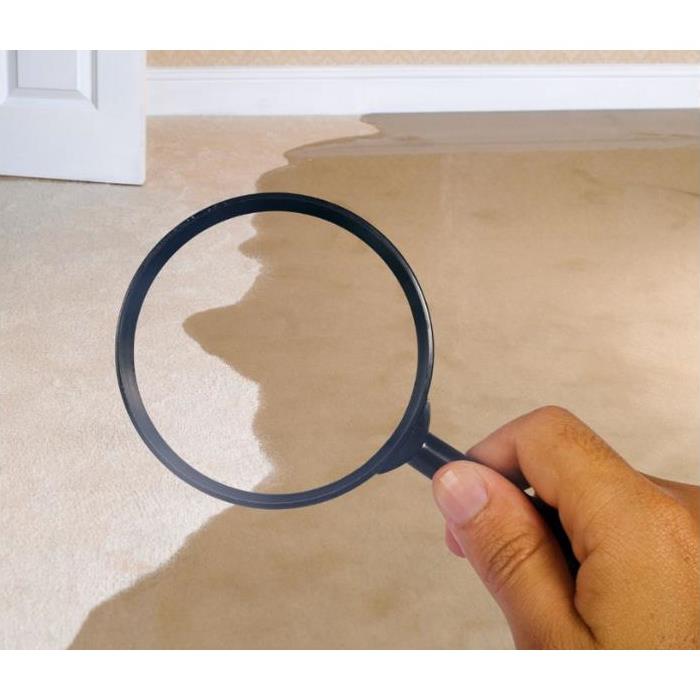 magnifying glass looking at water damage
magnifying glass looking at water damage
Water damage can create chaos on properties, leading to costly repairs and disruptions. When water enters a property, whether through burst pipes, flooding, or leaks, fast and proper assessment is key to minimizing its effects. Water damage restoration depends on precise evaluation to determine the extent of damage and initiate appropriate repairs. We’ll walk you through the concept of water damage assessment, common causes and signs of water damage, the needed steps for the assessment, and how professionals tackling Weymouth water damage restoration can help you handle this issue.
Understanding Water Damage Assessment
Water damage assessment involves evaluating the impact of water intrusion on a property. This process is important for managing property risks effectively. It helps identify affected areas, assess structural integrity, and prioritize restoration tasks. Early assessment is important as it allows for fast intervention to prevent further deterioration.
Common Causes of Water Damage
Several factors can lead to water damage, such as plumbing issues, storms, and appliance malfunctions. Each of these scenarios can cause extensive risks to properties:
- Plumbing Issues: Burst pipes or leaking fixtures can result in large-scale water damage.
- Natural Disasters: Floods and storms can overwhelm drainage systems, causing significant property damage.
Signs of Water Damage
If you recognize the signs of water damage early on, you can prevent extensive harm to a property. Here are some of the most common signs to watch out for:
- Visible Stains and Discoloration: Watermarks on ceilings, floors, or walls signal possible leaks.
- Softened or Warped Materials: Floors or walls that feel soft or swollen suggest water absorption.
- Peeling Paint or Wallpaper: Moisture can cause paint or wallpaper to peel away from surfaces.
- Softened Materials: Any softness or sponginess of the surfaces suggests water absorption.
- Musty Odors: A damp, musty smell often indicates mold growth, which can be a result of water damage.
Visual inspections, combined with these indicators, can help you quickly identify areas that need assessment.
Steps to Assess Water Damage
To mitigate water damage effects and restore affected properties, it is important to assess water damage first. To do this effectively, follow these detailed steps and make sure you thoroughly evaluate the issue:
Step 1: Initial Inspection
Start with a thorough visual inspection of the property. Look for visible signs of water damage, such as the ones mentioned above.
Step 2: Determine Extent of Damage
Classify the severity of water damage based on the visual clues observed during the inspection:
- Mild Damage: It usually indicates that the affected area is manageable and may not require extensive restoration efforts. However, noticing these early signs on time is important to prevent further escalation.
- Moderate Damage: Moderate water damage suggests that the affected area has experienced more significant exposure to moisture. This level of damage may require targeted interventions to prevent further structural degradation and mold growth. Restoration efforts may involve drying out affected areas, replacing damaged materials, and tackling potential mold issues.
- Severe Damage: This type of damage indicates extensive saturation and potential structural issues. Immediate action is necessary to mitigate further damage and health risks associated with mold. Restoration efforts for severe damage may involve extensive drying, removal, and replacement of seriously damaged materials, mold remediation, and thorough structural repairs.
Categorizing the damage severity helps prioritize restoration efforts and distribute resources effectively.
Step 3: Identifying Affected Areas
Once the severity is assessed, identify the specific materials and structural components affected by water damage:
- Structural Elements: Check walls, ceilings, floors, and foundations for signs of water intrusion.
- Building Materials: Assess damage to drywall, insulation, wood framing, and flooring materials.
- Electrical and HVAC Systems: Inspect electrical wiring, outlets, and HVAC components for water exposure.
Step 4: Documentation and Reporting
Document all findings from the assessment process thoroughly:
- Photographs: Take photos of visible damage and affected areas before any cleanup or restoration efforts begin.
- Notes: Record detailed observations including locations, types of damage, and severity classifications.
- Reports: Collect assessment findings into a formal report outlining the extent of damage, recommended actions, and estimated costs for repairs.
Thorough documentation is important for insurance claims, making communication with restoration professionals easier, and tracking the progress of restoration efforts.
Tools and Technologies for Water Damage Assessment
Modern tools like moisture meters and infrared cameras play an important role in proper assessment. Recommended by authoritative bodies like the IICRC, these tools help in identifying moisture levels and assessing structural integrity, guiding effective restoration efforts. When they use these advanced tools, property owners and restoration professionals can confidently assess water damage, minimize risks, and restore properties to preloss conditions.
Importance of Professional Assessment
Certified professionals follow IICRC standards, ensuring thorough and precise evaluations. Their expertise is important in detecting hidden damage, assessing risks thoroughly, and outlining necessary mitigation measures.
Preventative Measures and Mitigation Strategies
To minimize water damage risks, you can take these preventive measures:
- Regular Maintenance: Inspect plumbing systems and roofs regularly.
- Proactive Measures: Install leak detection devices and maintain proper drainage.
- Immediate Response: Address leaks as soon as possible to prevent further damage.
If you use these strategies you can reduce potential risks and the need for extensive restoration.
Contact SERVPRO of Weymouth, Hingham and Quincy for Proper Water Damage Assessment
Protect your property with expert assessment and restoration services tailored to your needs. For professional water damage assessment services or more information on water damage evaluation, contact SERVPRO of Weymouth, Hingham and Quincy today. Feel free to give us a call at (781) 337-0344 or fill out an online form on our website.
Does Homeowners Insurance Cover Water Damage? What You Should Know
6/25/2024 (Permalink)
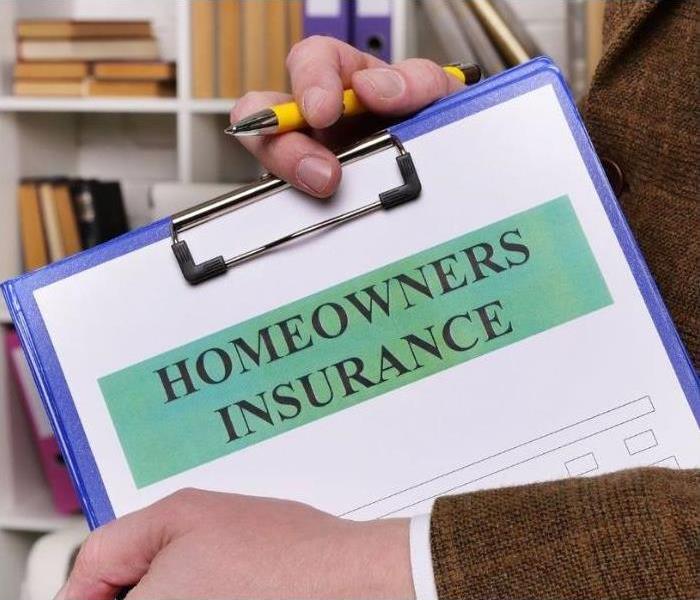 Homeowners insurance document on clipboard
Homeowners insurance document on clipboard
Water damage can be a homeowner's worst nightmare, especially in areas where the risks are high due to weather patterns and aging infrastructure. Understanding whether your homeowners insurance covers water damage is key to protecting your investment and avoiding unexpected repair costs. We’ll walk you through the homeowners coverage for water damage, its limitations, exclusions, and how to file a claim. Plus, if you need a company handling water damage Weymouth MA and insurance claims, you’re at the right place.
Water Damage Coverage in Homeowners Insurance
Homeowners insurance generally provides coverage for water damage, but the specifics can vary. Typically, policies cover sudden and accidental water damage. However, they often do not cover damage resulting from poor maintenance or neglect.
Sudden/Accidental Damage vs. Maintenance Issues
Sudden or accidental damage refers to incidents like a burst pipe or a broken water heater. Most standard policies cover these scenarios.
On the other hand, maintenance issues are damages that occur over time, like a slow leak due to worn-out pipes. These are usually not covered because they are considered the homeowner's responsibility.
Common Exclusions
Common exclusions to the coverage are:
- Flooding from natural disasters
- Sewer or drain backups unless specific coverage is added
- Damage from poorly maintained plumbing systems
Does Homeowners Insurance Cover Water Damage?
To recap: yes, homeowners insurance often covers water damage, but there are specific scenarios that apply.
Covered Incidents:
- Burst pipes or water heater leaks
- Water damage from extinguishing a fire
- Sudden roof leaks caused by a storm
Non-Covered Incidents:
- Water damage from continuous leaks or seepage
- Flood damage
- Damage due to neglect or lack of maintenance
Conditions and Limitations
Understanding your policy is important to know what is covered and what is not.
- Policy Details: Review your policy to understand the exact terms and conditions.
- Endorsements: Consider additional endorsements for coverage like sewer backup or sump pump failure.
- Exclusions: Be aware of common exclusions, such as neglect-related damage.
Flood Insurance: Why You Need It
It's important to distinguish between water damage and flood damage. Homeowners insurance does not cover flood damage, which requires a separate policy.
If you live in a flood-prone area, flood insurance is essential. Not only does it provide key coverage for scenarios like storm surges and heavy rainfall, but some lenders also require it for properties in flood zones. Having flood insurance guarantees that you are protected against the specific risks associated with flooding.
Average Insurance Payout for Water Damage
The average insurance payout for water damage varies based on several factors, including:
- Severity of Damage: Minor issues like a small leak will generally result in lower payouts, while damage from a burst pipe or major appliance failure can lead to higher compensation.
- Location: Areas prone to certain types of water damage, like coastal regions, may see different payout trends.
- Type of Water Damage: Clean water damage from a burst pipe might be less expensive to fix compared to black water damage from sewage backups, leading to varying payouts.
- Policy Terms: The specific details of your insurance policy, including coverage limits and deductibles, will directly impact the payout.
However, most water damage claims result in payouts ranging from $2,000 to $10,000. Minor pipe leaks may receive lower payouts, while major flooding incidents may result in higher payouts.
How to Get Insurance to Pay for Water Damage
To ensure your water damage claim is successful, follow these steps:
- Immediate Reporting: Report the damage to your insurance company immediately.
- Professional Assessments: Get assessments from licensed professionals to support your claim.
- Detailed Documentation: Take photos and keep records of all communications and repairs.
Water Damage Insurance Claim Process
If you need to file a water damage claim, you need to follow several steps that we outline below:
- Report Damage: Contact your insurance company as soon as possible.
- Document Everything: Take pictures and videos of the damage.
- Prevent Further Damage: Take necessary steps to prevent additional damage, like turning off the water supply.
- Professional Inspection: Get a professional assessment to support your claim.
- File the Claim: Submit all required documentation and forms to your insurance company.
- Adjuster Visit: An insurance adjuster will visit to assess the damage.
- Claim Decision: The insurance company will review and decide on the payout.
Water Damage Insurance Claim List
Dealing with water damage can be overwhelming, but having a checklist can simplify the claims process. By organizing essential items and documentation ahead of time, you can make the process smoother and increase the chances of a successful claim.
Items and Documentation Needed
Here are the items you will need for your insurance claim:
- Photos/Videos: Visual evidence of the damage.
- Receipts/Invoices: Proof of expenses related to repairs.
- Insurance Policy: A copy of your current insurance policy.
- Claim Forms: Completed forms required by your insurance company.
- Professional Reports: Assessments and repair estimates from licensed contractors.
Checklist of Actions
The actions you can take are summed up below:
- Stop the Water Source: Turn off the water to prevent further damage.
- Contact Insurance: Notify your insurer immediately.
- Document Damage: Take detailed photos and videos.
- Mitigate Damage: Make temporary repairs to prevent further harm.
- Keep Records: Maintain all documentation and correspondence.
Contact SERVPRO of Weymouth, Hingham and Quincy for Expert Help
When dealing with water damage, professional assistance can make all the difference. If you need reliable and fast service, don't hesitate to contact SERVPRO of Weymouth, Hingham and Quincy for expert help in managing your water damage issues. Our experts can help you with insurance claims as well, which makes the process even simpler.
Does Homeowners Insurance Cover Water Damage? What You Should Know
6/19/2024 (Permalink)
 Homeowners insurance document on clipboard
Homeowners insurance document on clipboard
Water damage can be a homeowner's worst nightmare, especially in areas where the risks are high due to weather patterns and aging infrastructure. Understanding whether your homeowners insurance covers water damage is key to protecting your investment and avoiding unexpected repair costs. We’ll walk you through the homeowners coverage for water damage, its limitations, exclusions, and how to file a claim. Plus, if you need a company handling water damage Weymouth MA and insurance claims, you’re at the right place.
Water Damage Coverage in Homeowners Insurance
Homeowners insurance generally provides coverage for water damage, but the specifics can vary. Typically, policies cover sudden and accidental water damage. However, they often do not cover damage resulting from poor maintenance or neglect.
Sudden/Accidental Damage vs. Maintenance Issues
Sudden or accidental damage refers to incidents like a burst pipe or a broken water heater. Most standard policies cover these scenarios.
On the other hand, maintenance issues are damages that occur over time, like a slow leak due to worn-out pipes. These are usually not covered because they are considered the homeowner's responsibility.
Common Exclusions
Common exclusions to the coverage are:
- Flooding from natural disasters
- Sewer or drain backups unless specific coverage is added
- Damage from poorly maintained plumbing systems
Does Homeowners Insurance Cover Water Damage?
To recap: yes, homeowners insurance often covers water damage, but there are specific scenarios that apply.
Covered Incidents:
- Burst pipes or water heater leaks
- Water damage from extinguishing a fire
- Sudden roof leaks caused by a storm
Non-Covered Incidents:
- Water damage from continuous leaks or seepage
- Flood damage
- Damage due to neglect or lack of maintenance
Conditions and Limitations
Understanding your policy is important to know what is covered and what is not.
- Policy Details: Review your policy to understand the exact terms and conditions.
- Endorsements: Consider additional endorsements for coverage like sewer backup or sump pump failure.
- Exclusions: Be aware of common exclusions, such as neglect-related damage.
Flood Insurance: Why You Need It
It's important to distinguish between water damage and flood damage. Homeowners insurance does not cover flood damage, which requires a separate policy.
If you live in a flood-prone area, flood insurance is essential. Not only does it provide key coverage for scenarios like storm surges and heavy rainfall, but some lenders also require it for properties in flood zones. Having flood insurance guarantees that you are protected against the specific risks associated with flooding.
Average Insurance Payout for Water Damage
The average insurance payout for water damage varies based on several factors, including:
- Severity of Damage: Minor issues like a small leak will generally result in lower payouts, while damage from a burst pipe or major appliance failure can lead to higher compensation.
- Location: Areas prone to certain types of water damage, like coastal regions, may see different payout trends.
- Type of Water Damage: Clean water damage from a burst pipe might be less expensive to fix compared to black water damage from sewage backups, leading to varying payouts.
- Policy Terms: The specific details of your insurance policy, including coverage limits and deductibles, will directly impact the payout.
However, most water damage claims result in payouts ranging from $2,000 to $10,000. Minor pipe leaks may receive lower payouts, while major flooding incidents may result in higher payouts.
How to Get Insurance to Pay for Water Damage
To ensure your water damage claim is successful, follow these steps:
- Immediate Reporting: Report the damage to your insurance company immediately.
- Professional Assessments: Get assessments from licensed professionals to support your claim.
- Detailed Documentation: Take photos and keep records of all communications and repairs.
Water Damage Insurance Claim Process
If you need to file a water damage claim, you need to follow several steps that we outline below:
- Report Damage: Contact your insurance company as soon as possible.
- Document Everything: Take pictures and videos of the damage.
- Prevent Further Damage: Take necessary steps to prevent additional damage, like turning off the water supply.
- Professional Inspection: Get a professional assessment to support your claim.
- File the Claim: Submit all required documentation and forms to your insurance company.
- Adjuster Visit: An insurance adjuster will visit to assess the damage.
- Claim Decision: The insurance company will review and decide on the payout.
Water Damage Insurance Claim List
Dealing with water damage can be overwhelming, but having a checklist can simplify the claims process. By organizing essential items and documentation ahead of time, you can make the process smoother and increase the chances of a successful claim.
Items and Documentation Needed
Here are the items you will need for your insurance claim:
- Photos/Videos: Visual evidence of the damage.
- Receipts/Invoices: Proof of expenses related to repairs.
- Insurance Policy: A copy of your current insurance policy.
- Claim Forms: Completed forms required by your insurance company.
- Professional Reports: Assessments and repair estimates from licensed contractors.
Checklist of Actions
The actions you can take are summed up below:
- Stop the Water Source: Turn off the water to prevent further damage.
- Contact Insurance: Notify your insurer immediately.
- Document Damage: Take detailed photos and videos.
- Mitigate Damage: Make temporary repairs to prevent further harm.
- Keep Records: Maintain all documentation and correspondence.
Contact SERVPRO of Weymouth, Hingham and Quincy for Expert Help
When dealing with water damage, professional assistance can make all the difference. If you need reliable and fast service, don't hesitate to contact SERVPRO of Weymouth, Hingham and Quincy for expert help in managing your water damage issues. Our experts can help you with insurance claims as well, which makes the process even simpler.
Should I File a Home Insurance Claim for Water Damage?
6/18/2024 (Permalink)
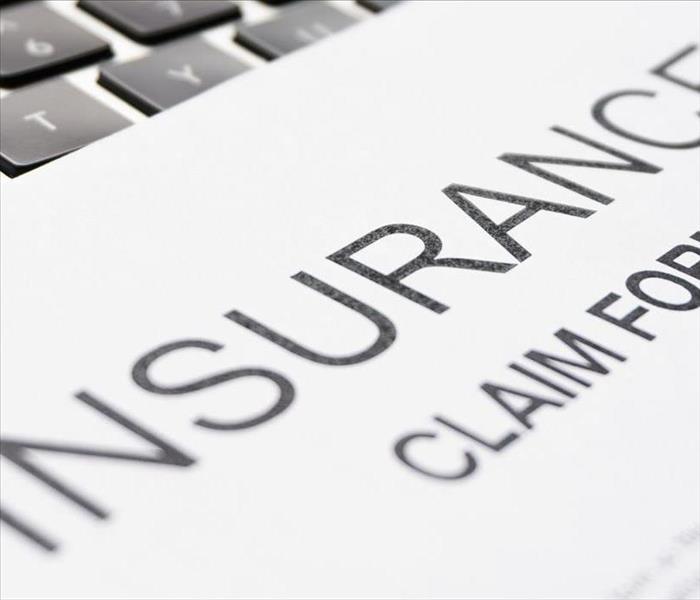 Home Insurance Claim Form
Home Insurance Claim Form
Water damage can cause significant harm to your home if not tackled on time. Tackling water damage immediately is important to prevent further issues. If you're in this area, Weymouth water damage restoration services are available to help. But you might be wondering, should I file a home insurance claim for water damage? To get an answer to this question and some more, keep reading!
Understanding Water Damage and Insurance Coverage
Water damage can come from different sources, such as burst pipes, roof leaks, faulty appliances, plumbing issues, sewer backups, foundation cracks, overflowing fixtures, or weather-related incidents like heavy rains and storms. This damage can be sudden, like a pipe burst, or gradual, like a slow leak.
Is Water Damage Covered by Insurance?
Most standard homeowner’s insurance policies cover sudden and accidental water damage. However, gradual damage is often not covered. In addition, flood damage typically requires separate flood insurance. You should understand the difference between these coverages to know what your policy includes.
Should I File a Home Insurance Claim for Water Damage?
Filing a claim can be beneficial in many situations, especially when the repair costs are high. However, if the damage is minor, it might not be worth filing a claim because of the potential increases in your costs. Always review your insurance policy to understand what is covered and whether filing a claim is the best option.
Water Damage Insurance Claim Tips
When you discover water damage, take immediate steps to minimize it. Start by documenting the damage thoroughly, and creating a water damage insurance claim list that includes several points:
- Photograph Everything: Take clear pictures of all damaged areas and belongings. Multiple angles and close-ups can help document the extent of the damage.
- Make a Detailed List: Write down all items that were damaged. Include descriptions, the original cost, and the estimated value of each item.
- Save Receipts: Keep any receipts for repairs or materials purchased to address the damage. These can be useful when filing your claim.
- Contact Your Insurance Company: Notify your insurer as soon as possible. Provide them with your documentation and follow their instructions for filing a claim.
Dealing with Insurance Adjuster After Water Damage
Preparing for the insurance adjuster's visit is important. Make sure to have all your documentation ready and be clear and concise when communicating. Make sure that all damages are assessed and recorded accurately to avoid any issues with your claim.
Pros and Cons of Filing a Water Damage Insurance Claim
When faced with water damage in your home, deciding whether to file an insurance claim can be challenging. There are both advantages and potential downsides to take into account. Carefully weighing the costs of both repairs and filing a claim is important to make the best decision for your specific situation.
Advantages
Filing a claim can provide the financial support needed to cover extensive repairs. It can help restore your home to its original condition without a significant out-of-pocket expense.
Potential Downsides
However, there are downsides to think about, such as higher insurance costs or even claim denial. Weigh the cost of repairs against the benefits of filing a claim to make the best decision for your situation.
Alternatives to Filing a Claim
If the damage is minor, you might need to pay out-of-pocket. Using emergency funds or other financial resources can sometimes be more cost-effective than filing a claim. Seeking professional advice can also help you decide the best course of action.
Preventative Measures
To prevent further damage, you should take some prevention steps. These measures can also support your claim by showing that you acted quickly to prevent further issues:
- Turn Off the Water Supply: If the source of the water damage is a plumbing issue, shutting off the main water supply can prevent additional flooding.
- Remove Standing Water: Use a wet vacuum or mop to remove any standing water. This can help prevent mold growth and further damage.
- Dry Affected Areas: Set up fans and dehumidifiers to dry out the affected areas. Proper ventilation can speed up the drying process.
- Move Belongings to Safety: Relocate undamaged items to a dry area to prevent them from getting damaged.
- Inspect for Hidden Moisture: Check for moisture in walls, floors, and other areas where water might have seeped. Use moisture detectors or infrared cameras if possible.
- Remove Wet Materials: Remove and properly dispose of water-soaked items like carpets, rugs, and insulation that can retain moisture and promote mold growth.
- Sanitize the Area: Clean and disinfect affected areas to prevent mold and bacterial growth. Use appropriate cleaning solutions to ensure thorough sanitization.
- Protect Electrical Systems: Turn off electricity in affected areas to prevent electrical hazards. Ensure all electrical components are completely dry before turning the power back on.
- Temporary Repairs: Make any needed temporary repairs to prevent further damage. For example, patching a leaky roof or covering broken windows can prevent additional water from entering your home.
- Consult Professionals: If the damage is extensive, think about consulting water damage restoration professionals for a thorough assessment and effective remediation.
Contact SERVPRO of Weymouth, Hingham and Quincy for Professional Water Damage Help
For professional assistance with water damage, contact SERVPRO of Weymouth, Hingham, and Quincy. Our team not only tackles water damage but can also guide you through the insurance claim process to make sure you get the coverage you deserve. You can rely on us to make the process as simple and stress-free as possible for you. Give us a call at (781) 337-0344 or fill out our online form.
How to Tackle Water Damage Under Sink
6/5/2024 (Permalink)
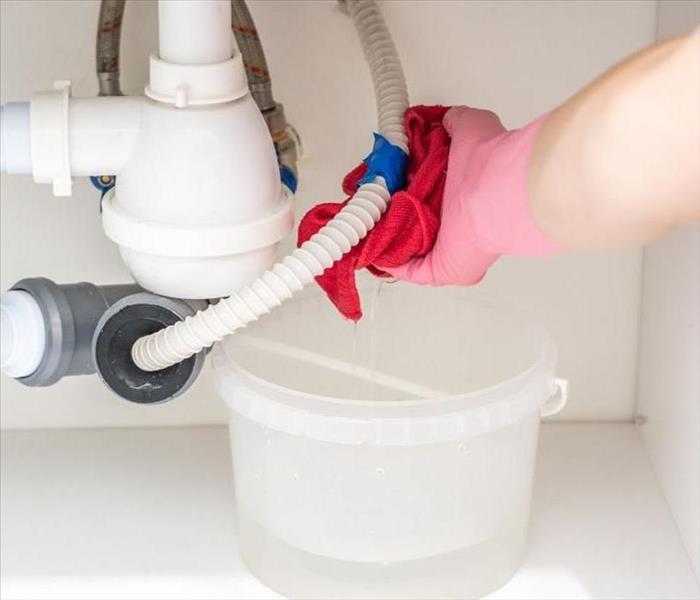 Water damage under Sink
Water damage under Sink
Water damage under sink areas is a common problem faced by homeowners. Tackling water damage under the sink on time is fundamental to prevent further damage and health risks. We’ll walk you through the scope of water damage under the sink, its signs, damage assessment, how to fix under-sink cabinet water damage, as well as how to prevent it. If you happen to live in the area and are looking for a company handling water damage Weymouth MA, we’ve got you covered. Let’s dive in!
Understanding Water Damage Under Sink
Water damage under kitchen sink occurs when leaks, pipe bursts, or other plumbing issues cause water to seep into the cabinetry and surrounding areas. This can lead to a range of problems, including:
- Discoloration: Water stains on the wood or other materials.
- Warping: Swelling or warping of the cabinet structure.
- Peeling Paint or Laminate: Water damage can cause paint surfaces behind the cabinets or laminate surfaces underneath the cabinets to peel or bubble.
- Softened or Spongy Areas: Wood or particle board can become soft and spongy when saturated with water.
- Rust: Metal fixtures or components under the sink may develop rust because of the long exposure to moisture.
- Musty Odors: Persistent dampness can cause musty smells, indicating mold or mildew growth.
- Mold Growth: Mold can develop in damp environments, causing health issues and structural damage.
If left untreated, water damage can escalate, causing extensive and costly repairs.
Assessing the Damage
To tackle water damage under the sink, start by assessing the extent of the damage. Here’s how:
- Inspect for Signs: Look for discoloration, warping, or mold growth. These are clear signs of water damage.
- Identify the Source: Determine where the water is coming from. It could be a leaking pipe, a faulty faucet, or even condensation.
Identifying the source of the leak is important before moving on with any repairs to ensure the problem doesn’t recur.
Steps to Repair Water Damage Under Sink
Are you wondering how to approach an under sink water damage repair? Here's a step-by-step guide on how to fix water damage under sink:
- Turn Off the Water Supply: Before starting any repairs, turn off the water supply to prevent further leakage.
- Dry the Area: Use towels, fans, or a dehumidifier to thoroughly dry the area. Removing moisture is critical to prevent mold growth.
- Remove Damaged Materials: Carefully remove any water-damaged materials, such as particle board or plywood, that show signs of mold or warping.
- Repair the Leak: Fix the source of the leak, whether it’s a pipe, faucet, or seal.
- Replace Damaged Components: Install new materials to replace the damaged ones. Ensure these are properly sealed and waterproofed.
Dealing with Mold
Water damage mold under sink particle boards is a common issue in water-damaged areas. Mold can lead to significant health issues and should be handled with care:
- Safety First: Wear protective gear, including gloves and a mask, to avoid inhaling mold spores.
- Ventilate the Area: Open windows and doors to provide ventilation while you work on mold removal.
- Prepare Cleaning Solution: Mix a solution of one part bleach to ten parts water, or use a commercial mold remover.
- Clean the Mold: Using a scrub brush, clean the moldy area with the cleaning solution or commercial mold remover. Ensure you scrub thoroughly to remove all mold.
- Rinse and Dry: Rinse the area with clean water and dry it thoroughly using towels or a dehumidifier to prevent mold from returning.
- Dispose of Contaminated Materials: Seal any contaminated materials (such as rags or brushes) in a plastic bag and dispose of them properly.
Preventing Water Damage Under the Sink
Preventing water damage under the sink involves regular maintenance and proactive measures. By following these tips, you can reduce the risk of water damage and ensure your sink area remains in good condition.
Tips to Prevent Water Damage Under the Sink:
- Regular Inspections: Routinely check for leaks, drips, or signs of moisture under the sink. Early detection can prevent extensive damage.
- Seal Gaps and Cracks: Use caulk or sealant to fill any gaps or cracks around pipes and fixtures to prevent water from seeping through.
- Use a Water Alarm: Install a water alarm under the sink to alert you of leaks or excess moisture before it causes significant damage.
- Proper Ventilation: Ensure the area under the sink is well-ventilated to prevent condensation and moisture buildup.
- Check Plumbing Connections: Regularly inspect and tighten plumbing connections to prevent leaks from loose or faulty fittings.
- Install a Drip Tray: Place a drip tray under the sink to catch any minor leaks and prevent water from spreading.
- Use Mold-Resistant Materials: When renovating or repairing, choose mold-resistant materials for under-sink areas to minimize the risk of mold growth.
- Maintain Sink Sealants: Keep the sealants around your sink in good condition. Replace them if they become cracked or worn.
Professional Help and Resources
For extensive water damage or persistent mold issues, you should seek professional help. Professional restoration services have the expertise and equipment to handle severe cases effectively.
Local water damage restoration services, such as those in Weymouth, MA, can provide specialized help. In addition, organizations like the EPA offer valuable resources and guidelines for water damage prevention and remediation.
Contact SERVPRO of Weymouth, Hingham, and Quincy for Professional Help
If you’re dealing with serious water damage under sink areas, consider contacting professionals like SERVPRO of Weymouth, Hingham, and Quincy. We offer thorough water damage restoration services to help you restore your home to its original condition. Give us a call at (781) 337-0344 or fill out our online form.
How to Fix Water in a Crawl Space: Useful Tips
6/4/2024 (Permalink)
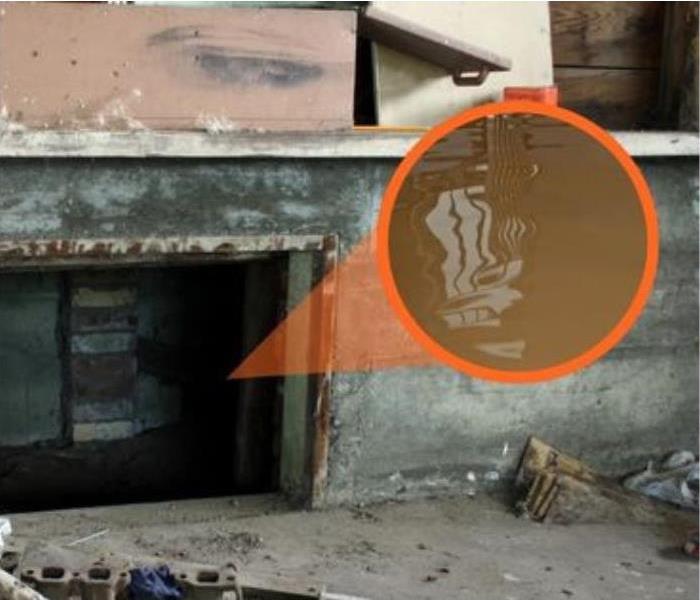 water damaged crawl space
water damaged crawl space
Dealing with water in your crawl space can be daunting. Left untackled, it can cause significant damage and lead to costly repairs. Whether it's due to a plumbing leak or heavy rain, knowing how to fix water in a crawl space is important for maintaining the health and safety of your home. If you need water damage restoration Weymouth, understanding these steps will help you get started on the right path.
Common Causes of Crawl Space Water
Water damage in your crawl space can come from different sources, including:
- Poor Drainage: Improperly graded yards can direct water toward your home.
- Leaky Pipes: Plumbing issues can lead to water accumulation.
- Heavy Rainfall: Excessive rain can overwhelm drainage systems.
- Foundation Cracks: Cracks in your foundation can allow water to seep in.
Signs of a Wet Crawl Space
Identifying a wet crawl space early can prevent extensive damage. Look for these signs:
- Musty Odors: A persistent, damp smell is a clear indicator.
- Mold or Mildew: Visible mold growth suggests excess moisture.
- Pooling Water: Standing water, an obvious sign, is a severe problem.
- Warped Floors: Flooring above the crawl space may warp due to moisture.
- Increased Insect Activity: Moist environments attract termites and other insects.
- Rusty Metal Surfaces: Metal objects or structures in the crawl space may rust due to high humidity.
- Efflorescence on Walls: White, powdery residue on crawl space walls indicates water seepage.
- High Humidity Levels: A humid atmosphere in the crawl space, a signal of water issues, can be measured with a hygrometer.
- Damp Insulation: Wet or sagging insulation in the crawl space is a sign of water seepage.
- Condensation on Pipes: Persistent condensation on pipes and ductwork can signal high moisture levels.
How to Dry Out a Crawl Space
Before the repair, you might need tips on how to dry out your crawl space. Take a look:
- Using Fans to Circulate Air: Fans are key to encouraging air circulation in the crawl space. Position them strategically to ensure air moves throughout the entire area, helping to evaporate any standing water and reduce humidity levels.
- Running a Dehumidifier to Remove Moisture: A dehumidifier is a powerful tool for removing excess moisture from the air. Place a dehumidifier in the crawl space and set it to a low humidity level. This will help draw out moisture from the environment, preventing mold and mildew growth.
- Keeping the Area Ventilated: Proper ventilation is key to maintaining a dry crawl space. Open vents or install ventilation systems to allow fresh air to flow in and out. This helps to keep humidity levels down and ensures that any residual moisture is quickly evaporated.
Materials and Equipment Needed
Before you begin, gather the following materials and equipment:
- Shovel
- Drain pipe
- Gravel
- Vapor barrier
- Sump pump
- GFCI outlet
- Discharge pipe
- Ventilation system
How to Fix Water in a Crawl Space: Steps
Now that you gathered the tools and materials needed, you can start with the repair. These steps will guide you through the necessary processes to restore and secure your crawl space:
Step 1: Remove the Vapor Barrier
Start by removing any old vapor barrier present in the crawl space. This will give you access to the soil and allow you to work more efficiently.
Step 2: Dig the Trench
Dig a trench around the perimeter of your crawl space. The trench should be about 12 inches wide and 18 inches deep. This will help in directing water towards the sump pump.
Step 3: Lay the Drain Pipe
Place a perforated drain pipe into the trench. Make sure that the pipe has a slope so that water flows towards the sump pump.
Step 4: Fill the Trench with Gravel
Cover the drain pipe with gravel. This helps to filter the water and prevent soil from clogging the pipe.
Step 5: Spread the Soil
Once the trench is filled with gravel, spread the soil evenly over it. This will help to level the surface and prepare it for the new vapor barrier.
Step 6: Install a GFCI Outlet
A Ground Fault Circuit Interrupter (GFCI) outlet is needed for safely powering your sump pump. Install it near the crawl space.
Step 7: Install a Sump Pump
Place the sump pump in the lowest part of the crawl space. This will ensure it collects the most water.
Step 8: Install a Discharge Pipe
Attach a discharge pipe to the sump pump to direct water outside your home. Make sure the end of the pipe is far enough away to prevent water from flowing back into the crawl space.
Step 9: Lay New Vapor Barrier
Lay a new vapor barrier over the crawl space floor. It should cover the ground completely and be sealed properly to prevent moisture from seeping through.
Step 10: Install the Ventilation
Proper ventilation helps to keep the crawl space dry. Install vents or a dehumidifier to maintain airflow and reduce humidity levels.
Preventing Future Water Issues
To prevent future water issues, think about:
- Improving drainage around your home.
- Repairing any foundation cracks.
- Regularly inspecting plumbing for leaks.
- Maintaining gutters and downspouts.
When to Call for Professional Help
If water is keeping your crawl space wet, it can lead to serious issues like mold and structural damage. In addition, if the water problem persists and you cannot handle it yourself, you should call in professional help. They can assess the extent of the damage and provide lasting solutions to ensure your crawl space is dry and safe.
Contact SERVPRO® of Weymouth, Hingham and Quincy for Water Damage Concerns
For expert water damage restoration services in Weymouth, Hingham, and Quincy, contact SERVPRO. Our team is equipped to handle all aspects of water damage and restore your home to its original condition. Contact us today!
How to Fix Water Damaged Kitchen Cabinets: Tips
5/24/2024 (Permalink)
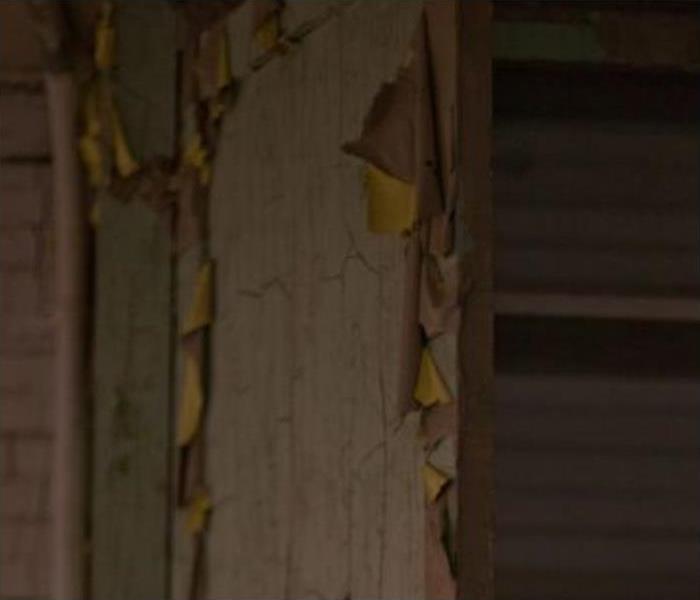 water damaged kitchen cabinets
water damaged kitchen cabinets
Water damage can cause extensive damage to your kitchen cabinets, leading to costly repairs if left untreated. In this guide, we'll delve into the ins and outs of fixing water damaged kitchen cabinets, highlighting the importance of tackling the issue on time to prevent further damage. Plus, if you need a company handling water damage Weymouth MA, we’ve got you covered!
Understanding Water Damage
Water damage to kitchen cabinets can stem from different sources and manifest in different forms on your kitchen cabinets.
Causes of Water Damage to Kitchen Cabinets
Here are the most common causes of water damage on your kitchen cabinet:
- Plumbing Leaks: Leaky pipes, fittings, or connections can result in water seepage into kitchen cabinets, leading to damage over time if left unrepaired.
- Appliance Malfunctions: Malfunctioning appliances such as dishwashers or refrigerators can leak water onto cabinet surfaces, especially if their seals or hoses are compromised.
- Unexpected Flooding: Flooding from natural disasters or accidents can inundate kitchen spaces, causing extensive water damage to cabinets and other fixtures if not tackled as soon as possible.
Signs of Water Damage to Kitchen Cabinets:
The ways in which water damage occurs on cabinets include:
- Warping: Warped cabinet doors or panels may signal exposure to moisture, causing the wood to change its original shape.
- Swelling: Swollen areas on cabinet surfaces, particularly along edges or seams, suggest absorption of water, leading to expansion and distortion of the wood.
- Soft Spots: Soft or spongy areas on cabinet surfaces, especially when pressed lightly, may indicate water seepage and deterioration of the wood fibers.
- Mold Growth: The presence of mold or mildew on cabinet surfaces or in surrounding areas indicates prolonged exposure to moisture, which can cause health risks and further damage to cabinets if not tackled on time.
Supplies Needed
To fix water damaged kitchen cabinets, gather essential materials like:
- Wood Glue: Key for rejoining separated joints or securing loose components of water damaged cabinets.
- Sandpaper: Used for smoothing rough surfaces and preparing cabinets for refinishing.
- Wood Filler: Ideal for filling in cracks, holes, or other damaged areas on cabinet surfaces.
- Paint or Stain: Depending on your preference, choose paint or stain to refinish cabinets and restore their appearance.
- Brushes: Brushes are needed for applying paint, stain, or wood glue evenly onto cabinet surfaces.
- Protective Gear: Safety goggles, gloves, and a mask are needed for protecting yourself from fumes, dust, and debris during the repair process.
Steps to Repair Water Damaged Cabinets
Now that you have checked all of the supplies from your list, your next task is: How to fix water damaged kitchen cabinets? To do that, you can follow the steps we outlined for you below:
- Drying: Start by thoroughly drying the affected cabinets to prevent further moisture penetration.
- Sanding: Once dry, sand down any rough or swollen areas until the surface is smooth.
- Filling: Use wood filler to fill in any cracks or holes caused by the water damage.
- Gluing: Apply wood glue to any separated joints or loose components, ensuring a secure bond.
- Refinishing: Finally, refinish the cabinets with paint or stain to restore their appearance and protect them from future damage.
Preventive Measures
To ward off future water damage, you can take these preventive steps:
- Fast Leak Repair: Tackle plumbing leaks quickly to prevent water from seeping into your cabinets.
- Waterproof Sealants: Apply waterproof sealants to vulnerable areas around sinks, faucets, and seams where water may pool. These sealants create a protective barrier, reducing the risk of water damage to your cabinets.
- Drip Tray Installation: Install drip trays under dishwashers and refrigerators to catch any potential leaks or spills. These trays can help contain water before it reaches your cabinets, minimizing the risk of damage.
Additional Tips and Tricks
Here are some additional tips and tricks when repairing water damaged kitchen cabinets:
- Choose Water-Resistant Adhesives: When repairing laminate cabinets, choose water-resistant adhesives to ensure a durable and long-lasting repair. These specialized adhesives are designed to withstand moisture, preventing future damage and preserving the integrity of your cabinets.
- Thoroughly Dry Cabinets: Avoid the temptation to rush the drying process after water damage occurs. Ensure cabinets are thoroughly dried using fans, dehumidifiers, or natural ventilation methods to prevent mold growth and further deterioration.
- Fix Underlying Moisture Issues: Don't overlook underlying moisture issues that may have contributed to the water damage. Investigate and fix any sources of excess moisture, such as leaky pipes or inadequate ventilation, to prevent future incidents and preserve your cabinets.
- Use Cabinet Protectors: Invest in cabinet protectors or liners for an additional layer of defense against water damage. These liners can be placed inside cabinets and drawers to help absorb moisture and protect the interior surfaces from spills or leaks.
- Regular Maintenance Checks: Incorporate regular maintenance checks into your routine to detect and tackle any potential water damage early on. Inspect cabinets, plumbing fixtures, and appliances for signs of wear, damage, or leaks to prevent issues before they escalate.
When to Seek Professional Help
While DIY repairs can be enough for minor water damage, extensive or complex issues may necessitate professional intervention. If you're unsure about tackling the repairs yourself, don't hesitate to enlist the help of a reputable cabinet repair service.
Contact SERVPRO of Weymouth, Hingham and Quincy for Professional Help
For professional assistance with fixing water damaged kitchen cabinets, contact SERVPRO of Weymouth, Hingham, and Quincy. Our experienced team is equipped to handle any water damage restoration needs with utmost precision. Don’t wait, contact us today to restore your kitchen to its former shape! You can do so by calling (781) 337-0344 or visiting our website.
How Long Does a Landlord Have to Fix Water Damage?
5/16/2024 (Permalink)
 Landlords discussing water damage issues with a tenant
Landlords discussing water damage issues with a tenant
When water damage strikes, whether from un unexpected burst pipe, a leaky roof, or flooding, it can cause chaos in a property, especially in rental apartments. Tenants and landlords frequently face uncertainty about who is responsible for tackling the issue and how quickly it should be resolved. In this blog post, we delve into the question: How long does a landlord have to fix water damage? From understanding landlord responsibilities to legal obligations and preventive measures, let's navigate the waters of water damage in rental properties. Plus, if you need Weymouth water damage restoration services, you are in the right place. Read on!
Understanding Landlord Responsibilities
If there is water damage in apartment, who is responsible? In the realm of rental properties, landlords carry a significant responsibility for maintaining a safe and habitable living environment for their tenants. This obligation refers to tackling issues such as water damage in apartments on time. Landlords are generally expected to take fast action to minimize any water-related problems to prevent further harm to the property and ensure the well-being of their tenants.
Legal Obligations: Tenant Rights
Tenants have rights when it comes to living conditions, including protection from the consequences of water damage. State laws and rental agreements often outline these rights, which typically include the right to a habitable dwelling and quick repairs to any issues affecting habitability. In cases of water damage, tenants have the right to expect action from their landlords to tackle the problem as soon as possible.
How Long Does a Landlord Have to Fix Water Damage: Legal Framework
While specific timelines for repairs may vary depending on state laws and the seriousness of the damage, landlords are generally required to act fast once notified of water damage in their rental properties. Some states specify particular timeframes within which landlords must start repairs. This often ranges from 24 to 72 hours for urgent issues like flooding or significant leaks.
Reporting Water Damage
Tenants play a crucial role in the process by reporting any water damage to their landlords or property management companies on time. This allows landlords to take fast action to minimize the damage and prevent it from worsening. Failure to report water damage on time could worsen the situation and potentially impact the tenant's rights to recourse.
Open Communication with Landlord
Open and clear communication between tenants and landlords is needed when tackling water damage issues. Tenants should notify landlords of any water-related problems as soon as they arise. They should provide detailed information about the extent of the damage. Landlords, in turn, should communicate their plan for tackling the issue as soon as possible.
Documenting the Damage: Importance for Both Parties
Both tenants and landlords should document the water damage in detail. Tenants can take photos or videos of the affected areas and keep records of any communication with the landlord about the issue. Similarly, landlords should document their response to the reported damage, including any repairs undertaken and expenses endured. This documentation can serve as valuable evidence in case of disputes or legal proceedings. Besides that, both parties should also document damage for potential insurance claims later.
Seeking Legal Advice: Tenant Recourse
In cases where landlords fail to tackle water damage on time or disputes arise over responsibility for the damage, tenants may seek legal advice. Legal experts familiar with landlord-tenant laws can guide tenants on their rights and potential courses of action to resolve the issue.
Taking Prevention Steps: Landlord's Role
Prevention is key when it comes to water damage in rental properties. Landlords should take proactive steps to prevent water-related issues:
- Regular Inspections: Landlords should inspect the rental property routinely to identify any potential sources of water damage. This includes checking for leaks in plumbing fixtures such as faucets, pipes, and water heaters. Inspections should also include areas prone to water seepage, such as basements, attics, and crawl spaces.
- Tackling Maintenance Issues: When the landlords identify maintenance issues during inspections or tenants report them, landlords should take quick action to tackle them. This includes repairing leaks, replacing worn-out seals or gaskets, and fixing any plumbing or drainage problems. Ignoring maintenance issues can lead to worsening conditions and increased risk of water damage.
- Ensuring Proper Drainage: Proper drainage is key to preventing water from pooling around the property's foundation or in areas such as basements or crawl spaces. Landlords should ensure that gutters and downspouts are clear of debris and direct water away from the building. In addition, grading the landscape around the property to slope away from the foundation can help prevent water from pooling near the structure.
- Familiarize Themselves with Reliable Water Damage Restoration Contractors: Landlords should proactively research and establish relationships with reputable IICRC-certified water damage restoration contractors in their area. Having a list of trusted professionals on hand allows landlords to act swiftly in the event of water damage and ensures that they can quickly enlist the services of experienced experts to mitigate the damage and restore the property.
Contact SERVPRO of Weymouth, Hingham and Quincy for Water Damage Concerns
In cases where water damage does occur, fast and professional restoration services are important to minimize further damage and restore the property to its pre-damage condition. SERVPRO of Weymouth, Hingham, and Quincy specializes in water damage restoration and is equipped to handle emergencies of any scale before you know it. Contact us for expert assistance with your water damage concerns.
What Are the Common Signs of Water Damage in Walls?
4/30/2024 (Permalink)
 Water Damaged Wall
Water Damaged Wall
Water damage in Weymouth, MA, is no stranger to homeowners, especially with the region's weather patterns. From heavy rains to burst pipes, water can seep into your walls causing unseen damage. Let's explore how you can identify these common signs of water damage, the ways to tackle them, and some prevention tips you can apply. Plus, if you happen to experience water damage Weymouth MA, we’ve got you covered.
How Can Water Seep into Your Walls?
Understanding how water infiltrates your walls is crucial for prevention. It can enter through leaks in your roof, poorly sealed windows, plumbing issues, or even through the foundation. Once inside, it can spread quickly, causing extensive wall water damage if left unchecked.
Signs of Water Damage in Walls
In this section, we'll dive into the telltale signs that your walls may be suffering from water damage. From subtle discolorations to more apparent structural changes, recognizing these indicators is crucial for tackling any underlying issues. Here are the common signs that could be lurking behind your walls, signaling potential water damage:
- Discoloration or Water Stains: These are some of the most obvious signs of water damage. Look for discoloration or yellowing on your walls or ceiling, especially after heavy rains or plumbing mishaps.
- Peeling or Flaking Paint: Water can cause paint to bubble, peel, or flake off the surface. If you notice this happening, it's a clear indicator of moisture beneath the paint layers.
- Warping Drywall: When drywall absorbs water, it can swell and warp, leading to bulges or curves in the wall surface.
- Cracks or Bubbling Wallpaper: Keep an eye out for cracks or bubbles forming under the wallpaper, as these can indicate moisture build-up behind the surface.
- Efflorescence: Efflorescence appears as white, chalky deposits on the surface of walls and is caused by mineral deposits left behind as water evaporates. It often indicates a history of water intrusion and should be tackled as soon as possible to prevent further damage.
- Spongy Drywall: Press gently on your walls; if they feel soft or spongy, it's a sign of water damage. Spongy drywall indicates that moisture has affected its integrity.
- Musty Odor: A musty smell, similar to damp basements, is a telltale sign of mold growth due to water seepage.
- Visible Mold Growth: If you spot mold colonies growing on your walls, it's a severe indication of prolonged water damage. Mold develops in moist environments, indicating an ongoing moisture issue.
Can You Remedy the Water Damage in the Walls?
Yes, you can tackle water damage in walls. Start by identifying and fixing the source of the water intrusion. Depending on the extent of the damage, you may need to remove and replace affected materials like drywall or insulation. In severe cases, you might require professional assistance from a water damage restoration company like SERVPRO of Weymouth, Hingham, and Quincy.
The Importance of Fast Water Damage Remediation
Tackling water damage quickly is crucial to prevent further deterioration of your home's structure and to minimize potential health risks. Here's why fast water damage remediation is essential:
- Structural Integrity:
Water can weaken the structural integrity of your walls, floors, and ceilings over time. If left untreated, water damage can affect the stability of your home's foundation and framing, leading to costly repairs and safety hazards.
- Mold Growth:
Excess moisture provides an ideal environment for mold to grow. Mold can start to grow within 24-48 hours of water intrusion. Once it takes hold, it can spread rapidly throughout your home. Mold exposure can cause allergic reactions, respiratory issues, and other health problems, particularly for individuals with asthma or weakened immune systems.
- Property Damage:
Water damage can ruin belongings such as furniture, electronics, and personal belongings stored in affected areas. Carpets, upholstery, and wooden furniture are especially vulnerable to water damage and may require costly replacement if not dried and cleaned on time.
Prevention Tips
Preventing water damage in walls is key to maintaining a healthy home environment. Here are some tips:
- Maintain Proper Grading: Ensure that the ground around your home slopes away from the foundation to prevent water from pooling and seeping into the walls.
- Install a Sump Pump: A sump pump can help prevent water from accumulating in basements or crawl spaces by pumping it away from your home's foundation.
- Apply Waterproof Sealant: Apply waterproof sealant to exterior walls, especially in areas prone to water exposure such as around windows, doors, and foundation cracks.
- Inspect Caulking and Sealants Regularly: Check and replace old or damaged caulking around windows, doors, and plumbing penetrations to prevent water infiltration.
- Monitor Indoor Humidity Levels: Keep indoor humidity levels below 60% to prevent condensation and moisture buildup on walls. Use dehumidifiers if necessary, especially in damp areas like basements and bathrooms.
- Regular Roof Maintenance: Inspect your roof regularly for damaged or missing shingles, and repair any issues quickly to prevent water from leaking into your home.
- Protect Pipes from Freezing: Insulate exposed pipes to prevent them from freezing and bursting during cold weather, which can lead to water damage inside your walls.
- Install Flood Sensors: Consider installing flood sensors or a smart water leak detection system that can alert you to potential water leaks before they cause significant damage.
- Keep Gutters Clean and Clear: Regularly clean and inspect gutters and downspouts to ensure proper drainage away from your home. Clogged gutters can cause water to overflow and seep into the walls.
- Stay Informed and Prepared: Familiarize yourself with local flood risks and evacuation routes. Consider registering for alerts from FEMA to stay updated on potential flooding in your area.
Contact SERVPRO of Weymouth, Hingham, and Quincy
If you suspect water damage in your walls or need professional assistance with water damage restoration, don't hesitate to contact us. Our experienced team at SERVPRO of Weymouth, Hingham, and Quincy is here to help you restore your home to its pre-damage condition. Reach out to our professionals at (781) 337-0344 or send us a message by filling out our online form. We are available 24/7 to answer your water damage emergencies.
How to Clean Smoke Damage on Walls and Ceilings?
4/30/2024 (Permalink)
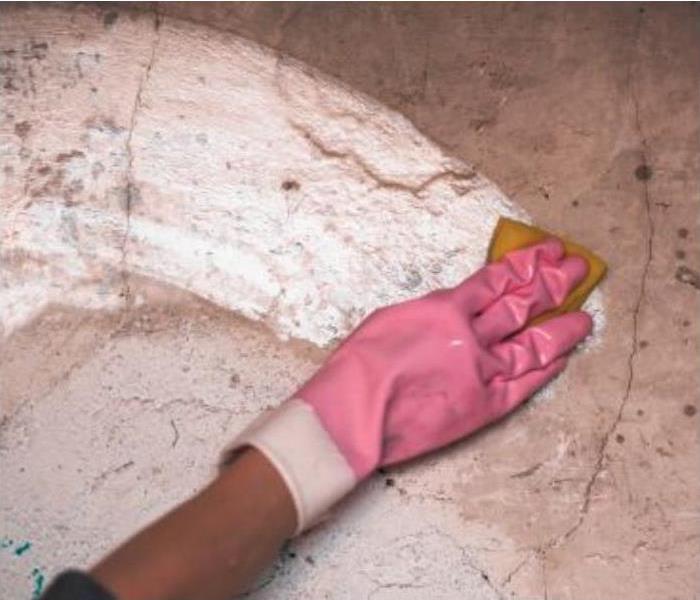 Cleaning Smoke Damaged Wall
Cleaning Smoke Damaged Wall
If you've experienced fire damage in your home or business, dealing with the post-fire period can be overwhelming. Smoke damage on walls and ceilings is a common issue after a fire, but knowing how to properly clean it can make a big difference. In this blog post, we'll guide you through the process of cleaning smoke damage step by step, using basic materials and tools that you likely already have at home. If you have experienced Weymouth fire damage and are looking for professional help, keep reading to learn more.
Signs of Fire Damage on Walls and Ceilings
Before you start cleaning, it's important to identify the signs of fire damage on your walls and ceilings. Common signs of fire damage include:
- Discoloration: One of the most obvious signs of fire damage is discoloration on walls and ceilings. Soot and smoke residue can leave behind dark or blackened patches, contrasting with the original color of the surfaces.
- Strong Odor: Another indication of fire damage is the lingering smell of smoke. Even after the visible soot has been removed, the odor can persist, indicating the presence of smoke particles embedded in the surfaces.
- Gritty Texture: Soot residue often leaves a gritty or powdery texture on walls and ceilings. Running your fingers along the surfaces may reveal a rough or abrasive feel, signaling the presence of smoke residue.
- Staining: Fire damage can manifest as visible stains on walls and ceilings. These stains may vary in intensity, ranging from light smudges to heavy, greasy deposits, depending on the severity of the fire and the materials burned.
- Soot Trails: Soot particles can travel along air currents during a fire, leaving behind distinctive patterns known as soot trails. These trails may appear as streaks or smudges on walls and ceilings, indicating the pathways taken by smoke during the fire event.
Now that you have seen the most common signs of water damage, the next challenge is to find out the best way to remove soot or strong unpleasant odors.
How to Clean Smoke Damage on Walls and Ceilings?
From gathering the important materials to using the proper techniques, we'll guide you through each stage to ensure thorough restoration and safety. Let's dive into refreshing your walls and ceilings from the effects of smoke damage.
Cleaning Materials and Tools Needed
Before cleaning, you need to gather the materials and tools to use. Here’s the list of things you’ll need:
- Chemical sponge
- HEPA vacuum cleaner
- Cleaning solutions such as vinegar, baking soda, rubbing alcohol, or hydrogen peroxide
- Detergent or degreaser
- Commercial air scrubbers
Steps
Now that you have your tools ready you are probably asking: How to remove soot from your walls and ceilings? So, let's delve into the steps for cleaning smoke damage on walls and ceilings! A tip: Start with ceilings before moving on to walls.
- Safety First: Before you begin cleaning, ensure proper ventilation by opening windows or using fans, and adhering to the fire safety protocols. Also, wear protective gear such as gloves and a mask to avoid inhaling soot particles.
- Dry Cleaning: Start by using a chemical sponge to gently wipe away loose soot from the walls and ceilings. Avoid pressing too hard to prevent smudging.
- Vacuuming: Use a HEPA vacuum cleaner to remove remaining soot particles from the surfaces. Be thorough, paying extra attention to corners and crevices.
- Wet Cleaning: Prepare a cleaning solution using one of the mentioned ingredients (vinegar, baking soda, rubbing alcohol, or hydrogen peroxide) mixed with water or detergent. Apply the solution to a clean cloth or sponge and gently scrub the affected areas.
- Rinsing: After scrubbing, rinse the walls and ceilings with clean water to remove any residue from the cleaning solution.
- Drying: Allow the surfaces to air dry completely or use fans to speed up the process.
- Odor Removal: After cleaning the smoke damage, use commercial air scrubbers or air purifiers to eliminate lingering odors from your walls and ceilings. These devices work to filter out airborne particles and neutralize odors, ensuring a fresh and clean environment.
Additional Tips
Here are some additional tips that you can take into account:
- Spot Test Cleaning Solutions: Before applying any cleaning solution to larger areas, test a solution on a small, less noticeable area to ensure compatibility with the paint or finish. This helps prevent unintended damage and ensures safe and effective cleaning.
- Avoid Ammonia-Based Cleaners: Avoid using ammonia-based cleaners when tackling smoke damage, as they can react with smoke residue and produce toxic fumes.
- Seal Unfinished Surfaces: If your walls or ceilings have unfinished surfaces, consider sealing them with a protective coating after cleaning to prevent future smoke damage absorption.
- Tackle HVAC Systems: Don't overlook your heating, ventilation, and air conditioning (HVAC) systems, as they can harbor smoke particles and distribute them throughout your home. Consider hiring a professional to inspect and clean your HVAC system to prevent recontamination of cleaned surfaces.
- Professional Help: If the smoke damage is extensive or if you're uncertain about the cleaning process, it's best to seek help from professional damage restoration contractors. Their expertise and specialized equipment can speed up the restoration process while ensuring optimal results and safety.
Contact SERVPRO of Weymouth, Hingham, and Quincy
Dealing with Weymouth fire damage and smoke damage on walls and ceilings can be challenging, but it is possible to restore your property to its pre-fire condition. For professional assistance, don't hesitate to contact SERVPRO of Weymouth, Hingham, and Quincy. Call us at (781) 337-0344 or submit our online form. We are here to offer 24/7 fire damage emergency services.
Tackling Commercial Property Water Damage: Tips and Solutions
4/30/2024 (Permalink)
 commercial property water damage
commercial property water damage
Water damage in commercial properties can spell trouble for business owners and property managers. From structural issues to potential health hazards, the consequences of commercial property water damage can be significant. In this blog post, we'll delve into the causes of such damage, its effects, and most importantly, how to effectively tackle it on your own or with the help of professional commercial water damage restoration services.
How Can Water Damage Your Commercial Property?
Water damage can wreak havoc on commercial properties in different ways. Whether it's from a burst pipe, a leaky roof, or a flooding event, water seepage can affect the integrity of the building's structure. It can seep into walls, floors, and ceilings, leading to mold growth, rotting wood, and weakened foundations. In addition, stagnant water can become a breeding ground for bacteria and other pathogens, leading to health risks to occupants.
Common Causes of Water Damage in Commercial Properties
Water damage in commercial properties can be caused by different factors. The most common factors contributing to water damage in commercial properties are the following:
- Leaking Pipes and Plumbing: Old or damaged pipes can leak, causing water to accumulate in hidden spaces.
- Roof Leaks: Cracks or missing shingles in the roof can allow water to seep into the building during rainfall.
- Appliance Malfunctions: Faulty equipment such as water heaters or HVAC systems can lead to leaks or flooding.
- Natural Disasters: Events like hurricanes, heavy rainfall, or flash floods can cause extensive water damage.
What Does It All Affect?
Water damage doesn't just impact the physical structure of the property. It can also affect its value and functionality. Untreated water damage can lead to costly repairs and renovations, lowering the property's resale or rental value. Moreover, it can disrupt business operations, leading to financial losses and inconvenience for tenants or customers.
In addition, the presence of water damage can tarnish the reputation of the business, affecting customer trust and loyalty. Therefore, tackling water damage on time is crucial. This protects both the building's structure and the safety and reputation of those who use it.
How to Tackle Commercial Property Water Damage: DIY Solutions
While some minor water damage issues can be tackled by property owners, significant damage requires professional intervention. Here are some DIY solutions for minor water damage:
- Identify and Fix Leaks: Inspect plumbing fixtures and appliances for leaks, and repair them as soon as possible.
- Absorb Excess Water with Towels and Rags: Use towels, rags, or even old clothing to soak up excess water from surfaces. Press firmly to encourage absorption, and wring out and replace the towels as needed.
- Increase Air Circulation with Fans: Maximize airflow by using household fans or opening windows and doors. This can help speed up the drying process by evaporating moisture more quickly.
- Use Sunlight: If weather permits, take advantage of sunlight by opening curtains or blinds to let natural light in. Sunlight can help dry out damp areas and stop mold growth.
- Use Natural Dehumidifiers: Place bowls of activated charcoal or uncooked rice in the affected areas to naturally absorb moisture from the air. Replace the charcoal or rice regularly as they become soaked.
- Sprinkle Baking Soda: Sprinkle baking soda liberally over damp carpets, rugs, or upholstery to absorb moisture and neutralize odors. Let it sit for several hours or overnight before vacuuming it up.
- Apply Vinegar Solution for Disinfection: Create a solution of equal parts water and white vinegar and spray it onto hard surfaces to disinfect and prevent mold growth. Allow it to sit for a few minutes before wiping it away with a clean cloth.
When to Call in Professional Help? Professional Step-by-Step Mitigation
If you encounter significant water damage or are unsure of the extent of the problem, it's best to call in professionals. Commercial water damage restoration experts have the expertise and equipment to mitigate water damage. Their step-by-step process typically includes:
- Assessment: Thorough inspection to assess the extent of the damage and identify potential hazards.
- Water Extraction: Removal of standing water using powerful pumps and extraction equipment.
- Drying and Dehumidification: Using industrial-grade air movers and dehumidifiers to dry out the affected areas completely.
- Cleaning and Sanitization: Disinfection of surfaces to prevent mold growth and eliminate any lingering odors.
- Restoration: Repair and restoration of damaged materials to bring the property back to its pre-damaged condition.
Prevention Tips
Prevention is key to avoiding the headache and expense of water damage. Here are some tips to safeguard your commercial property:
- Regular Maintenance: Schedule routine inspections and maintenance for plumbing, roofing, and HVAC systems.
- Weatherproofing: Seal windows, doors, and other openings to prevent water seepage during storms.
- Upgrade Plumbing Fixtures: Think about upgrading to water-efficient plumbing fixtures and appliances to reduce the risk of leaks and water waste. Install leak detection devices on vulnerable plumbing connections.
- Employee Education: Educate employees on proper water usage and the importance of reporting leaks quickly.
- Protect Documents and Electronics: Store important documents and sensitive electronic equipment in waterproof containers or cabinets, especially in areas prone to water damage such as basements or storage rooms.
- Emergency Preparedness: Develop an emergency plan that outlines procedures for dealing with water damage incidents.
- Grading and Drainage Systems: Consider investing in landscaping features such as grading and drainage systems to divert water away from the property's foundation, reducing the risk of water intrusion.
- Invest in Flood Insurance: Look into purchasing flood insurance, even if your property is not located in a high-risk flood zone. It can provide financial protection in the event of water damage from flooding or storm surges.
Contact SERVPRO of Weymouth for Your Commercial Property Water Damage
If you're dealing with commercial property water damage that's beyond DIY solutions, don't hesitate to reach out to the professionals. SERVPRO of Weymouth specializes in commercial water damage restoration and can provide timely and effective solutions to mitigate the damage. Contact us today to schedule an assessment and get your property back to its pre-damaged state. Give us a call at (781) 337-0344 or send us a message through our online form.
The 3 Water Damage Categories and How to Clean Each Up
3/19/2024 (Permalink)
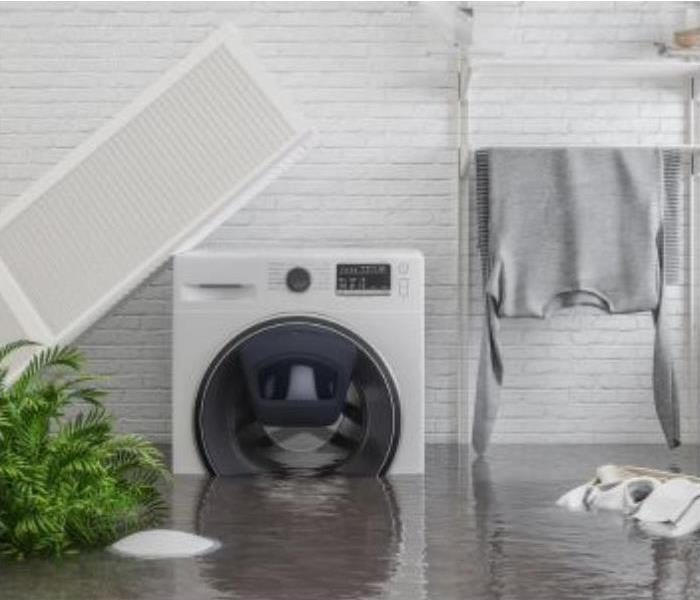 Facing water damage? Understand its severity, the three water damage categories for effective response, and the concept of category deterioration.
Facing water damage? Understand its severity, the three water damage categories for effective response, and the concept of category deterioration.
When facing water damage restoration in Weymouth, understanding the severity of the damage is crucial. Water damage can stem from various sources, each presenting different levels of contamination. Knowing the three water damage categories can help homeowners or property managers respond effectively to minimize further harm. We’ll walk you through what each of these categories involves, how to clean them up, and what the category deterioration refers to. Besides, if you happen to need a company dealing with water damage restoration in Weymouth, we’ve got you covered! Keep reading to find out more!
What Are 3 Categories of Water?
These categories of water refer to the degree of cleanliness and potential health hazards associated with the water. The IICRC Standard for Professional Water Damage Restoration defines these three main categories of water damage based on the level of contamination. This standard and the categories ensure consistency and professionalism in restoration practices, helping professionals and homeowners assess the risk associated with the water damage and determine the appropriate cleanup procedures accordingly.
Categories of Water Damage
Water damage can wreak havoc on homes and properties, but not all water is created equal when it comes to potential health risks. Understanding the three categories of water damage is significant for effective cleanup, mitigation, and restoration. So, let’s dive into the details of water damage categories together for a clearer perspective!
Category 1 Water - Sanitary ("Clean Water")
Category 1 water damage involves water from a clean and sanitary source. This type of water carries the least risk to human health since it does not contain significant levels of contaminants. Common sources of Category 1 water damage include broken pipes, overflowing sinks, or rainwater leaks.
Cleanup Approach:
Since Category 1 water is clean, the cleanup process primarily involves removing the excess water and drying the affected area. Using fans, dehumidifiers, and proper ventilation can speed up the drying process and prevent mold growth. It's essential to act quickly to prevent the water from absorbing into building materials, which can lead to structural damage.
Category 2 Water - Significantly Contaminated ("Grey Water")
Category 2 water damage involves water that contains significant levels of contaminants, but not sewage. This type of water may cause health issues if swallowed or exposed to the skin. Common sources of Category 2 water damage include washing machine overflows, and dishwasher leaks.
Cleanup Approach:
Cleaning up Category 2 water damage requires protective gear, such as gloves and masks because of the presence of contaminants. The affected area should be thoroughly cleaned and disinfected to prevent the spread of bacteria and pathogens. Depending on the extent of the damage, professional water damage restoration services may be needed to ensure proper cleanup and sanitization.
Category 3 Water - Grossly Contaminated ("Black Water")
Category 3 water damage involves water that is grossly contaminated and carries severe health risks. This type of water contains sewage, chemicals, or other harmful substances. Category 3 water damage can result from sewer backups, flooding from rivers or streams, or toilet overflows containing feces.
Cleanup Approach:
Cleaning up Category 3 water damage requires extreme caution and should only be handled by trained professionals equipped with the necessary protective gear and specialized equipment. Given the high level of contamination, affected materials may need proper removal and disposal. Thorough disinfection and decontamination are essential to ensure the safety of occupants and prevent the spread of diseases.
Category Deterioration
It's important to know that water damage can get worse over time if not taken care of. Category deterioration means water contamination can go from a lower to a higher, more dangerous level. This happens as clean water sits still and mixes with different materials, causing germs to grow and more harmful substances to get in.
For example, Category 1 water damage left untreated can degrade into Category 2 or even Category 3 water damage. Factors such as time, temperature, and environmental conditions can speed up this deterioration process. As water sits still, it becomes a perfect breeding ground for bacteria, and viruses, worsening indoor air quality and carrying health risks to occupants.
To minimize category deterioration and prevent further contamination, it's crucial to act fast after a water damage incident. Even seemingly clean water can become more dangerous over time if not properly tackled. Professional water damage restoration companies can assess the extent of the damage, carry out appropriate cleanup measures, and prevent category deterioration through thorough drying, disinfection, and restoration efforts.
Understanding the three water damage categories is vital for effective cleanup and restoration efforts. Whether dealing with clean water damage or grossly contaminated black water damage, taking quick action can limit the damage, lower repair costs, and keep indoor spaces safe and healthy in the long run. Understanding category deterioration and its effects on water damage cleanup helps you protect your property and the health of those living inside.
Reach Out to SERVPRO of Weymouth, Hingham and Quincy
If faced with water damage in Weymouth, seeking professional water damage restoration services can help safeguard the health and well-being of occupants. Contact SERVPRO of Weymouth, Hingham and Quincy for immediate help with water damage cleanup and restoration tasks! Do so by calling (781) 337-0344 or by filling out an online form on our website! Don't delay tackling water damage issues, as quick action can make all the difference in minimizing damage and restoring your property to its preloss condition. Our team of professionals offers you 24/7 emergency services!
How to Fix Water Damage in the Basement
3/12/2024 (Permalink)
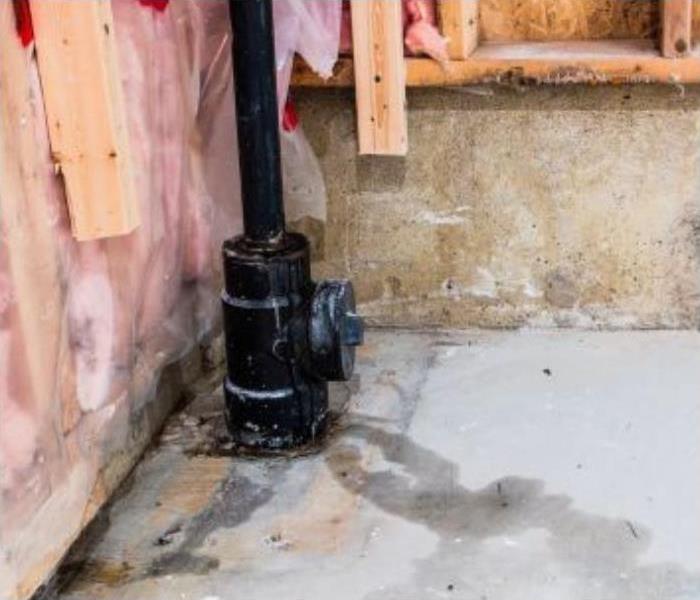 Facing water damage in your basement? Learn how to fix it with our guide. Find solutions, preventive tips, and a professional help recommendation.
Facing water damage in your basement? Learn how to fix it with our guide. Find solutions, preventive tips, and a professional help recommendation.
Are you facing the frustrating issue of water in your basement? Dealing with water leaking into basement can be a challenging task, but fear not! In this guide, we'll walk you through the steps on how to fix water damage in the basement. From identifying the causes to implementing effective solutions, we've got you covered. Besides, if you need professional help in dealing with Weymouth water damage restoration, the recommendation is out there if you keep reading.
Causes of Water Damage in the Basement
Before diving into solutions, it's essential to understand what causes water damage in the basement. Common culprits include:
- Poor Drainage: When rainwater isn't properly diverted away from your home, it can seep into the basement. This can lead to dampness and mold growth, creating a breeding ground for pests.
- Cracks and Gaps: Cracks in the foundation or gaps around windows and doors provide pathways for water to enter. These openings can also weaken the structural integrity of your home over time.
- Sloping Landscape: If your yard slopes towards the house, rainwater can accumulate near the foundation and find its way into the basement. This can result in erosion of the soil around your home's foundation.
- Clogged Gutters: Gutters and downspouts that are clogged or damaged can lead to overflow, resulting in water pooling around the foundation. This standing water can attract mosquitoes and other insects, which can be annoying and even present a potential health risk.
Tackling Water in Basement
It's also important to emphasize the importance of proactive maintenance to prevent water damage in the basement. Regularly inspecting your home for signs of water seepage and tackling any issues quickly can save you time, money, and headaches down the line. Keep an eye out for dampness, mold growth, or musty odors, as these can indicate underlying water problems. By staying alert and proactive, you can nip potential issues in the bud and protect your basement from water damage.
How to Fix Water Damage in the Basement
Now that you understand the potential causes and preventive measures, let's discuss how to tackle water damage in the basement. Remember, by following these solutions, you can handle water damage in your basement and safeguard your home from future incidents.
- Extend Gutters: Make sure your gutters are long enough to carry water away from your house (at least 10 feet away). This helps keep water from getting close to your home's foundation.
- Plug Gaps: Seal any cracks or gaps in the foundation, windows, and doors to prevent water from sneaking inside and seeping.
- Restore the Crown: Fix the slope of the ground around your home so water flows away from the house. This helps keep water from collecting near the foundation.
- Reshape the Landscape: Change the shape of your yard so water moves away from your home's foundation. This stops water from gathering near your basement walls.
- Fix Footing Drains: Check that any drains near your house are in good condition. These drains help move water away from your home's foundation.
- Install a Curtain Drain: Consider adding a special drain around your home. This drain, also known as a curtain drain, catches and moves water away from your home's foundation.
- Remove the Water with Pump: If your basement floods, use a pump to get rid of the water fast. This helps prevent damage to your basement and belongings.
- Make the Walls Waterproof: Put a special coating on your basement walls to stop water from seeping in. This protects your basement from water damage.
- Improve Indoor Air Quality (IAQ): Damp environments are breeding grounds for mold and mildew, which can affect IAQ and lead to respiratory problems. To improve IAQ, ensure proper ventilation and consider using dehumidifiers to reduce moisture levels in the basement. Besides that, inspect and clean HVAC systems to prevent the spread of particles (contaminants) carried through the air. Prioritizing IAQ creates a healthier living environment for you and your family.
Seeking Professional Help
If you're facing extensive water damage in your basement, don't hesitate to seek professional help from a reputable water damage restoration company. They have the expertise and equipment to assess the situation and provide effective solutions to restore your basement to its pre-damaged condition.
Reach Out to SERVPRO of Weymouth, Hingham and Quincy for Immediate Help with Basement Water Damage
If you live in Weymouth area, and are unsure who to contact for your water damage concerns, SERVPRO of Weymouth, Hingham and Quincy is Here to Help®! With over 20 years of experience in the restoration industry, our IICRC-certified team is fully equipped to take care of your water-damaged basements and much more than that! We are available 24/7 for your emergency needs! So, don’t wait, contact us today at (781) 337-0344 or submit an online contact form on our website for a free consultation!
How to Fix Water Damaged Wood Furniture After a Flood
3/5/2024 (Permalink)
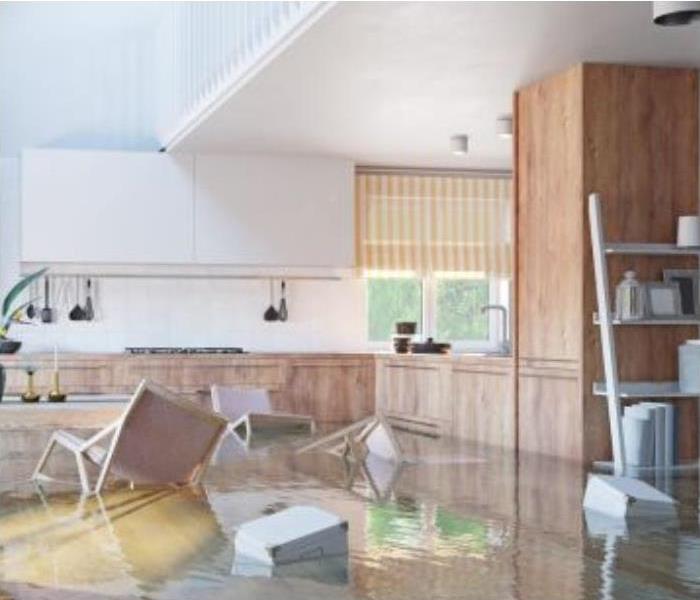 Learn how to fix water damaged wood furniture after a flood with our guide. Discover expert tips for successful restoration and further damage prevent
Learn how to fix water damaged wood furniture after a flood with our guide. Discover expert tips for successful restoration and further damage prevent
Handling water damage to wooden furniture post-flood can be tough. Whether it's an antique dresser or a modern table, water can harm wood if not treated promptly. In flood-prone areas, knowing how to deal with the aftermath is crucial. This guide explores flood effects on wood furniture and offers steps to repair water-damaged wood, restoring your pieces. For those skeptical about tackling the task of water damage restoration Ogden UT, we’ve got you covered with an expert recommendation!
How Does Flood Affect Wood Furniture?
Wood is highly susceptible to water damage. But, how does water damage wood? When exposed to floodwaters, wood absorbs moisture, causing it to swell, warp, and potentially develop mold and mildew. This can lead to structural instability and permanent damage if left untreated. Additionally, prolonged exposure to moisture can cause wood to lose its strength and integrity, making it more prone to cracks and breakage.
What to Do After a Flood Damaged My Wood Furniture?
Facing water damage to your wood furniture after a flood can feel overwhelming, but taking the right steps can help salvage your cherished pieces. Here's a detailed guide on what to do:
Step 1: Quick Removal
As soon as you can, move the water-damaged furniture away from the flooded area to a dry spot. This helps prevent further soaking and potential mold growth.
Step 2: Drying Process
Using absorbent towels or cloths, gently blot away any excess water from the surface of the furniture. Avoid rubbing, as this can cause further damage.
Step 3: Air Circulation
Ensure good air circulation around the furniture by opening windows and using fans or dehumidifiers. This helps speed up the drying process and prevents mold and mildew from forming.
Step 4: Gentle Cleaning
If the furniture is muddy or dirty from the floodwater, lightly clean it with a mixture of mild soap and water. Be careful not to saturate the wood, as this can make the damage worse.
Step 5: Evaluation
Take a close look at the extent of the damage. Check for signs of warping, cracking, or mold growth. This assessment will help determine the next steps in the repair process.
By following these steps quickly and carefully, you can increase the chances of restoring your water-damaged wood furniture. Remember, if you're unsure or if the damage is extensive, it's best to seek professional help from a water damage restoration contractor certified by the IICRC.
How to Fix Water Damaged Wood Furniture
If you are still up to repairing damaged wood furniture yourself, you should know it also depends on the type of furniture and damage it has sustained. Here's a step-by-step guide to help you tackle the task:
If Furniture is Wet:
Step 1: Thorough Drying
Start by removing as much moisture as possible from the wood furniture. Use towels or cloths to blot away excess water, and then place the furniture in a dry, well-ventilated area.
Step 2: Air Circulation
Promote air circulation around the wet furniture by opening windows and using fans or dehumidifiers. This helps speed up the drying process and prevents mold growth.
Step 3: Gentle Cleaning
If the furniture is dirty from the floodwater, gently clean it with a mixture of mild soap and water. Be careful not to soak the wood, as this can cause further damage.
Step 4: Assessment
Once the furniture is dry to the touch, carefully inspect it for any signs of damage such as warping or mold growth. Take note of areas that may need extra attention during the repair process.
Step 5: Sanding
If the wood surface appears rough or uneven after drying, lightly sand it with fine-grit sandpaper to smooth out any imperfections. This prepares the surface for further treatment.
Step 6: Conditioning
Apply a wood conditioner or sealant to the dried wood surface. This helps restore moisture and protects the wood from future damage.
Step 7: Final Drying
Allow the furniture to dry completely before using it again. This ensures that the wood is fully restored and ready for use.
If Furniture is Dry:
Step 1: Inspection
Carefully examine the dry wood furniture for any remaining damage, such as cracks, scratches, or discoloration. Take note of areas that may require repair or touch-up.
Step 2: Repairing Cracks
If there are cracks or gaps in the wood, fill them with wood filler or putty. Smooth the filler with a putty knife and allow it to dry completely before sanding.
Step 3: Sanding
Once the filler is dry, sand the repaired areas gently to blend them seamlessly with the surrounding wood surface. Use fine-grit sandpaper for best results.
Step 4: Staining or Painting
If necessary, apply a wood stain or paint to the repaired areas to match the color and finish of the rest of the furniture. Allow the stain or paint to dry completely before using the furniture.
Step 5: Final Touches
Inspect the repaired areas and make any final adjustments as needed. This ensures that the wood furniture looks its best and is fully restored to its original condition.
Water damage to wood furniture can be a challenging problem to tackle, but with the right knowledge and techniques, it is possible to restore your beloved pieces to their former glory. By understanding the effects of floods on wood and following the proper steps for repair, you can salvage your furniture and prevent further damage.
Water Damage Professional Help at SERVPRO of Weymouth, Hingham and Quincy
If you live in Ogden, Utah, and are unsure of how to tackle the task on your own, we have a reliable team for your water damage concerns! At SERVPRO of Weymouth, Hingham and Quincy, we understand the toll of the water damage on your furniture and property. We provide emergency services 24/7 with response times within the hour. Our experienced IICRC-certified technicians are committed to providing you with the highest level of service! Yours is just to call (781) 337-0344 or submit a contact form on our website.
7 Steps to Take If You Know You're Buying a Home with Water Damage
2/27/2024 (Permalink)
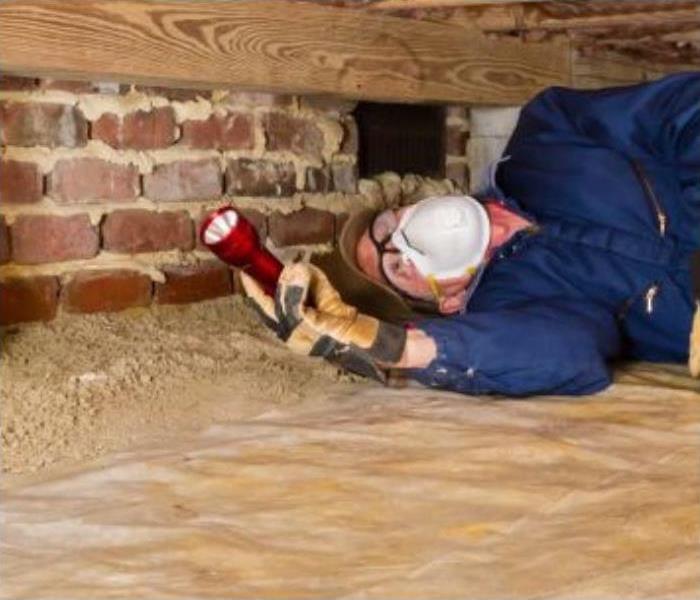 Learn essential steps for buying a home with water damage, from gathering info to professional restoration. Achieve success with our guide!
Learn essential steps for buying a home with water damage, from gathering info to professional restoration. Achieve success with our guide!
Navigating the purchase of a home is a thrilling yet challenging endeavor, especially when faced with the reality of buying a home with water damage. While this revelation may initially appear discouraging, there are actionable steps you can take to address the situation and proceed towards making that dream home yours. In this blog post, we'll outline essential strategies to guide you through the process of purchasing a home with water damage, from making informed decisions to enlisting professionals for water damage restoration Weymouth. We'll help you achieve successful resolution of any challenges encountered along the way.
1. Prepare Questions for the Homeowner or Real Estate Agency
The first step in dealing with a potential water-damaged house is to gather information by preparing a set of questions for the homeowner or the real estate agency. These questions can cover various aspects, such as any known history of water damage, recent repairs, or any preventive measures taken. By seeking answers to these questions upfront, you can gain valuable insights into the property's condition and make an informed decision about whether to proceed with a professional home inspection or negotiate terms with the seller.
2. Determine the Cost of Necessary Water Damage Repairs and Remediation
After gathering information about the water damage, the next crucial step is to assess the financial implications by determining the cost of necessary repairs and remediation. There are several ways to estimate these costs:
- Obtain Estimates from Different Contractors: Reach out to reputable water damage restoration contractors in your area and request detailed estimates for the required repairs. Having multiple quotes allows you to compare costs, services, and timelines. Ensure that the estimates include a breakdown of expenses, so you have a clear understanding of what each contractor is proposing.
- Research Market Values for Comparable Houses: Consult real estate agencies to gather market values for similar houses in the area without water damage. This information can provide a benchmark for understanding the potential impact of water damage on the property's overall value. It may also serve as valuable negotiation leverage when discussing repair costs with the seller.
- Factor in Additional Costs: In addition to direct repair costs, consider any additional expenses that may arise during the remediation process. This could include temporary housing costs if the property is uninhabitable during repairs or any hidden structural issues uncovered during the restoration process. Having a comprehensive understanding of all potential costs is vital for accurate financial planning.
By thoroughly exploring these avenues, you can develop a clear picture of the financial aspects associated with repairing water damage. This knowledge not only helps in budgeting effectively but also empowers you to make informed decisions during the home-buying process.
3. Get Adequate Homeowner's Insurance
One often overlooked aspect of buying a home with water damage is ensuring you have the right homeowner's insurance in place. Regular policies may not cover water damage, or there might be limitations. Speak with your insurance provider to discuss specific coverage for water-related issues. Being proactive about insurance can save you from unexpected financial burdens down the line.
4. Understand the Requirements of Buying a House
In the process of purchasing a water-damaged house, it's crucial to understand the overall requirements of buying a house. This includes legal considerations, paperwork, and compliance with local regulations. Be diligent in reviewing contracts and consult with legal professionals if needed to ensure a smooth and legally sound home-buying process.
5. Use Professional Water Damage Restoration Services
When it comes to addressing water damage, it's essential to enlist the help of professional water damage restoration services. These experts have the knowledge, skills, and equipment to effectively remediate water damage and restore your new property to excellent condition. Don't underestimate the importance of a thorough restoration process in maintaining the structural integrity and safety of your home.
6. Research Local Water Damage Restoration Services
When facing the prospect of buying a home with water damage, it's essential to research and identify reputable local water damage restoration services in the Weymouth area. Understanding the expertise and track record of these professionals is crucial for ensuring that the necessary repairs are carried out effectively. Look for customer reviews, testimonials, and certifications to make an informed decision about the restoration team you choose.
7. Plan for Preventive Measures
Once the water damage has been addressed and your new home is on its way to recovery, it's time to plan for preventive measures. Work with your water damage restoration professionals to identify areas of vulnerability and implement strategies to prevent future issues. This may include improved drainage systems, regular inspections, or simple home maintenance practices. Taking proactive steps now can save you from potential headaches and expenses in the future.
Reach Out to SERVPRO of Weymouth, Hingham and Quincy for Immediate Assistance
Purchasing a home with water damage presents its challenges, but with the right approach, it's possible to turn this situation into an opportunity. By gathering information, assessing repair costs, securing adequate insurance, understanding legal requirements, and enlisting professional restoration services, you can navigate the process with confidence. Remember to research local restoration services and negotiate terms with the seller to ensure a successful outcome. With careful planning and proactive measures, you can soon transform that water-damaged house into your dream home, ready to welcome you for years to come. Contact us at (781) 337-0344 or fill out the contact form on our website! At SERVPRO of Weymouth, Hingham and Quincy, our IICRC-certified team is committed to providing you with the highest level of service!
How to Fix Ceiling Water Damage After a Leak
2/22/2024 (Permalink)
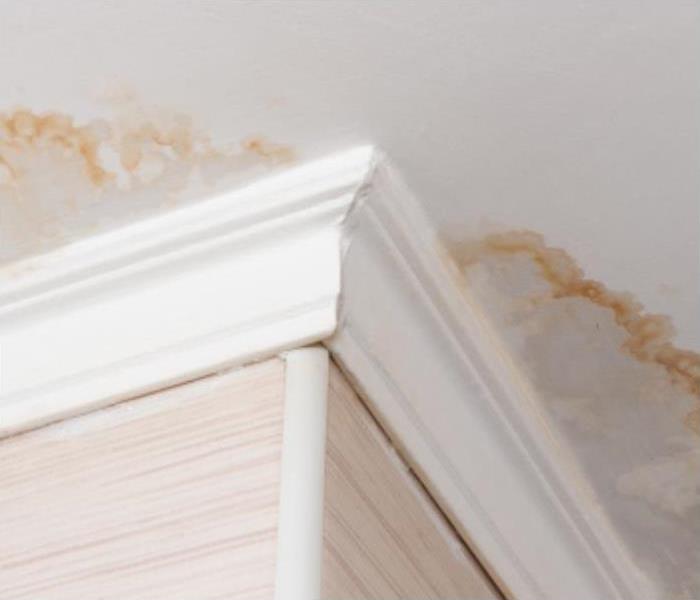 Discover how to fix ceiling water damage with the assistance of our comprehensive guide, ensuring a smooth restoration process for your home.
Discover how to fix ceiling water damage with the assistance of our comprehensive guide, ensuring a smooth restoration process for your home.
Water damage can be a persistent challenge for homeowners, particularly when it infiltrates the ceiling. Whether it stems from a leaky roof, a burst pipe, or a malfunctioning appliance, addressing ceiling water damage quickly is crucial for the prevention of further complications. In this comprehensive guide about water damage restoration, we'll delve into the intricacies of understanding, identifying, and effectively repairing ceiling water damage.
What is Water Damage After a Leak?
When it comes to safeguarding your home, quick water damage restoration is essential, especially after a leak. This type of damage occurs when unwanted water accumulates in areas it shouldn't, potentially leading to structural issues and health hazards. Ceiling water damage often results from leaks originating above, such as a damaged roof or a plumbing malfunction.
Types of Ceiling Water Damage
As water damage can manifest in various ways, understanding the types of damage is crucial for effective mitigation. Each type requires a specific approach to restoration to ensure a thorough and lasting solution.
- Water Stains: Water stains are visible indicators of ceiling water damage, often appearing as unpleasant brown discolorations. These stains can spread over time if not immediately addressed, making them a clear sign of water infiltration and a potential need for water damage drywall ceiling repair.
- Sagging or Bulging: Excess water saturating the ceiling material can compromise its structural integrity, causing it to sag or bulge. Recognizing sagging or bulging is crucial, as it indicates significant water damage that requires immediate attention.
- Peeling Paint or Wallpaper: The presence of excess moisture can cause the paint or wallpaper on your ceiling to peel or bubble. Beyond being aesthetically unpleasing, this indicates ongoing water damage that needs to be resolved.
- Mold Growth: Perhaps the most alarming consequence of water damage is the potential growth of mold. Thriving in damp environments, mold poses serious health risks and requires quick remediation to prevent further harm.
How to Repair a Ceiling from Water Damage
Now you are familiar with the types of ceiling water damage, but you are still wondering how to fix water damaged ceiling. Addressing ceiling water damage involves a systematic approach to ensure effective and lasting restoration. From identifying the source of the leak to repairing or replacing damaged materials, each step plays a crucial role in the restoration process. Here are the details regarding these steps:
- Identify and Fix the Source of the Leak
Before addressing the ceiling damage, pinpoint and fix the source of the leak. Whether it's a roof issue, a burst pipe, or a malfunctioning appliance, resolving the root cause is paramount to prevent recurring damage.
Carefully remove any wet or damaged materials from the affected area. This may include wet insulation, ceiling tiles, or sections of drywall. Be cautious, as wet materials can be heavy and prone to collapsing.
Utilize fans and dehumidifiers to thoroughly dry out the affected area. This step is critical in preventing mold growth. Ensure the space is completely dry before proceeding with repairs.
- Repair or Replace Damaged Ceiling Materials
The extent of the water damage will determine whether a simple patch or the replacement of entire sections of drywall or ceiling tiles is necessary. Professional assistance is advisable for severe damage, particularly if structural issues are involved.
- Repaint or Reapply Wallpaper:
Once you managed to fix water damage ceiling, and the area is dry, restore the aesthetic appeal of your ceiling by repainting or reapplying wallpaper.
The Importance of Timely Intervention
Immediate and decisive action is substantial when dealing with ceiling water damage. Ignoring or delaying repairs can worsen the situation, leading to more extensive damage, increased repair costs, and potential health hazards. Mold, in particular, can start growing within 24 to 48 hours of water exposure, emphasizing the urgency of fast intervention. Timely repairs not only safeguard the structural integrity of your home but also contribute to a healthier living environment.
Preventing Future Water Damage
Beyond addressing current water damage, it's equally important to take preventative measures to avoid future incidents. Regularly inspect your roof for signs of damage, keep gutters clean to ensure proper drainage, and promptly fix any plumbing issues. Besides, consider installing leak detectors or smart home water monitoring systems to receive timely alerts in case of potential leaks. These proactive steps can significantly reduce the risk of future ceiling water damage, providing peace of mind for homeowners.
Navigating Insurance and FEMA Assistance
In some cases, homeowners may be eligible for insurance coverage to assist with water damage restoration. Familiarize yourself with your insurance policy and understand the coverage it provides for water damage. Additionally, in situations involving widespread damage, such as natural disasters, the Federal Emergency Management Agency (FEMA) may offer assistance. It's crucial to stay informed about FEMA programs, eligibility criteria, and the application process. Seeking assistance from these avenues can help ease the financial burden associated with extensive water damage restoration.
Efficient Water Damage Restoration at SERVPRO of Weymouth, Hingham and Quincy
Ceiling water damage, though challenging, is manageable to some extent with the right approach. By understanding the signs, taking fast action, and implementing preventative measures, homeowners can mitigate the impact of water damage on their homes. Whether you're addressing a small water stain or a more significant structural issue, the key is to approach repairs with a sense of urgency. Remember, a well-informed homeowner is better equipped to navigate the restoration process and maintain a safe, comfortable living space for years to come. Yet, it is important to note that certified professionals like SERVPRO of Weymouth, Hingham and Quincy can approach water damage restoration tasks with the utmost precision and care! Our team with their expertise and equipment will fix your water damage ceilings in no time! Do not hesitate to contact us at (781) 337-0344!
The 5 Fire Types: What Type of Fire Can Be Put Out Safely with Water?
2/22/2024 (Permalink)
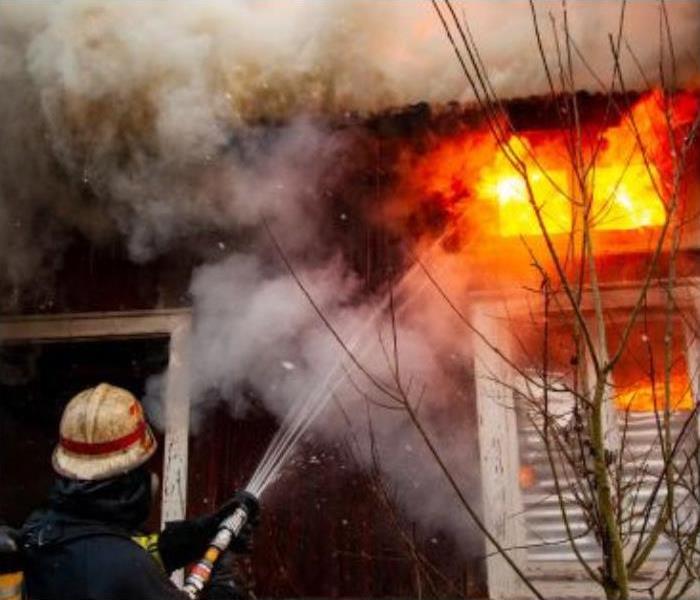 Discover what type of fire can be safely extinguished with water. Explore extinguishing methods and prevention steps for each of the 5 fire types.
Discover what type of fire can be safely extinguished with water. Explore extinguishing methods and prevention steps for each of the 5 fire types.
As individuals seeking to ensure our homes and loved ones are safe, understanding the basics of fire and how to handle it is crucial. Fires come in various forms, each with its characteristics and dangers. Knowing which fires can be safely put out with water is essential knowledge for anyone concerned about fire safety. In this comprehensive blog post, we'll explore the five primary fire types, fire damage prevention across all fire types, and answer the burning question: what type of fire can be extinguished safely using water? Plus, if you need help with fire damage Weymouth MA, we’ve got you covered.
Fire Classification: What Type of Fire Can Be Put Out Safely with Water?
Before we delve into specific fire types, let's establish a foundational understanding of fire classification. Fires are categorized into different classes based on the type of fuel involved. This classification system helps firefighters and damage restoration professionals in determining the most effective extinguishing agents for each type of fire.
- Class A Fires
Class A fires involve ordinary flammable materials such as wood, paper, cloth, and certain plastics. These fires leave behind ash when extinguished. Water is widely recognized as an effective extinguishing agent for Class A fires. It works by cooling the burning material and removing heat from the fire triangle, effectively stifling the flames.
- Class B Fires
Class B fires encompass flammable liquids and gases, including gasoline, oil, grease, and chemicals. Unlike Class A fires, water can intensify Class B fires by spreading the flammable liquid and intensifying the blaze. Foam or dry chemical extinguishers are typically recommended for Class B fires to smother the flames and prevent reignition.
- Class C Fires
Class C fires involve energized electrical equipment, such as appliances, wiring, and circuit breakers. Using water to extinguish Class C fires poses significant risks, as water conducts electricity and can lead to electric shock or electrocution. Carbon dioxide or dry chemical extinguishers are safer alternatives for Class C fires.
- Class D Fires
Class D fires entail flammable metals such as magnesium, titanium, and potassium. Water should never be used to extinguish Class D fires, as it can react violently with the burning metal, potentially causing explosions. Specialized dry powder extinguishing agents are specifically designed for resisting Class D fires.
- Class K Fires
Class K fires involve cooking oils, fats, and greases commonly found in commercial kitchens. Water is ineffective and can even be hazardous when used to extinguish Class K fires, as it can cause hot oil or grease to splatter and spread, intensifying the fire. Wet chemical extinguishers are specifically formulated for Class K fires, creating a cooling effect and forming a barrier to prevent rekindling.
Fire Safety and Damage Prevention Across 5 Fire Types
Now that you know what are 5 fire types and how to extinguish them, let’s move forward with the next step: fire safety and damage prevention. Protecting your home or business from fires requires a tailored strategy for each fire type. Here are seven crucial steps, from installing detectors to investing in suppression systems, ensuring comprehensive fire safety.
- Installing and maintaining smoke detectors and fire alarms: Smoke detectors are crucial for early fire detection, but certain fires, like Class C (electrical fires), may not produce visible smoke. Consider installing fire alarms to detect temperature spikes or electrical issues. This can minimize the risk of smoke damage and personal harm.
- Developing and practicing a fire escape plan: A fire escape plan, tailored to specific hazards, is crucial for all fire types. In kitchens prone to Class K fires, ensure the plan avoids water use to prevent fire escalation.
- Properly storing flammable materials and chemicals: This step is vital for preventing Class B fires with flammable liquids and gases. Store materials safely away from potential fire sources, use approved containers, and ensure adequate ventilation in storage areas.
- Regularly inspecting and maintaining electrical systems and appliances: Electrical fires (Class C) often stem from faulty wiring or appliances. Regular maintenance can spot hazards and prevent fires. Encourage professional inspections and repairs.
- Ensuring proper ventilation: Proper ventilation reduces fire risk, especially in areas prone to grease buildup or flammable vapors, such as kitchens (Class K fires) and industrial settings. Adequate ventilation helps dissipate heat and reduces the likelihood of fires spreading or rekindling.
- Training employees in fire safety protocols: In commercial settings, fire safety training for employees is vital for prevention and effective response. Provide training on fire classes and proper extinguishing methods. For instance, restaurant staff should know how to use wet chemical extinguishers for Class K fires.
- Investing in fire suppression systems: Fire suppression systems, like sprinklers and extinguishers, quickly control fires and limit damage. Choose the right system for specific fire risks. For instance, install a kitchen hood suppression system for Class K fires in commercial kitchens.
Understanding the various fire types and their respective extinguishing methods is crucial for effective fire safety and damage restoration efforts. While water remains a versatile and widely used extinguishing agent for Class A fires, it's important to recognize its limitations and potential hazards in other fire scenarios. By staying informed and prepared, damage restoration contractors can better serve their clients and communities in times of crisis.
Call SERVPRO of Weymouth, Hingham and Quincy
At SERVPRO of Weymouth, Hingham and Quincy, we are committed to solving all fire damage restoration needs. From initial and ongoing training at SERVPRO’s corporate training facility to regular IICRC-industry certification, rest assured our staff is equipped with the knowledge to restore your property. Reach out to our team by calling (781) 337-0344 or filling out a form on our website.
How To Repair Water-Damaged Drywall
12/28/2023 (Permalink)
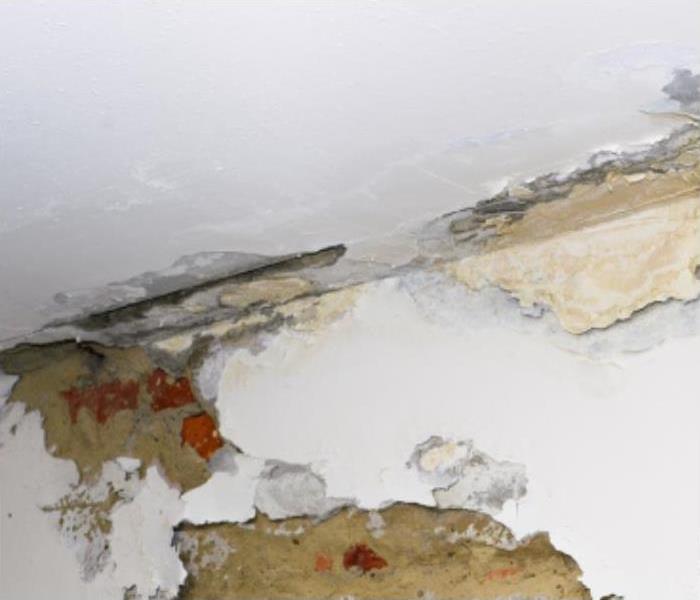 How to Repair Water-Damaged Drywall - An Expert Guide
How to Repair Water-Damaged Drywall - An Expert Guide
Whether it comes from a plumbing problem, a natural disaster, or any other source, water inside your home is never a good thing. Even if there isn’t any standing water, the moisture can cause major problems, and you probably want to know how to repair water damaged drywall. Here, our team at SERVPRO of Weymouth, Hingham, and Quincy offers tips for restoring drywall after water damage to prevent mold growth and further damage.
What Happens When Drywall Gets Wet?
In most cases, water is the enemy of drywall or sheetrock. Contractors typically use a specific type of wall material in bathrooms or other places where it’s likely to experience more moisture. Elsewhere, the wall material should remain dry to ensure structural integrity and prevent mold and mildew infestation.
Water damage on walls can range from unsightly yellowish-brown stains and musty smells to a complete collapse. You might notice that paint or wallpaper starts to bubble or peel, or even water dripping from the walls or ceilings. Soaked sheetrock often feels soft and crumbly, leaving a chalky film on your hands when you touch it.
In extreme cases, water damage on wall boards causes them to buckle, warp, or even collapse. Without immediate repair, moisture will cause mold to grow and spread, putting your family at risk for serious health issues.
Fixing Water-Soaked Drywall
The first step in water-damaged drywall installation is finding and fixing the source of the water. It’s not always immediately clear where the water is coming from, so it might require some investigation to locate and address the leak. Often, this means removing the drywall that has water damage to gain access to the pipes behind it and make repairs.
If the drywall sustains water damage from a flood, the first step is to remove the standing water and attempt to dry the material. It usually takes several days to dry wet sheetrock using fans and dehumidifiers, and even that isn’t a guarantee that it’s still structurally sound. Even after drying, you might still need professional guidance on how to repair water-damaged drywall.
How To Repair Minor Water-Damaged Drywall
If the damage is minimal and mostly cosmetic, you have a few options for restoration. Following some simple steps for repairing water-damaged sheetrock can keep your home in good condition and stop the damage from spreading.
When the damage is strictly cosmetic, you can remove stains and restore the finish by scraping bubbling or peeling paint off the wall and then sanding down the surface. Apply fresh coats of primer and paint and let them dry.
If the damage goes deeper but doesn’t affect any more than a small area (less than 6 inches square), you can remove the affected section and patch it with some new drywall. However, larger sections of damaged drywall, especially when they are moldy, usually need professional attention. If the water damage extends beyond 12 inches square, or a mold infestation covers more than 10 square feet of sheetrock, you need professional remediation.
Repairing Significantly Water-Damaged Drywall
Significant water damage that affects areas larger than 12 square inches or causes the wall to sag more than 3/8 of an inch requires replacing the entire sheetrock panel. Larger pieces of drywall need anchoring to the wall studs or ceiling joists, a project you should leave to a professional.
In fact, when it comes to disaster cleanup, it’s best to avoid DIY water-damaged drywall restoration for safety reasons. Mold is of particular concern when it comes to wet walls, and professional remediation and abatement professionals have the skills and equipment to deal with it without creating health risks for building occupants. Even without widespread mold, dealing with large sections of drywall can be challenging, as the material is often heavy and requires precision to guarantee a safe and seamless replacement.
Trust SERVPRO of Weymouth, Hingham, and Quincy to Deal With Water-Damaged Drywall
If this drywall water damage repair guide still has you wondering what to do about a problem in your South Shore home, get in touch with the cleanup and restoration experts of SERVPRO of Weymouth, Hingham, and Quincy for help at (781) 337-0344. These experienced and knowledgeable professionals can offer insight into how to repair water-damaged drywall and help you recover from a disaster with prompt extraction, drying, cleanup, and restoration services.
Whether your roof leaks or a pipe bursts in the basement, get the help you need to stop water damage fast and keep your home safe by contacting us.
What Does Soot and Smoke Damage Look Like After a Fire?
12/19/2023 (Permalink)
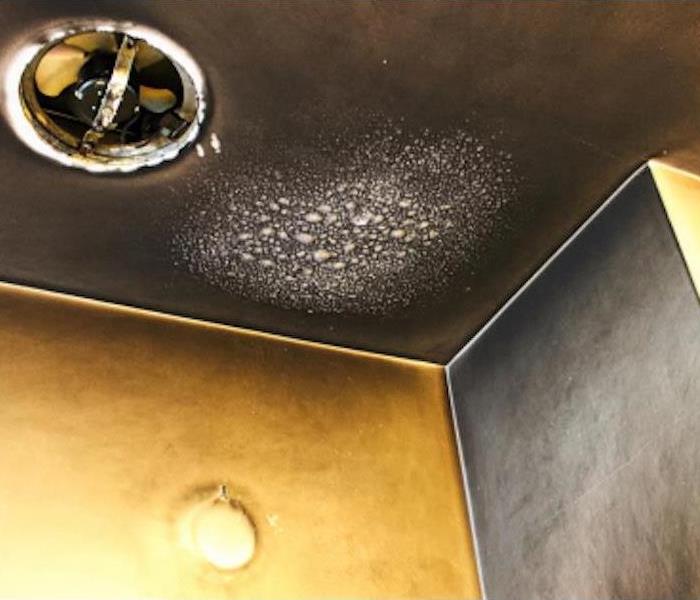 smoke and soot damage
smoke and soot damage
A fire is one of the most damaging events that could happen in your home or business. Though the flames can cause devastation, soot and smoke are equally problematic. Fortunately, fire damage restoration in Hingham can alleviate the lingering effects of a fire.
But what does smoke damage look like? If you've never seen the aftermath of a fire, you might be unsure about the particular characteristics of smoke-damaged surfaces.
At SERVPRO of Weymouth, Hingham and Quincy, our restoration experts have years of experience identifying signs of smoke damage that might be less obvious to a property owner. If you want to learn to recognize common visual indicators of smoke impact, continue reading. We also address how restoration professionals mitigate smoke and soot damage below.
Why Is Soot and Smoke Damage Dangerous?
Smoke damage refers to any damage that follows a fire that the flames don't cause directly. Though smoke doesn't affect materials the same way a fire does, it can still leave behind greasy, smudgy soot. Because smoke and soot particles travel through the air, they can get onto surfaces in spaces without fire damage.
Though they don't seem dangerous, smoke and soot can be more problematic than the fire's flames. Soot particulate isn't visible to the naked eye, so you could breathe in particles unknowingly. It primarily consists of carbon but can contain chemicals, dust, and metals.
Smoke and soot can damage almost any material inside your home or business, such as glass, metal, fabrics, flooring, and marble. Their presence creates foul odors, poor indoor air quality, and health complications.
You can get smoke and soot particles inside your body by breathing inside a fire-damage building without a respirator. Particles can also enter your mouth and eyes. Unfortunately, these toxic particles can cause several problems and symptoms like:
- Chest pain
- Eye irritation
- Cough
- Headaches
- Elevated heartbeat
- Wheezing
- Asthma attack
- Severe skin irritation
Recognizing Smoke Damage Appearances on Surfaces and Materials
What does smoke damage look like? When describing the look of smoke damage, it helps to know about the different types of damage and their characteristics.
Dry Smoke
Dry smoke derives from fast-burning materials like wood and paper. Since the heat is higher when these materials burn, smoke rises quickly.
The residue from dry smoke tends to be dry and powdery. It's easier to wipe clean than other fire damage types. However, its powdery nature also means dry smoke residue can easily slip into holes and crevices, which makes getting rid of the smoky smell more challenging.
Wet Smoke
When rubber or plastic burns at a smoldering heat, it produces wet smoke. Wet smoke is thick and sticky, creating a pungent scent wherever it is.
If you touch wet smoke residue, it will smear on the surface. Its stickiness makes cleaning wet smoke a difficult job requiring lots of time and effort.
Fuel Smoke
Fuel smoke develops when a fire burns oil, petroleum, or similar substances. You're not likely to experience this type of smoke damage inside a home or business. Garages, warehouses, and other spaces that often store petroleum are more likely to experience fuel smoke damage.
The smell of fuel smoke is one of the worst, and the residue is notoriously hard to clean. The smoke remnants are thick, sticky, and almost impossible to remove without professional help.
Protein Smoke
When organic materials burn, they produce protein smoke. This smoke damage is common for kitchen fires. It's mostly invisible, but protein smoke can cause paint discoloration and a lingering smoky scent.
What Should You Do About Smoke and Soot Damage?
Because soot and smoke particles are black, microscopic, and toxic, it's best not to attempt cleaning damaged surfaces yourself. It's better to contact a qualified fire damage restoration company.
Restoration experts know how to identify all the visual clues for smoke damage assessments that determine the extent and severity of the problem. After assessing the property, the restoration crew will create and execute a deep cleaning plan to scrub the entire property of smoke. They have the skills and tools to clean and restore smoke-damaged items safely.
Contact the Experts
You don't have to know the answer to, "What does smoke damage look like?" to understand that SERVPRO of Weymouth, Hingham and Quincy is here to meet your damage restoration needs. Our full-service company offers water, fire, and storm damage restoration, including services for smoke and soot mitigation. Our highly trained technicians use advanced equipment and the latest industry techniques to quickly restore buildings after a disaster.
Call SERVPRO of Weymouth, Hingham and Quincy in Massachusetts today at (781) 337-0344 for assistance.
A Comprehensive Guide To Understanding Fire Damage
12/15/2023 (Permalink)
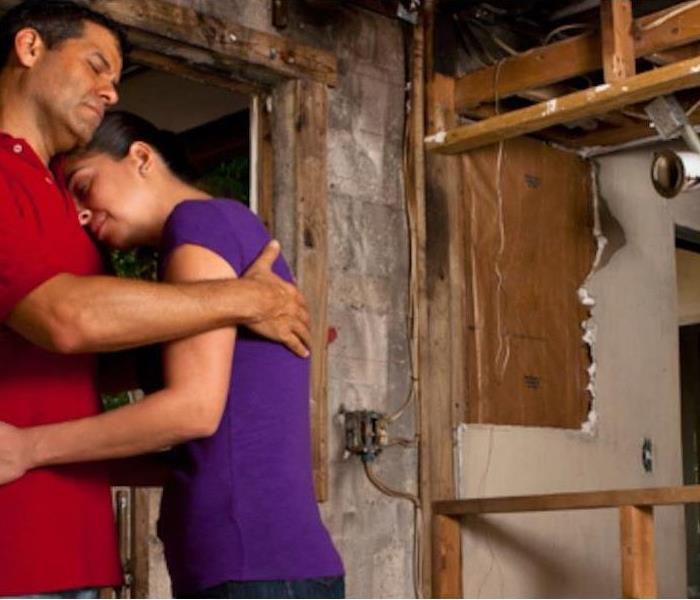 fire damage
fire damage
Nothing is as devastating to a home as a fire. Even a small kitchen or electrical fire can result in widespread devastation, but a fire damage company in Weymouth will restore your home to its pre-blaze condition.
If the aftermath of a fire has you scrambling to figure out where to start the recovery process, our guide will help you take the first steps and know what to expect going forward.
Why Do You Need Professional Fire Damage Restoration?
Once the fire department puts out the flames, a fire restoration company comes in to appraise the damage and develop a recovery plan. Specialists use a meticulous, step-by-step checklist to gauge every potential form of fire damage, including the effects of:
- Water
- Chemicals
- Smoke
- Soot
- Odors
In addition to causing structural damage, a fire contaminates everything in its path with toxins. A fire damage restoration company can identify and mitigate all the issues that can pop up, ensuring your family can live in the home without risk of injury or illness.
A Checklist for Dealing With Fire Damage
After a disaster, our fire damage company completes a comprehensive checklist of tasks to repair and clean your property. The process may take several weeks or months, depending on how much work needs to be done.
Step 1: Assessment and Securing the Property
The process begins with a comprehensive assessment of the structural, smoke, and soot damage. Our restoration specialists will determine what they can salvage from the scene, if anything, and the best approach to handling smoke damage cleanup, soot elimination, and reconstruction. A fire can significantly impact the structural stability of any building, and we look for hidden damage that might not be immediately apparent but still requires attention.
Once we document the situation for insurance purposes, we’ll secure the property to create a safe environment for cleanup and prevent further damage. This could include putting tarps over exposed areas, removing debris, boarding up windows, or installing structural supports.
Step 2: Preventing Further Damage
Firefighters use water and chemicals to extinguish the flames, which can cause secondary damage like mold, rot, rust, and health risks.
After safely removing any damaged materials that are beyond repair, water damage remediation is usually the first step. This process includes removing excess water and using industrial fans and dehumidifiers to dry out walls, floors, and other affected areas. If the fire department used suppressants to put out the flames, chemical damage restoration to seal the residue and prevent further contamination may also be necessary.
Step 3: Soot and Smoke Damage Cleanup
Porous surfaces, like upholstery and carpets, are especially vulnerable to soot damage. Soot is made up of carbon particles from partially burned materials, and it's a known carcinogen. To eliminate these pollutants and the health risks they cause, we deep clean affected surfaces with specialized equipment, powerful cleaning agents, and air filters.
Addressing smoke damage is complex, as the odor can cling to surfaces and infiltrate tiny spaces that are easy to overlook. We'll clean and deodorize salvageable personal items, including clothing and furniture, to return them to pre-fire condition. However, electronics and appliances may require replacement because smoke can destroy sensitive mechanical components.
We use several methods to eliminate unpleasant and lingering smoke odors, including thermal fogging or ozone treatments to break down the particles and remove the smell.
Step 4: Rebuilding
Rebuilding begins once the cleanup is complete. For some homeowners, this means reconstructing entire rooms or sections of the home and roof, while for others, it entails relatively minor projects like replacing drywall, countertops, and flooring, repainting walls, and making electrical or plumbing repairs or replacements. Structural repairs are the final step in returning your property to the same or similar condition it was in before the incident.
Turn To SERVPRO of Weymouth, Hingham, and Quincy for Help After a Disaster
Looking at the charred remains of your home, smelling the smoke, and dealing with the aftermath of losing treasured belongings to the flames is an emotional and often overwhelming experience. You need a compassionate and experienced team on your side that has the professional expertise and tools to help you get back on your feet.
SERVPRO of Weymouth, Hingham, and Quincy is the Massachusetts fire damage company to call when the unthinkable happens to your South Shore home. When you call us at (781) 337-0344, the local specialists will be there fast to answer questions and get started with recovery and restoration. Thanks to our IICRC certification and top Better Business Bureau rating, you can relax knowing our disaster cleanup professionals have everything under control.
Boston’s Common Causes of Water Damage
11/13/2023 (Permalink)
 Protect your home by learning the most common signs of water damage in Boston with this comprehensive guide from SERVPRO of Weymouth, Hingham, and Qui
Protect your home by learning the most common signs of water damage in Boston with this comprehensive guide from SERVPRO of Weymouth, Hingham, and Qui
Water-related disasters can strike your Boston home or business at any time, leaving you with costly property damage. Still, knowing how flooding can happen will help you be more mindful and alert to problems before they cause significant issues for your property. Here, learn some of the most common ways water damage in Boston occurs.
Leaky Plumbing
Plumbing leaks and burst pipes are two of the most common ways properties sustain water damage. Pipes can leak due to corrosion, weak pipe joints, and intense water pressure. Extreme pressure and freezing temperatures contribute to burst pipes.
Though minor leaks can cause property damage over time, a burst pipe can lead to major flooding. Unfortunately, it can be hard to locate the source of a plumbing leak because pipes can be behind walls, under sinks, and in other less noticeable areas.
Gutter Clogs
Your gutter system is an essential part of your roofing system because it allows rainwater and snowmelt to flow off the roof and away from your home's foundation. Unfortunately, gutters can quickly clog with leaves, dirt, and other debris. As a result, water from the roof will flow over the gutters and down the building's siding.
A clogged gutter can create water damage around your roof's edges, your siding, and your foundation. If enough water collects around the outside of your house, the moisture can seep indoors and increase the risk of water damage and mold growth.
Malfunctioning Appliances
Washing machines, boilers, dishwashers, and refrigerators are major appliances that many Bostonians use daily. However, these appliances are more likely to develop leaks and other damages over time due to wear and tear.
Even a persistent drip from a leaky hose is enough to cause water damage to your home. Unfortunately, you might not notice your appliance is faulty or worn until weeks or months later unless you can see the water puddling around it. Many appliances leak from the back where the damage isn't obvious right away.
Weather
Boston is no stranger to adverse weather, which can sometimes lead to flooding and water damage in homes and businesses. For example, heavy rains and significant snowmelt could overwhelm drainage systems, causing water to back up inside a building. Intense winds can also damage roofing shingles and allow rainwater to seep inside.
Air Conditioning Leaks
You might not think about your HVAC system causing water damage, but it could. When air conditioners work correctly, they absorb heat and moisture from indoor air during a heat transfer. The moisture condenses inside the system before going into an overflow pan or drain pan.
The water inside the drain pan then goes outside of the property by way of the condensate line. However, if the line has a clog, the pan will overflow. Water can leak from the overflow pan if that component suffers damage or if the air conditioner's drainage system malfunctions.
Roofing Issues
Water damage in Boston isn't always a major event. Sometimes the damage occurs slowly over time from something as small as a minor roof leak.
Unless you regularly keep up with your roof's maintenance, you might not be aware of loose shingles or small penetrations that allow moisture to get into the roofing system's underlayment. It only takes an inch of water to create several pounds of weight on roofing, which will eventually cause the structure to weaken and allow water inside your home.
Loose shingles aren't the only thing to cause roof leaks. Damaged roof membranes, neglected drainage, and faulty perimeter flashing can also be problematic.
Faulty Sump Pumps
If your home has a basement, it should also have a sump pump. A sump pump is a device that draws water from a basin in the lowest part of a basement or crawlspace to prevent flooding. Without a functional device, your basement is vulnerable to moisture seepage from groundwater, cracks in the foundation, and other sources.
Ensure your sump pump works correctly by regularly inspecting it for leaks and other damage, like a float switch stuck in the "on" or "off" position.
Turn to SERVPRO of Weymouth, Hingham and Quincy for Boston Water Damage Restoration
Our team at SERVPRO of Weymouth, Hingham and Quincy understand how overwhelming and stressful water damage in Boston can be. That's why we proudly offer residential and commercial restoration services including water and fire damage restoration, mold removal, and storm cleanup.
With our IICRC accreditation, an A+ rating with the Better Business Bureau, and advanced cleaning equipment, we're confident in our ability to mitigate water damage and restore properties. Call (781) 337-0344 or fill out our contact form to request help from SERVPRO of Weymouth, Hingham and Quincy in Boston.
Does Insurance Cover Flood Cleanup?
11/7/2023 (Permalink)
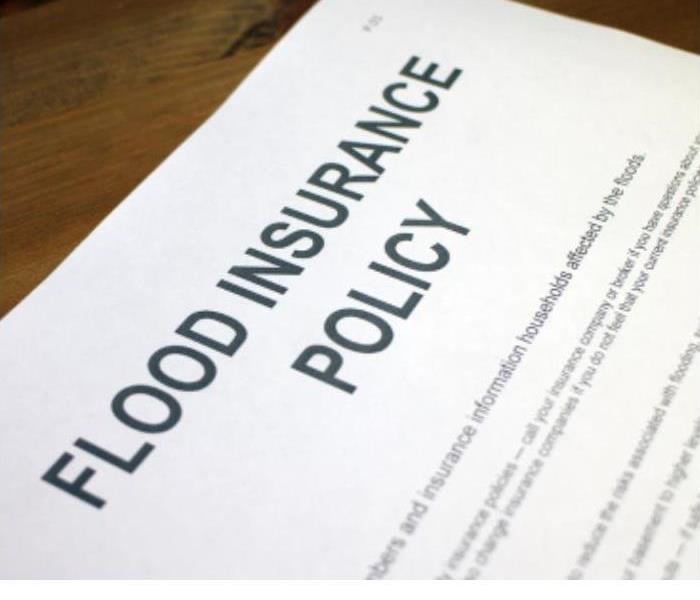 Learn more about homeowners insurance policies and flood cleanup coverage.
Learn more about homeowners insurance policies and flood cleanup coverage.
There is often a lot of confusion around what is and isn’t covered by a standard homeowners insurance policy. One of the biggest misunderstandings surrounds water and flood damage. Many people don’t know whether a water intrusion event is covered by their insurance company because they don’t know how it is classified.
In order to learn more about how insurance and flood cleanup coverage works, homeowners should keep reading this guide from SERVPRO of Weymouth, Hingham, and Quincy. Throughout their time offering flood cleanup services in Weymouth and the surrounding areas, they have had the opportunity to help countless customers with their insurance claims. Therefore, they can provide more information on how to get flood cleanup insurance coverage.
What is the Difference Between Water Damage and Flood Damage?
In general, most homeowners insurance policies do not cover flood damage. However, they may cover other water intrusion events. Therefore, it’s important that homeowners understand what types of events are considered water damage and what events would be classified as flood damage.
Water Damage
Most homeowners insurance policies classify an event as water damage if the source of the water came from within the home, such as a faulty appliance or plumbing issue. They may even cover a leaking roof or air conditioner. The one catch is that they may not cover water damage that could have been prevented.
Flood Damage
When it comes to classifying an event as flood damage, the source of the water usually has to be natural. In many cases, it’s caused by a natural disaster, such as a severe storm or hurricane.
Since the terms water damage and flood damage are often used interchangeably, it’s important that homeowners refer to their specific policy to see what coverage they have. If they still have questions, the best solution is to contact the insurance company for clarification.
Does Rain Damage Count as Flood Damage?
As mentioned, flooding from severe storms is often counted as flood damage, but rain damage can go either way, depending on whether or not the rain caused a flooding event. Rain damage from a leaking roof is typically classified as storm damage instead of a flood. Therefore, many insurance providers will cover these types of losses.
If, on the other hand, a storm was so severe that it caused a flash flood, the damage from that rain would be considered flood damage. This type of event would not be covered by a standard insurance policy. However, there are ways that homeowners can protect themselves in case of flooding events.
What is Flood Insurance?
Flood insurance is an entirely separate policy that is specifically used to cover buildings impacted by floodwater. It may cover some rainwater damage, but it is mostly used to provide coverage for losses caused by natural disasters. These can include hurricanes, overflown lakes, or ocean water.
In some areas where flooding is more common, homeowners may be required to take out a flood insurance policy while they pay off their mortgage. However, it can also be a sound investment for people who own their homes.
Flood insurance can be taken out to cover the building, personal property, or both. Examples of items covered by flood insurance include:
- Appliances
- The Home & Foundation
- Carpet
- Curtains
- Detached Garages
- Permanently Installed Features
What Isn’t Covered by Flood Insurance?
Though there are many things that are covered under the umbrella of flood insurance, there are still many items or expenses that aren’t covered by the standard flood insurance policy. In general, homeowners will not be reimbursed for additional living expenses or financial losses from interruptions to business.
Any mold, mildew, or moisture not caused by the flooding event will not be covered either. Many insurance companies also limit coverage to the building itself and the property inside. This means that they usually won’t cover fences, wells, hot tubs, swimming pools, septic systems, or other property features outside of the insured building.
These are just general guidelines, however. Homeowners can modify policies with riders to make sure their coverage fits their specific needs. Therefore, it’s important that homeowners contact their insurance company to find out more about their coverage.
Get Professional Assistance with Filing a Claim for a Flood Cleanup
Fortunately, homeowners don’t have to stress over filing a claim for their flood cleanup. Professional restoration companies like SERVPRO of Weymouth, Hingham, and Quincy can take care of the entire claims process.
To learn more about their full-service flood cleanup solutions, submit their online contact form. A helpful representative will then reach out to provide more information. Homeowners can also call the 24/7 emergency number for immediate flood damage assistance.
Creating a Fire Escape and Restoration Plan for Your Business
11/1/2023 (Permalink)
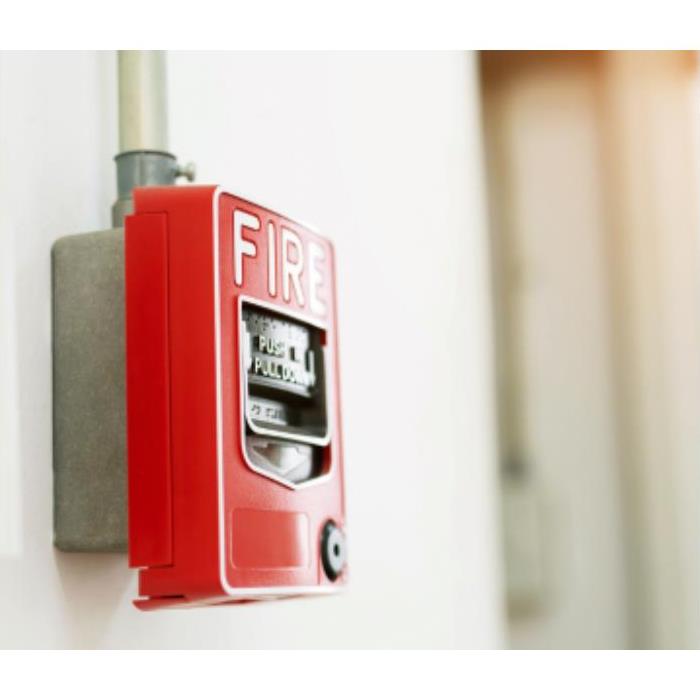 Don’t panic when a fire happens! Learn how your business can prepare for safe evacuations and effective fire damage restorations.
Don’t panic when a fire happens! Learn how your business can prepare for safe evacuations and effective fire damage restorations.
No one wants to experience a fire. They are traumatic, destructive, and dangerous. However, the reality is that it can happen at any time. For that reason, it’s important that businesses make sure they are prepared for the disaster if it should occur. In fact, it’s vital that owners create and communicate their evacuation plans with their employees to ensure everyone’s safety.
Preparations shouldn’t end with a basic fire escape plan, though. For the best results, businesses should also make sure that they are prepared for the restoration process that follows the evacuation. Otherwise, they could waste a lot of time and money while they complete the commercial fire damage restoration in Weymouth, MA.
In order to be safer and more efficient, business owners should keep reading this guide. They’ll learn more about steps they can take to create a safe escape route and an efficient restoration plan.
How to Create a Fire Escape Plan for Your Business
Safety should always be the first priority when considering how to deal with a commercial fire. Therefore, it’s crucial that business owners sit down and truly think of the safest way to help their customers and employees evacuate the building in the event of a fire. The following steps can help create a safe and effective plan.
Prepare for Multiple Scenarios
Fires are unpredictable, so fire evacuation plans should cover multiple scenarios. Listing all of the possibilities can help companies to create an action plan. During this process, it’s important to consider the specific risks that threaten a business and how they can impact a person’s ability to escape safely.
Define Roles and Responsibilities
To avoid chaos when a fire breaks out, every employee should know their role in the escape plan. The chief fire warden's role should be assigned to an employee who can handle the stressful situation and be responsible for any planning, prepping, or execution of the fire plan. Other roles can include route guides to help employees and customers evacuate calmly and floor monitors to make sure each room is clear.
Highlight Nearest Exits and Create Escape Routes
The best fire evacuation plans should have multiple routes in case of blockages. These routes should be communicated to all employees and displayed for reference throughout the building. They should point everyone towards the nearest exits, which should be clearly marked for fast action.
Understand Tools and Inspect Them Regularly
Fire codes require businesses to have specific fire safety tools, but they are only useful if employees know how to use them. It’s important to educate employees so that they are familiar with all of the available tools that can help them stay safe. It’s equally important that these tools be inspected routinely as well. For example, companies should test that fire alarm systems, lighting, and sprinklers are working properly.
Preparing for a Fire Restoration
Once everyone has exited the building safely, the hard work of completing a commercial fire damage restoration begins. Business owners should also have a plan for how to handle this process if they want to minimize their downtime. The following steps are the most crucial for successfully bouncing back after a major disaster.
Know Who to Call
First and foremost, companies should immediately know who they are going to call when a fire happens. While 911 is the obvious answer, that’s not the only call that needs to be made.
Business owners should also know which commercial fire damage restoration company they want to hire. It’s better to have a company picked out before they are needed so that no time is wasted searching the internet for the best local company.
Aside from looking at the restoration crew's experience, business owners should consider the contractor’s availability. Since fires can happen when they are least expected, it’s essential that the restoration company offers 24/7 emergency services.
Decide How to Operate Business
A fire doesn’t mean that a business has to close completely. If the fire is quickly extinguished, a company may be able to safely continue operations while the restoration is completed. However, this only works if the company has a plan in place. They should consider:
- Where business transactions will take place
- How many employees will be needed
- Alternative business locations
- How downtime will impact finances
Find out More About How to Prepare for a Commercial Fire Damage Restoration
Want to know more about how businesses can prepare for a fire? Contact SERVPRO of Weymouth, Hingham, and Quincy. Their commercial fire damage restoration company can provide more insight into their process. They are also available 24/7 for emergency assistance, so local companies should call right away.
How to Spot the Signs of Hidden Water Damage
10/4/2023 (Permalink)
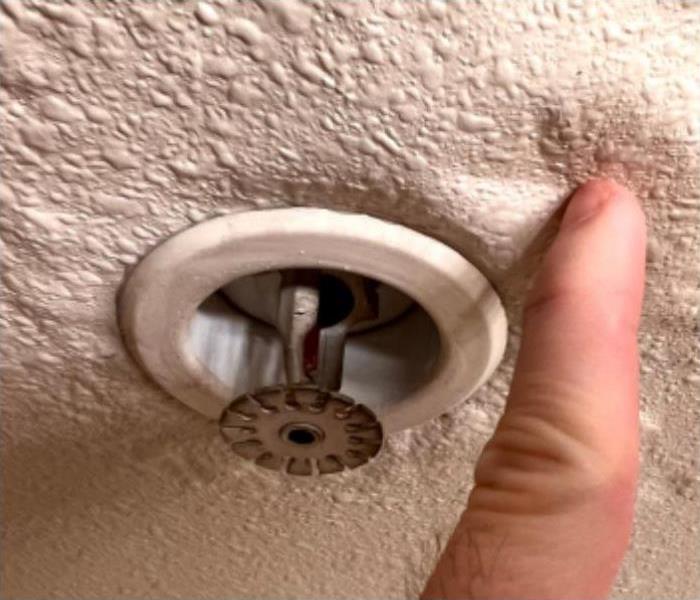 Water Damage Cleanup
Water Damage Cleanup
Water damage is a common cause of loss in new and old homes. However, it isn’t always a noticeable problem. In fact, there are many instances where water damage remains hidden for weeks or months.
Unfortunately, this only leads to more problems. Secondary water damage occurs when the initial mess isn’t cleaned up right away. In fact, problems like rot and mold can start to occur within 24 hours of the incident.
Therefore, it’s important that homeowners learn how to spot signs of hidden water damage. This guide from a professional water damage cleanup company details some of the most common indicators of a hidden water damage problem.
Mold Growth
One of the most obvious signs of water damage is mold growth. Mold thrives in areas that are dark, warm, and moist, which explains why it is so often associated with hidden water damage in floors, walls, and basements.
Homeowners may not notice mild mold growth right away if it is in a discrete location. Instead, it’s likely that the hidden water damage will lead to a major mold outbreak before it is finally discovered. In these cases, homeowners might notice physical symptoms of exposure before they can see the mold growth.
Musty Odors
Other homeowners might not realize they have a water damage problem until they start to notice a musty odor. While the smell is often associated with mold growth, it can occur even without any visible mold growth.
Though it might be tempting for some homeowners to cover up these smells, it’s important to identify where they are coming from. They could very well be the first sign of a hidden water leak.
Increase in Water Bill
Homeowners should also pay close attention to their utility bills. Water bills can be especially telling if there is a hidden leak inside the home. While there are a few reasons that a water bill might be higher than usual, a significant spike could indicate that the home has a leak in its plumbing.
Unfortunately, this sign doesn’t give homeowners much information on where the leak is located. Therefore, they may have to hire a professional water damage cleanup company to complete a thorough inspection of the property.
Stained or Discolored Walls
A very obvious sign of water damage is staining or discoloration of walls or ceilings. The drywall typically takes on a yellow or brown tint, and it can appear in rings, which indicates a recurring water leak.
Homeowners should always take these signs of water damage seriously because they could point to a much larger problem behind the drywall. In many cases, drywall cuts will need to be performed to identify the source of the water damage. However, leaking plumbing or roofs are often the cause of such hidden water damage.
Peeling or Blistering Paint & Wallpaper
Even if a homeowner paints over the stained drywall, the problem will still show itself. Paint and wallpaper can start to feel, chip, or blister as the drywall expands with water absorption. As the material soaks up more water, it eventually causes the drywall and paint to lose its adhesion.
It may first start with a few small bubbles, but when there is major water damage, it can eventually leave the home with huge pockets of water. Homeowners should never pop these bubbles. Instead, they should contact a water damage cleanup company right away.
Warped Floors
Ceilings and walls aren’t the only areas of the home that can indicate a water damage problem. Homeowners should also pay close attention to their flooring. Hardwood floors are especially prone to warping, cupping, or blistering when exposed to water. If the initial signs are ignored, the hidden water damage can eventually lead to rot in the wood.
Homeowners with carpet should still look out for signs of hidden water damage. Aside from feelings of dampness, the floors could also start to warp if the water is absorbed by the subfloor. It’s important that homeowners contact a professional right away if they notice warping or weakness in their floors as they could collapse from from too much water.
Request an Inspection from a Water Damage Cleanup Company
These are just a few of the signs that could point to a hidden water damage problem, but homeowners shouldn’t assume that everything is fine if they don’t notice them. The best way to truly identify hidden water leaks is by hiring a professional to complete a thorough inspection.
SERVPRO of Weymouth, Hingham, and Quincy is an experienced water damage cleanup company, so local customers can count on them to find leaks in walls, ceilings, and other hidden areas. Call or fill out their online form to request an inspection today!
Professional vs. DIY Water Damage Mitigation
10/4/2023 (Permalink)
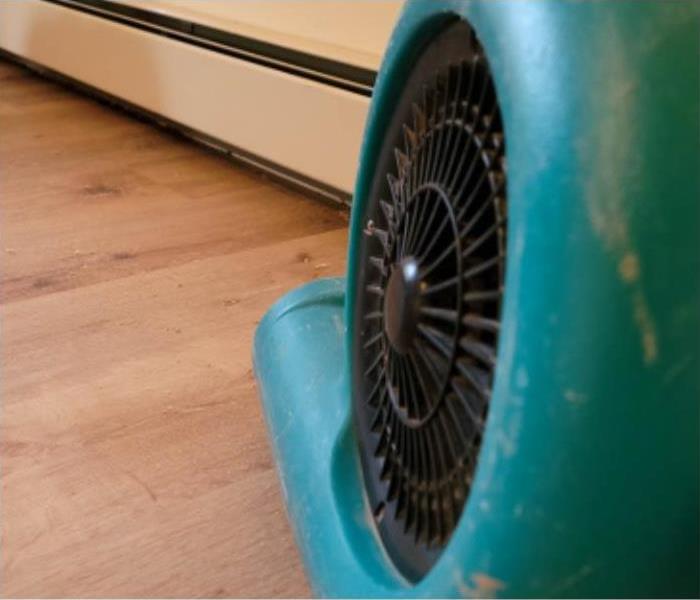 Not sure if a professional or DIY water mitigation is right for you? Compare the two options with this helpful guide!
Not sure if a professional or DIY water mitigation is right for you? Compare the two options with this helpful guide!
Whether dealing with a slow leak or a major flood, handling water damage mitigation is no small task. Not only is there the initial damage and cleanup to consider, but there’s also the possibility of long-term effects, such as rot and mold. In fact, dangerous mold can start to grow in as little as 24 hours following a water damage or flooding event.
For that reason, it’s important that homeowners act fast and try to mitigate further loss, especially when it comes to water mitigation. However, many people often procrastinate as they weigh their options of hiring a professional versus completing the job themselves.
Each option has its own pros and cons, so customers should take that into consideration. This guide helps break down the main differences between a professional and DIY water damage mitigation.
Cost
One of the most considerable differences between a professional and DIY water mitigation is the price. Homeowners who choose the DIY route often do so because it is the more affordable option. However, there are some cases where it could turn out to be more expensive than expected. This is especially true if there is hidden damage or future mold growth.
Professional water mitigation services can cost hundreds or thousands of dollars. While this might seem off-putting, this option could provide homeowners with a better return by ensuring the job gets done right the first time.
Time
Many homeowners are eager to get started on their water mitigation right away, so they start the cleanup on their own. While it might be faster to get started without waiting on a professional, the amount of time to complete the whole job usually takes much longer. Many people underestimate how long drying and cleaning takes, and they fail to realize how their work and family life can interrupt the project.
The best water mitigation companies offer 24/7 emergency services, so homeowners shouldn’t have to wait long to start the cleanup process. Not to mention, their methods and equipment help them complete the mitigation much faster than a homeowner could complete a DIY job.
Expertise
The fact of the matter is that the average homeowner simply doesn’t have any experience with water damage mitigation. They don’t know the best methods for drying and cleaning, and they may unknowingly put themselves at risk for exposure to contaminants, electric shock, or other hazards.
When a homeowner chooses to hire a professional, they can rest assured that they have the training and certification to handle the job. The technicians have extensive knowledge and skills that allow them to effectively mitigate further damage.
Equipment
The average homeowner also doesn’t have access to the right equipment for water damage mitigation. If the leak was small enough, they may be able to use towels and mops, but if the event caused significant water damage, they’ll need access to bigger and more effective tools.
A professional water mitigation company should have access to a variety of tools that can aid in a quick cleanup. Not only do they have pumps and wet/dry vacuums that can speed up water extraction, but they also have moisture meters, infrared cameras, air movers, dehumidifiers, and other tools that let them achieve the best results.
Effectiveness
In general, a DIY water mitigation is far less effective than a professional job. Homeowners who choose this option are more likely to need professional services down the road as secondary water damage pops up.
By hiring a professional to start, homeowners can ensure the job gets done right the first time. Experts are thorough with checking the results and reading moisture levels when the job is finished. Many offer some kind of satisfaction guarantee as well.
Insurance Claims
Finally, homeowners who choose to DIY the cleanup may prefer to pay for the project with their homeowner's insurance. In this case, they also have to navigate the challenges of filing a claim on their own. Not only is this stressful, but if they make a mistake, they risk getting denied any coverage at all.
One of the greatest benefits of working with a professional is that they can assist with the insurance claims process. In fact, many will file the claim and handle negotiations with the adjuster on behalf of their customers. This cuts down on time and stress!
Request a Professional Water Mitigation from a Trusted Local Restoration Company
Interested in hiring a professional water mitigation company? Local customers should call SERVPRO of Weymouth, Hingham, and Quincy right away. They offer 24/7 emergency services, so they can help any time that a disaster strikes the area. Customers just need to call (781) 650-3901 or fill out their online contact form.
Top Tips for Effective Bad Weather Preparation
6/10/2023 (Permalink)
 Having flood insurance can help protect your property and get your property back to pre flooding conditions.
Having flood insurance can help protect your property and get your property back to pre flooding conditions.
As the saying goes, "hope for the best, but prepare for the worst." And when it comes to bad weather, this couldn't be more true. Whether it's a severe thunderstorm, tornado, hurricane, or blizzard, being prepared can make all the difference. In this blog post, we'll cover some important steps you can take to prepare yourself, your family, and your property for bad weather.
Create an Emergency Plan
The first step in preparing for bad weather is to create an emergency plan. This plan should include information such as evacuation routes, meeting places, and important contact numbers. Make sure that all members of your household are aware of the plan and have a copy of it. Additionally, consider practicing the plan with a mock emergency so that everyone is familiar with what to do in case of an actual emergency.
Stock Up on Supplies
In the event of bad weather, it's important to have enough supplies to last for at least 72 hours. This includes non-perishable food, water, first-aid supplies, and any necessary medications. You should also have a battery-powered radio, flashlights, and extra batteries on hand. Additionally, make sure that your cell phone is fully charged before the bad weather hits.
Secure Your Property
Bad weather can cause significant damage to your property, so it's important to take steps to secure it as much as possible. This can include trimming trees and removing any dead branches, securing loose items like patio furniture and trash cans, and reinforcing windows and doors. You may also want to consider investing in storm shutters or impact-resistant windows.
Stay Informed
Stay informed about the weather conditions by monitoring local news and weather reports. You can also sign up for alerts through your local emergency management agency or download a weather app that will send you alerts. If you're under a tornado watch or warning, take shelter immediately. If you're under a hurricane warning, follow any evacuation orders and make sure to take your emergency supplies with you.
Consider Flood Insurance
Flooding is a common occurrence during bad weather, and unfortunately, many homeowners' insurance policies do not cover flood damage. Consider purchasing a separate flood insurance policy to protect your property in the event of a flood. It's important to note that there is typically a 30-day waiting period before flood insurance coverage goes into effect, so don't wait until bad weather is on the horizon to purchase a policy.
In conclusion, preparing for bad weather is crucial for protecting yourself, your family, and your property. By creating an emergency plan, stocking up on supplies, securing your property, staying informed, and considering flood insurance, you can help ensure that you're ready for whatever Mother Nature may throw your way.
Fire and Electronics: Why You Should Consider Cleaning Your Devices After a Fire
4/6/2023 (Permalink)
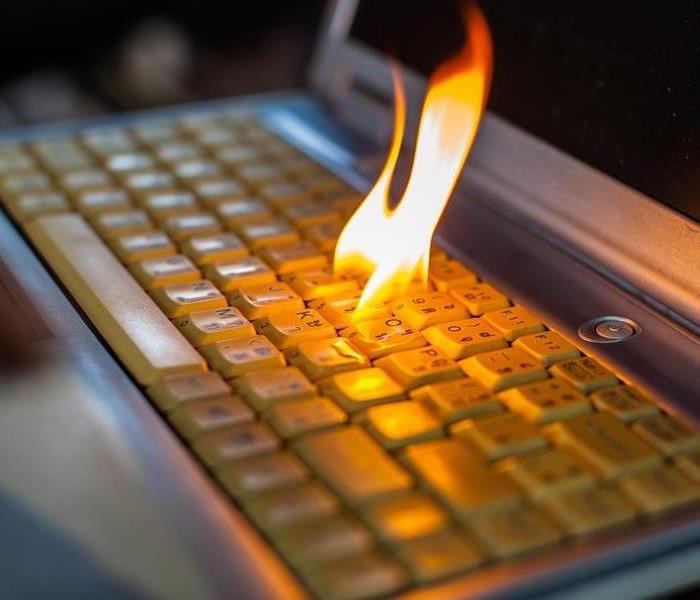 Cleaning fire damage electronics is important to prevent further damage.
Cleaning fire damage electronics is important to prevent further damage.
Electronics are a major part of our lives, and they can be destroyed by fire. A fire can damage your electronics in many ways, but one of the most important things to consider is how it will affect the health of you and your family. If you have an electronic item that was damaged by a fire, it's important to get it cleaned as soon as possible so that no further damage is done.
In this article we'll discuss why it's necessary for electronics to be cleaned after a fire, what happens if they aren't cleaned and some tips about how best to clean them yourself at home or with professional help from an expert technician.
Types of Damages
The different types of damage that can be caused by fire include:
Smoke damage. This is the most obvious sign of a fire, as it leaves behind a black sooty residue on your electronics.
Soot damage. As well as smoke, there's also an oily film that covers everything in its path when there has been an electrical fire or other type of combustion involving heat (like cooking). This film can cause corrosion over time if not cleaned off regularly, which can lead to further damage down the line if left untreated.
Water damage from sprinklers or hoses used by firefighters during extinguishment efforts may also cause problems with internal components like circuit boards and wiring harnesses if not dried out quickly enough after exposure--and even then some degree of corrosion may still occur due to residual moisture trapped inside certain areas within the device itself after being exposed directly outdoors for extended periods at high temperatures (i..e., 80 degrees Fahrenheit).
Reasons for Cleaning
Cleaning electronics can prevent further damage to the device. For example, if your laptop has been exposed to smoke or soot from the fire, it may be damaged beyond repair if left uncleaned for too long. This can happen even if the laptop looks fine when you first pick it up after putting out the flames in your house or office building.
Having your electronics cleaned by a professional is important because they may not work properly without being cleaned first, especially if they were exposed directly to heat or smoke during a fire!
It’s Important to have a certified Water Damage Expert
3/29/2023 (Permalink)
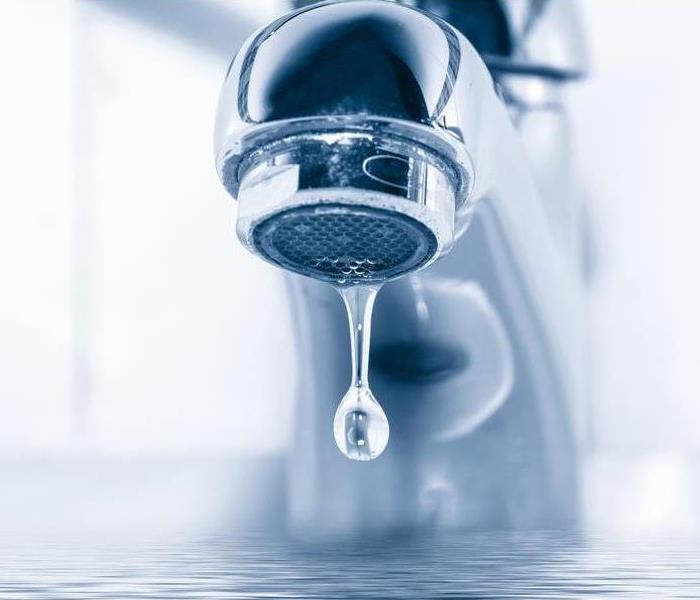 When your home or business suffers from a water loss, give SERVPRO a call today.
When your home or business suffers from a water loss, give SERVPRO a call today.
Water damage is one of the most common disasters that can happen to your home or business. Water damage restoration is an important step in making sure that you can get your property back to preloss condition as soon as possible. The certified water damage experts at SERVPRO are here for all of your water damage and flood restoration needs, whether it's a residential or commercial property. We offer 24/7 emergency services to ensure that our customers have the best service available when they need it most.
Water Damage and Water Restoration Experts
Water damage can be a big problem. It's important to find an expert who has the training and experience to properly handle your water loss. A certified water damage expert has access to the equipment required for drying out your property, as well as knowledge about how to prevent mold growth and other structural problems that may occur during the drying process.
Water Damage & Mold Remediation
Mold is a natural part of the environment, but it can cause secondary damages to property if not treated properly. Mold remediation requires special training and equipment to avoid damaging your home or office in the cleanup process.
Water damage restoration companies are certified by organizations like IICRC to perform water extraction, drying, sanitizing and other services that ensure proper safety while they dry out your home or business so you can return as soon as possible with minimal loss of property value.
Upholstery Cleaning And Restoration
When it comes to water damage, there are many things that must be done in order for your upholstery to be restored. The first step is removing all of the excess water from your furniture. Then, we will use our specialized equipment and cleaning solutions to remove mold and mildew from any fabrics that have been affected by the moisture. Once this has been completed, we can begin restoring your fabric back to its original state by cleaning it thoroughly with odorless disinfectants or antimicrobial rinses. We also offer deodorizing treatments for those who want their furniture smelling fresh again!
We understand how important it is for you not only get rid of odors but also stains on upholstery as well--and we're happy to help with both! Our technicians at SERVPRO are trained professionals who know exactly how best go about removing stains from different types of materials like leathers and rayons without causing further damage (like fading). They'll even teach you some tips along the way so next time something happens where there's an accident involving water damage , whether at home or work, you'll know exactly what steps need taken right away.
Carpet Cleaning Services
Carpet cleaning is an art form, and there are a variety of methods that can be used. The most common types include dry cleaning, steam cleaning, shampooing and vacuuming. The type of carpet you have will determine which method is best for you. In some cases odor removal may be necessary as well.
24-Hour Emergency Service
A certified water damage expert can help you with 24-hour emergency service, which means that you will get fast response time for any type of water damage situation, including basement floods and burst pipes. With this level of expertise, you can be confident that your home or business will be restored quickly and efficiently.
A certified water damage restoration company has the equipment and personnel necessary to extract standing water from your property quickly so it doesn't have time to cause further damage. They'll also ensure that all salvageable items are dried out before they are disposed of in order to prevent mold growth and structural rotting later on down the road
When it comes to your home or business, it's important to have the right people working on the job. The professionals at SERVPRO are certified by IICRC and have years of experience working with water damage and mold remediation services. We're here 24/7 in case of emergencies so you can trust that we'll always be there when you need us most.
What to do when your toilet overflows
2/13/2023 (Permalink)
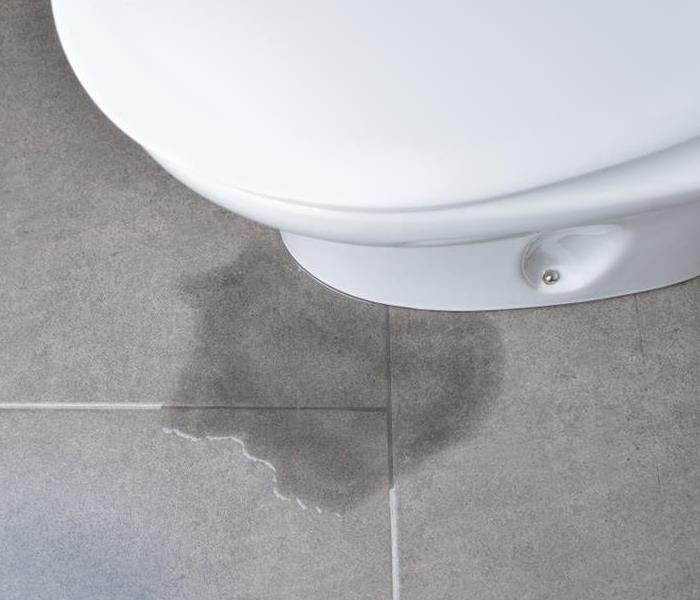 When you see water from the toilet, give SERVPRO a call at the first sign of water damage.
When you see water from the toilet, give SERVPRO a call at the first sign of water damage.
A toilet overflow is a serious problem that needs immediate attention. If not addressed immediately, it can cause extensive damage to your home. There are many reasons a toilet can malfunction in your home leaving water damage in your home or business.
Common Cause
A clogged toilet or pipe is one of the most common causes of an overflowing toilet. If you've recently flushed something that shouldn't have been flushed, such as greenery or paper towels, your toilet may be clogged. If you don't know how to unclog it yourself, call a plumber right away!
If your septic tank is dirty or full, this can cause sewage backups into homes and basements through drains and pipes that run under buildings as well. The best way to prevent this issue is by having regular septic system maintenance checks performed on your home and hopefully preventing any issues before they start!
Black water
In addition to the mess and damage, black water from a toilet overflow contains harmful bacteria and viruses that can lead to other issues throughout your home. It's best not to touch or inhale black water from an overflowing toilet because it may contain bacteria. The first thing to do in case of an overflowing toilet is to switch off the valve next to its base. If you are not sure where it is, look for a lever or knob on one side of the toilet that can be pushed down and pulled up again. This will turn off water flow into your home's supply system until further notice.
Shut off Main Valve
Next, if you haven't already done so, shut off the water supply at the main valve. This may be inside or outside of your home depending on how old it is and whether or not it has been renovated. If there's no shutoff valve next to your toilet (or if you can't find one), call a plumber immediately.
You'll want to turn off both hot and cold valves on either side of each faucet before shutting off those main ones since they're connected by pipes under pressure and could spring leaks otherwise.
Clean up
If any surrounding areas are soaked in water, soak up as much excess water as possible using towels. If you have a vacuum cleaner with a hose attachment, it may be helpful to use it to remove excess standing water from the area around your toilet bowl. If there is any standing water left after this step, and especially if this is an ongoing issue, it's best to call a plumber instead of trying to fix it yourself with tools like mops and brooms that could cause further damage if used improperly
Call a professional Restoration Service
If you have a minor overflow, it may be tempting to try to clean up the mess yourself. However, even if you think that your bathroom is still usable after an overflow incident, it is important to call a professional restoration service like SERVPRO as soon as possible.
A professional restoration service can help you evaluate how much damage has been done and determine how best to restore your property back to its original state. They will also ensure that all of their work complies with local regulations so that future problems do not occur again.
Even if you don't think your overflow was major or urgent enough for SERVPRO services, we would still recommend calling them right away so they can begin working on getting things back into order before things get worse.
Testing Your Smoke Detectors
1/23/2023 (Permalink)
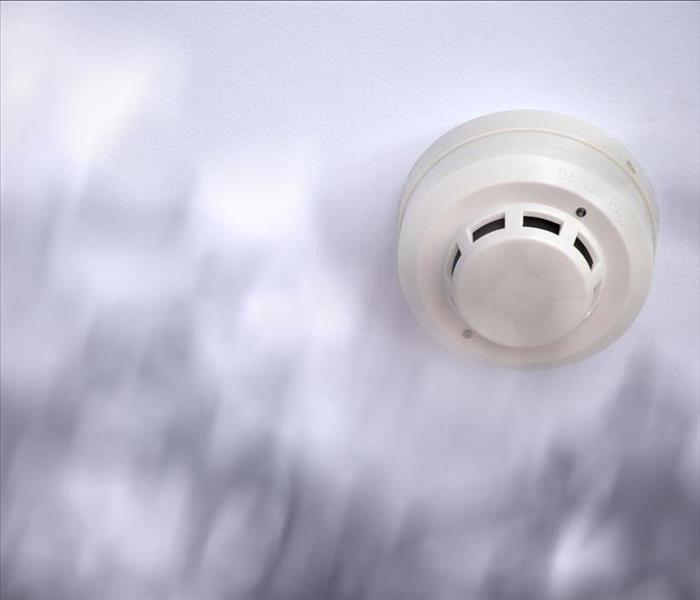 Regular testing of smoke detectors is essential for ensuring that they are in good working condition and will alert you to a fire.
Regular testing of smoke detectors is essential for ensuring that they are in good working condition and will alert you to a fire.
Smoke detectors are an essential part of any home's fire safety system. These devices detect smoke and alert you to the presence of a fire, giving you valuable time to evacuate your home and call for help. However, like any other piece of equipment, smoke detectors need to be tested regularly to ensure that they are working properly. In this blog post, we will discuss the importance of testing your smoke detectors and provide step-by-step instructions for how to do so.
Why Test Your Smoke Detectors?
Smoke detectors are designed to alert you to the presence of a fire, but if they are not working properly, they cannot do their job. Regular testing ensures that your smoke detectors are in good working condition, so you can be confident that they will alert you in case of a fire.
It is important to test your smoke detectors because it ensures that they are in good working condition and will alert you to a fire. Regular testing helps you identify and fix any problems with your smoke detectors, such as low batteries or faulty sensors before they become a bigger issue. Additionally, testing your smoke detectors regularly will give you peace of mind, knowing that in case of an emergency, your smoke detectors will work to protect you and your loved ones.
How to Test Your Smoke Detectors
Testing your smoke detectors is a relatively simple process that can be done in just a few minutes. Here are the steps you should follow:
1. Locate your smoke detectors. These devices should be located on every level of your home, including the basement and attic, as well as outside each sleeping area.
2. Press the test button. Most smoke detectors have a test button that you can press to simulate smoke and test the alarm. Press the button and wait for the alarm to sound.
3. Check for any issues. If the alarm does not sound, or if it sounds weak, it could indicate a problem with the device. Check the batteries, and if they are low, replace them. If the problem persists, the detector may need to be replaced.
4. Repeat the process for all smoke detectors in your home.
It's important to note that most smoke detectors will have a test button and you should follow the manufacturer's instructions for your specific device.
In conclusion, regular testing of smoke detectors is essential for ensuring that they are in good working condition and will alert you to a fire. By following the steps outlined in this blog post, you can be confident that your smoke detectors are working properly and will keep you and your family safe. Don't forget to test your smoke detectors at least once a month and change the batteries twice a year.
If your Weymouth home experiences a fire, SERVPRO of Weymouth, Hingham, and Quincy is here to help you get back to normal. Give us a call when you need mitigation and restoration work!
Top Causes of Kitchen Fires
12/25/2022 (Permalink)
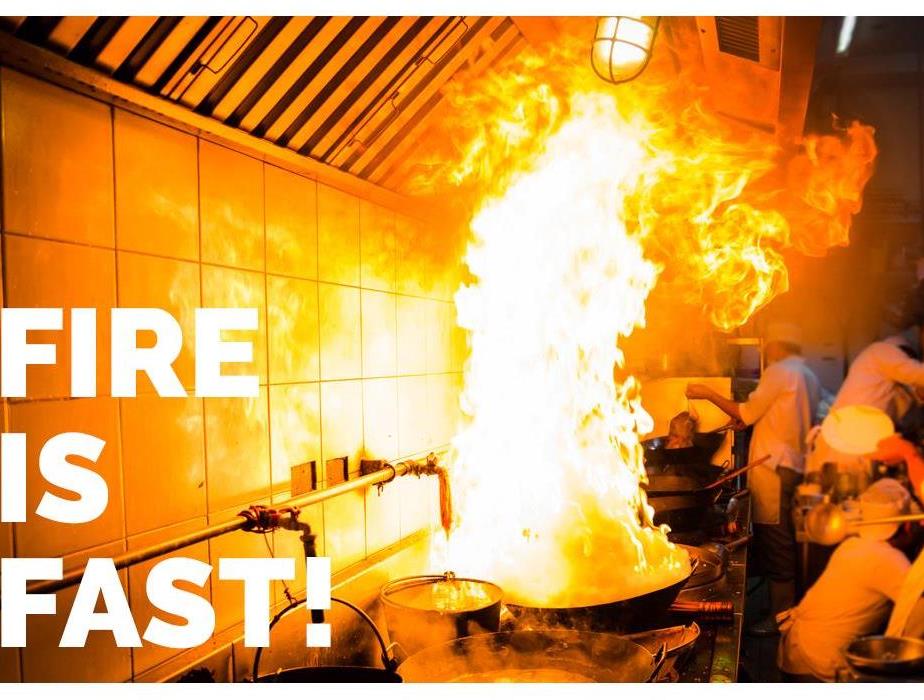 Keep flammable materials away from heat sources
Keep flammable materials away from heat sources
Top Causes of Kitchen Fires
Cooking is an essential part of the daily routine in any home. Whether you're preparing a meal, baking a cake or brewing coffee, these activities take place in the kitchen. However, it's not just about making food — cooking can also be dangerous if left unattended. According to the National Fire Protection Association (NFPA), there are more than 50,000 residential fires each year caused by cooking equipment.
Cooking appliances
Electrical fires are a serious risk in the kitchen. Properly grounding your wires, using surge protectors, and unplugging appliances when they're not in use will help to reduce fire risks.
When you're cooking, be sure to keep an eye on your pans, ovens, and appliances. Some common cooking equipment that commonly starts fires include:
• Ovens
• Stoves
• Microwave ovens
It's also important to avoid electrical shocks, especially with young children around who may be unable to recognize the danger of touching exposed wires or when an appliance suddenly gets hot. Always keep small appliances away from water, including during cleaning and draining; if cleaning is necessary, unplug them first before wiping down surfaces with a damp cloth.
Remember that most electrical fires start with frayed or damaged wiring—if you notice any signs of wear on your cords or plugs (such as cracking plastic), replace them immediately!
Unattended cooking
Unattended cooking is one of the most common causes of kitchen fires. Cooking oil, butter, and other fats can catch fire if you leave them sitting on a hot stove for too long. It's best to keep an eye on the food you're cooking and never leave it unattended. If you want to make sure that this doesn't happen to you, turn off the heat when something starts smoking or burning. Even if it looks like your pan is perfectly safe, turn off the stove just in case!
If you leave a pan unattended on a burner while it is still hot, it may ignite as well. It’s also important not to overfill your pans with food when cooking—this increases the likelihood that steam will rise off your pan before being released through its vents. This is an excellent way for grease fires to start!
Heating equipment
A kitchen fire can occur when you use anything that produces heat, such as a range, oven or microwave. To prevent a fire:
- Keep flammable materials away from heat sources.
- Check all appliances for damage before using them. Do not use damaged appliances until they have been repaired and restored to their original state.
- Never operate cooking devices while you are sleeping, absent or otherwise distracted by other tasks in the kitchen (this includes cell phones). Always pay attention to what is happening around you so that you notice if something starts to burn or smoke too much before it becomes dangerous
Kitchen fires are a year-round danger.
As soon as you step in the kitchen, you're at risk of having a fire. That's why it's important to be prepared and know what to do if your home catches on fire.
Kitchen fires are more common in the winter because people often use their ovens more during this season than any other time of year. Oven fires can start when something ignites inside a cooking appliance or while you're grilling outside on your patio grill.
Summer is also known for its high temperatures and hot days, which means that there's plenty of heat around your stovetop and oven —and plenty of potential sources for ignition too! If left unattended, these hot surfaces present risks for starting an oven fire or even grill flare-up when combined with grease or oil spilled onto them by careless preparation techniques.
To prevent a fire:
- Keep flammable materials away from heat sources.
- Check all appliances for damage before using them. Do not use damaged appliances until they have been repaired and restored to their original state.
- Never operate cooking equipment while you are sleeping, absent, or otherwise distracted by other tasks in the kitchen. Always pay attention to what is happening around you so that you notice if something starts to burn or smoke too much before it becomes dangerous.
Kitchen fires can be risky, but they don’t have to be. With the right safety measures in place, you can enjoy your kitchen without worrying about it catching fire.
How to Stop your Kitchen Sink from Leaking
11/2/2022 (Permalink)
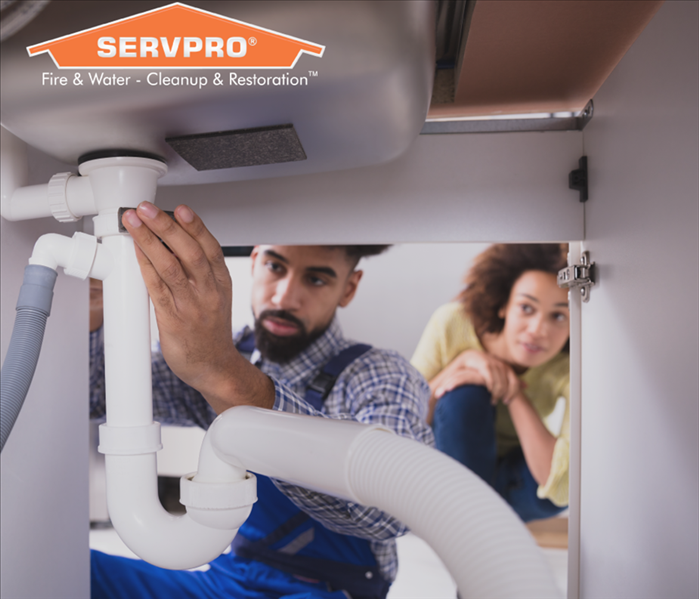 If you try fixing your sink and it still doesn't work call a professional.
If you try fixing your sink and it still doesn't work call a professional.
How to Stop your Kitchen Sink from Leaking
If you've got a leaky kitchen sink, don't panic. This is one of the most common plumbing problems, and it's often easy to fix yourself. The first thing you need to know is where the leak is coming from, but this can be tricky because your drain may not have any water in it when there's no leak. That said, here are some common causes for leaks as well as ways to diagnose them:
Turn off the water supply to your sink.
The best way to do this is by turning off the faucet in the sink and then turning off the main water supply valve. This will stop all of your water from going anywhere, including into your kitchen cabinets or drain pipes.
Shut off the garbage disposal. If you have a garbage disposal and it's turned on, shut it down now so that it doesn't make any noise while you're working on fixing things below ground level. If it makes too much noise or feels like something else has stopped working altogether, see if there are any other things in your home that need attention; otherwise, just leave everything alone until later when we'll come back here with some tips on what needs repairing next!
Tighten the fittings
If you're experiencing a leak at the base of your kitchen sink, it could be because the fittings are loose. To stop this from happening, remove the faucet and tighten its nut by turning it clockwise with an adjustable wrench. Then replace the faucet.
If this doesn't fix your problem, there may be other issues at play—but don't worry!
Tighten the faucet connection
If you've ruled out the above causes of dripping water, it's likely that your faucet is leaking. To fix this problem, use an adjustable wrench or pliers to remove the nut that holds the faucet to your sink, then adjust it so that it's tight enough but not too tight. Finally, put everything back together and try running some hot water through both taps: if they continue to drip after they're turned off again (or don't turn off at all), you'll need more TLC from a professional plumber.
If you have a leaky kitchen sink, try tightening the various parts of it yourself before calling in a plumber.
If you've got a leaky kitchen sink and want to try fixing it yourself before calling in a plumber, start by using the proper tools. This means using the correct wrench or spanner for each part of your sink. If you force something that's too large onto a part (like forcing an oversized pipe wrench onto an inch-long pipe), then you're more likely to strip the threads or break off pieces of plastic than if you'd used something smaller. Having said that, don't be afraid to use some elbow grease—you should not be able to move any piece without applying some pressure!
If after trying everything above repeatedly and being unable to stop your sink from leaking, call a plumber.
Kitchen sinks can be difficult to fix, but the good news is that you don’t have to call in a plumber every time. You can try and do it yourself by tightening the fittings and faucet connection until there is no more leaking. If your sink still leaks after trying these methods, then it may be time to call a professional!
How do I Create an Office Fire Escape Plan?
10/24/2022 (Permalink)
 Creating a fire escape plan is an essential part of any office building.
Creating a fire escape plan is an essential part of any office building.
Creating a Fire Escape Plan
What is a fire escape plan? Is it necessary?
Creating a fire escape plan is an essential part of any office building and is incredibly important for the safety of you and others on your property. This can be more complicated than it sounds, but it's important to understand the dangers that employees face while working in your business. With proper planning and preparation, you can safely evacuate everyone from your building if there's ever a fire or other emergency.
Identify all possible exit routes.
Identify all possible exit routes. Include escape routes from each room, common areas, and conference rooms as part of your plan. Also, consider the following:
- Determine the best escape routes from all locations in the building, including each room, common area, and conference room.
- Identify the exits closest to where you work, eat or sleep.
- Keep your workplace fire escape plan with you at all times in case of an emergency.
- Review your personal evacuation plan with co-workers when new employees join your company or if there are changes to an existing plan (e.g., remodeling).
Designate a "safe area" to meet outside of the building.
Designate a "safe area" to meet outside of the building. A safe area is a meeting place outside of the building, where everyone can gather in case of emergency. It should be large enough to hold all employees and should be accessible from your fire escape route (if you have one). Identify one or more meeting locations in case you are separated from others during an emergency.
Walk through your fire escape plan with all employees.
Review and practice your fire escape plan with all employees. Walk through the plan with them, making sure everyone knows their role and where to meet if they need to evacuate the building.
Make sure you conduct regular fire drills as well as review your fire escape plan on a regular basis. By practicing these skills together, you can effectively reduce the risk of injury and death for both staff and visitors during an emergency.
Show staff evacuation routes
- Show staff evacuation routes.
- Walk staff through the plan.
- Practice the plan.
- Make sure everyone understands the plan.
Conclusion
Your company in Weymouth, MA, and surrounding areas should always have a fire escape plan in place before any emergency arises. This will help ensure that everyone knows what to do in the event of an emergency and can quickly get out of harm's way. The fire department will also be able to access your building more easily because they'll know exactly where it's located.
Putting a Stop to a Toilet That Won’t Stop Flushing
8/27/2022 (Permalink)
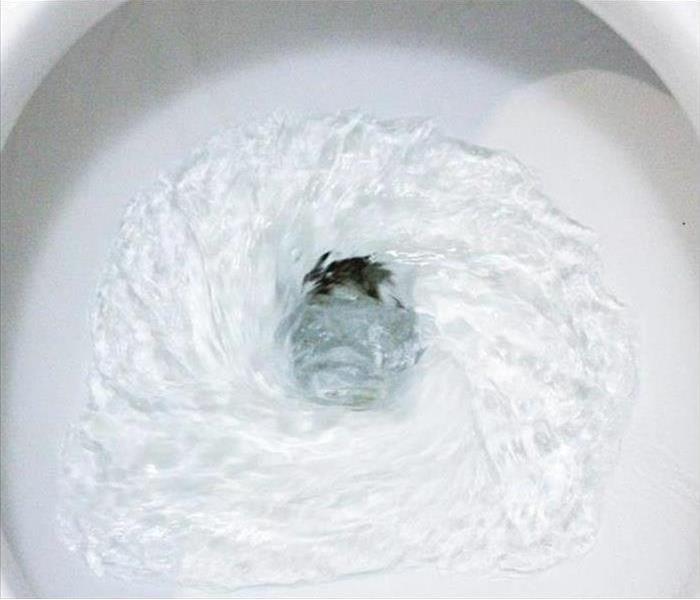 Don’t ignore a toilet that continues to flush.
Don’t ignore a toilet that continues to flush.
Stopping a Toilet That Won't Stop Flushing
A toilet that won’t stop flushing may not seem like a big deal, but toilet overflow can pose serious problems not just for the bathroom but for other parts of your commercial property as well. As a toilet flushes, more water enters the toilet and can possibly spill over, seeping into the floor or the wall.
This can lead to water damage and mold growth in your building in Weymouth, MA. Water on the floor is not only a potential slipping hazard, but it may also contain odors that impact the usability of your bathroom. It’s important to stop a toilet from continuous flushing that can lead to flooding.
Fixing the Flushometer
The flushometer Is a component that controls the flushing on a commercial toilet. Here’s how you can prevent a toilet flood by fixing the flushometer:
- Use a flathead screwdriver to turn off the flushometer on a manual system. This is usually to the left or the right of the toilet’s pipe connection to the wall.
- Remove flange cover.
- Remove the gasket and clean thoroughly, including the weep hole. You may need to use a small, thin object to really clean the weep hole.
- Replace gasket and flange cover and turn on flushometer.
- An automatic flushometer may require servicing.
Consult a professional water damage restoration specialist to make repairs and remediation for items impacted by toilet overflow. These pros are fully equipped and experienced in making any repairs necessary to bring your space back to pre-damage conditions. If any specialized techniques or approaches are needed such as odor control and disinfection, they will know best how to apply them.
Trusting the Professionals
While addressing a flushing toilet is something you may be able to do yourself, you should leave the cleanup to a professional remediation service. Your custodial staff cannot fully repair and remediate any spaces or objects impacted by the water damage of toilet overflow. If your business or that of your tenants’ is interrupted by the damage, the professionals can minimize the repair period.
Don’t ignore a toilet that continues to flush. It can lead to serious damage, requiring commercial building restoration.
3 Ways To Mitigate Storm Damage at Your Business
8/22/2022 (Permalink)
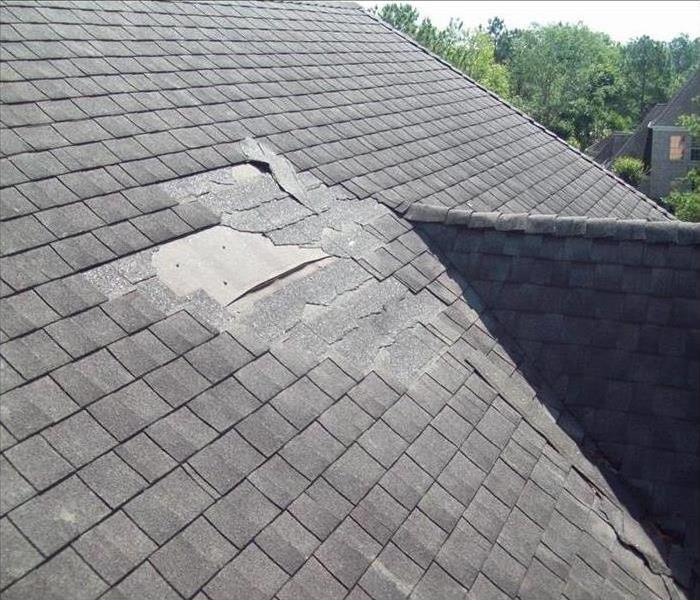 If damage, such as missing shingles, does occur it’s best to contact a local storm damage restoration service
If damage, such as missing shingles, does occur it’s best to contact a local storm damage restoration service
Three Tips To Protect Your Building From Storm Damage
If you're worried about a storm causing a roof leak at your Weymouth Landing, MA, place of business, then you may like to know that there are a number of ways to mitigate storm damage. Here are three things you can do to help protect your company.
1. Know the Weather
It’s a good idea to keep an eye on the weather reports for your area. This way you will know ahead of time if a storm is approaching and what its projected severity is. This will allow you to prepare if the storm has high winds or heavy rain that could cause a damaged roof or freezing temperatures that might lead to a pipe break.
2. Prepare Ahead of Time
When you know a storm is coming you can take steps to prevent a roof leak or other possible damages. If you are worried about a particular part of the property you can board or tarp over the space for additional protections. Trim back dead trees or overhanging branches to prevent wind from tearing them loose and throwing them into the building. Additionally, you may want to clean up loose landscaping or move any lawn decorations or loose signage inside until the storm has passed.
3. Act Quickly
If damage, such as missing shingles, does occur it’s best to contact a local storm damage restoration service as quickly as possible in order to help make repairs. Acting quickly can allow these repairs to be made before additional damage has a chance to happen. It’s also helpful to board or tarp over the damaged area to protect it until repairs can be completed.
Mitigating the possibility of roof leaks at your place of business is possible. Remember to keep an eye on the projected weather, prepare the property ahead of time, and act quickly to make repairs if damage does occur. Remember, if you have any questions a professional can help.
The Basics of Insurance Deductibles
8/17/2022 (Permalink)
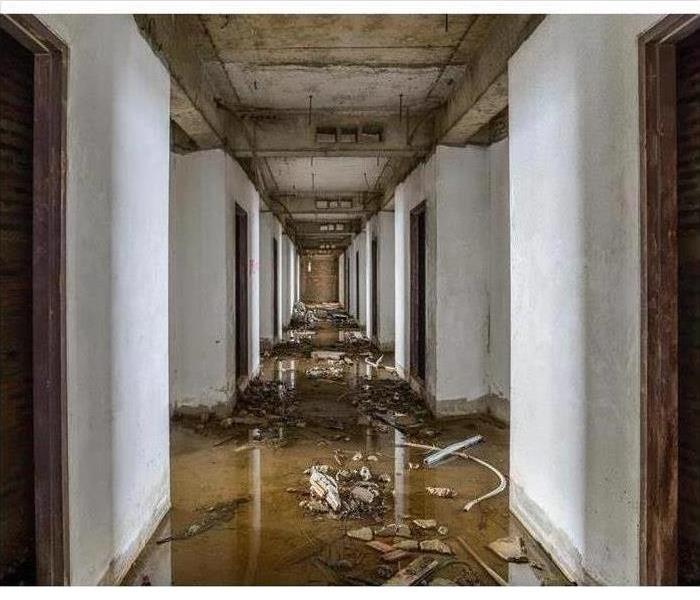 Flooded building in Weymouth, MA.
Flooded building in Weymouth, MA.
Here's How Storm Deductibles Typically Work
Your commercial insurance coverage depends on the specific needs of your business in Weymouth, MA, and several factors can play a role. If, for example, you live in a Special Hazard Flood Area, storm insurance may be mandated by law. Some type of flood coverage is probably a good idea if your area experiences frequent precipitation or rainy seasons.
The amount of money you end up paying with a storm policy is a delicate balance of your premium and your deductible. Essentially, the deductible is the money you must pay out of pocket before the coverage kicks in.
Typical vs. Trigger
Usually, an insurance policy will have a standard deductible. That is, there is a set amount that you will be expected to pay for restoration services or repairs before the insurance company will contribute. Some storm insurance, however, has a trigger clause that activates a different set of rules for the deductible if a storm is nigh. Required conditions for a storm deductible to be triggered often include:
- Official storm watch or warning issued by the National Weather Service
- The intensity of the storm defined
- The specific time frame during the storm when the damage occurred
Standard vs. Percentage
A standard deductible is a fixed amount that the policyholder must pay before insurance pays for any of the damage. In areas that are particularly susceptible to storm damage, however, a percentage deductible may be applied to minimize the risk for the insurance company. Percentage deductibles take the total value of the property and base the deductible on that amount. These deductibles can be as low as 1% of the total value of the property or as much as 5%, depending on the level of risk the location of the property poses.
No matter what kind of deductible your insurance company offers for your storm insurance, it is still a good policy to have. Your insurance agent can detail the benefits of purchasing a storm policy for your business.
All About Flood Cuts
7/20/2022 (Permalink)
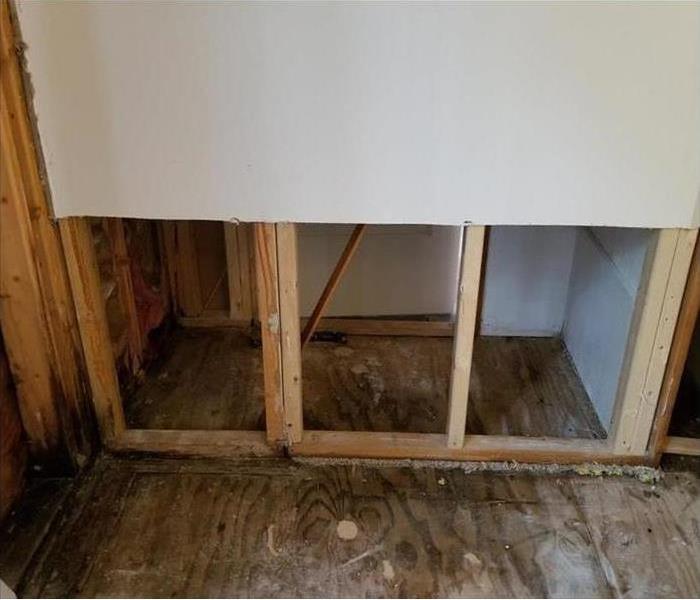 Flood cut performed in a North Weymouth, MA company
Flood cut performed in a North Weymouth, MA company
Understanding What A Flood Cut Is
If you have recently had to speak with a flood cleanup company, you may have heard some terms you didn't understand. Dealing with flooding is a stressful time, but if you know what some of these terms mean, the cleanup process can seem a little easier. Here are the answers to three common questions about one of these terms you will hear when in search of a restoration company, flood cuts.
1. What Is a Flood Cut?
A flood cut is when the contractor has to cut and tear out the drywall from your property. This cut is 12-18 inches above where the flood damage stops on your wall. A flood cut is necessary to remove the drywall affected by flooding and address moisture problems in the wall.
2. Is It Always Necessary?
This cut is not always necessary. If the wall was damaged by clean water, the wall can generally be saved. It is a different story if your walls faced contamination by sewage or other types of dirty water. In these instances, the rule is generally anything that has been touched, must be removed.
3. Can My Walls Be Saved Without Removing the Drywall?
If your walls were affected by clean water and there is no insulation behind the drywall, you may be able to dry out the area using minimally invasive procedures. For instance, your contractor may be able to drill holes in the baseboard and insert airtight hoses. These hoses will pass dry air into the wall, drying out the studs and drywall without making a mess. However, if you have insulation, a flood cut will be necessary.
One way to relieve the stress of dealing with flooding is to understand what a flood cut is and if it will be necessary. However, trusting your commercial storm restoration professionals to take care of the situation is the best way to reduce headaches when cleaning your building in North Weymouth, MA.
Avoiding House Fires: The Rules of Candle Use
7/12/2022 (Permalink)
 Don't leave candles unattended
Don't leave candles unattended
A Candle Fire May Lead to Significant Loss
Who doesn’t love a good-smelling candle? Those waxy sticks line store shelves with all those exotic names just enticing you to buy them and bring them home, making your house smell like some rustic northern cabin. While candles are great for setting the mood or creating ambiance, they also present a considerable risk to you and your home. A candle fire may lead to significant loss. Therefore, when using candles, it is a good idea to follow the rules of use.
1. Don’t Leave Candles Unattended
Never leave a lit candle unattended. The small flames on most candles may seem harmless enough, but if you leave the room for even a minute that candle may fall, causing that little flame to engulf your furniture, room or home.
2. Keep Away from Children and Pets
Children and pets likely do not have the capacity to successfully interfere if a candle fire starts. Also, animals and children probably do not have the foresight to understand that playing around an open flame of any kind is dangerous. Therefore, it is necessary to keep candles away from children and pets who are not supervised by a responsible adult.
3. Remove Flammable Items
While it may seem like a no-brainer, candles should never be placed near or on top of flammable items. All those Halloween pictures showing a candle on top of a stack of books are wrong, doing so puts you at significant risk for a house fire. Paper and an open flame do not belong together unless it is meant as kindling. The same can be said of fabrics. Be careful where you place candles, and always be mindful.
4. Consult a Fire Specialist
While it may seem like overkill, you can speak with a fire assessment specialist or a fireman in the Hingham, MA, area. These individuals are experienced in fire and smoke cleanup and will likely know the basics of candle safety.
A candle fire is a possibility when using candles regularly. However, it can be avoided by following the rules of candle use and safety.
How the Pros Restore Your Building After a Fire
6/22/2022 (Permalink)
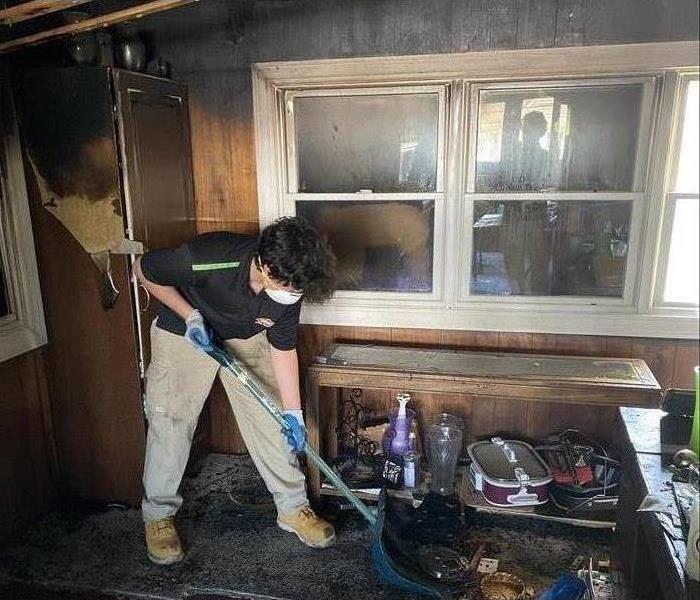 If your Weymouth, MA home or business has been damaged by fire, you can trust our SERVPRO of Weymouth & Hingham team to respond quickly.
If your Weymouth, MA home or business has been damaged by fire, you can trust our SERVPRO of Weymouth & Hingham team to respond quickly.
How Professionals Restore Your Building After a Fire
A fire can be devastating to any business. One could destroy your building, along with the materials and items inside. Fortunately, fire restoration is possible, even in the most severe circumstances. With the right professional response, you can once again safely work in your office building and even salvage your belongings inside.
1. Inspection and Board-Up
Your first step in a fire rebuild should be to call a professional disaster response and cleanup company. In the event of a fire, you can reach technicians 24/7. They should be able to arrive at the scene of the fire on the day of your call. Technicians will first examine the building to determine the extent of the damage. The team will then formulate a restoration plan. Technicians will begin by boarding up windows and doors, as well as tarping the roof. This provides security and safety in your Weymouth Landing, MA, building.
2. Removing Water and Smoke
In a fire, firefighters use a lot of water to extinguish the flames. This can leave standing water in some places, as well as significant water damage. The fire restoration process includes completely removing all water and thoroughly drying the affected area. Doing this reduces the risk of mold buildup. Using proven techniques, the technicians will also remove smoke and soot from the ceiling, floor, walls, and furniture.
3. Sanitizing
Getting rid of water and soot isn't enough. To prevent bacterial growth, technicians will also sanitize all surfaces in the building. The team will also make note of any items that technicians can save, and will clean and restore them. These include electronics, furniture, and documents.
4. Rebuilding Services
You'll want your building to look as good as new. The restoration team will repair and rebuild walls, building materials, and other areas of the structure and office that suffered loss.
For fire restoration, you need to rely on professionals. These steps can make your building a safe place to work once more.
Cleaning Water Damage in Your Rental Property
6/14/2022 (Permalink)
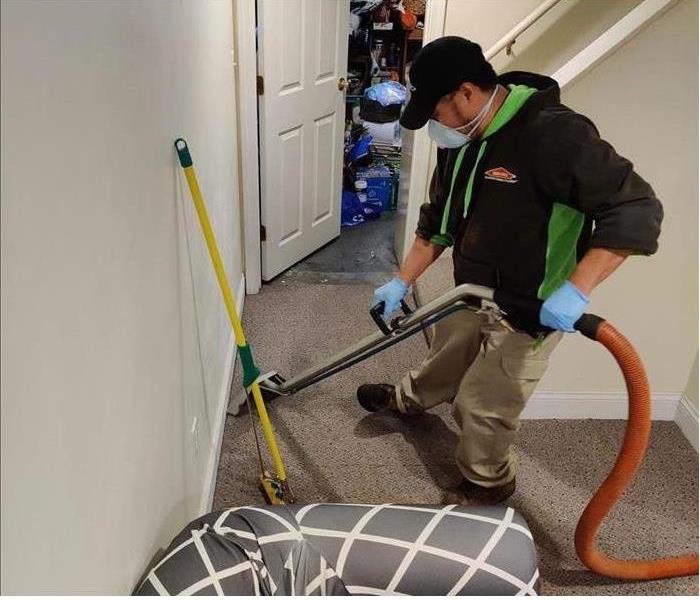 Powerful Pumps Quickly Remove Water After A Loss
Powerful Pumps Quickly Remove Water After A Loss
Water Damage Repair in Your Rental Property
When you have water in your home for rent after a flood, broken pipe, or storm in Hingham, MA, you compete against the clock. It's essential to remove the moisture from the belongings as quickly as possible to avoid mold or permanent damage.
Use Proper Equipment
Some items you need include:
- Waterproof boots
- Protective gloves
- Safety goggles
- Buckets
- Shovels
- Wet/dry vacuum
Get In When You Can
When it is safe to enter the property, do so but get clearance first from your local authorities. Assess the damage and determine what you can do.
You may need to call a professional remediation specialist if you have extensive damage from water in your home for rent. The company can assist with water removal, dry cleaning delicate items, remodeling, and repairing.
If the property has power and it's safe to use it, turn on the air conditioner to help dry the space. Use a dehumidifier as well. Leave the windows closed unless you don't have air conditioning. In that case, run fans to move the air around and open the windows to increase circulation.
Assess the Belongings
Mop excess water from the floors. Wipe down wood furniture with dry towels. Take wet cushions off of couches and chairs and prop them up to dry. Slide aluminum foil sheets between furniture legs and wet carpet.
Rinse belongings with clear water if they are wet. If they're already dry, dust them with a soft brush or cloth to remove residue. Soak wet photographs in water until they separate — do not pull them apart. Air dry them by clipping them to a rope or wire or lay them flat on absorbent paper.
Wet fabrics are heavier than dry ones. Don't stack them up. Remove debris with gently running clean water and blot them dry.
Remove as much water in your home for rent as soon as you safely can. Call a professional remediation company if you have extensive damage.
How to Stay on Top of Good Plumbing Maintenance
6/8/2022 (Permalink)
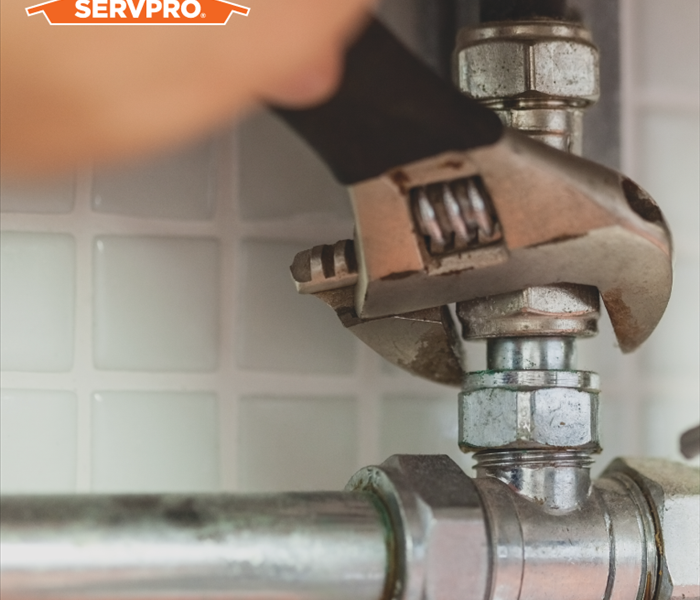 Plumbing problems can cause flooding and expensive cleanup in your Weymouth, MA home and commercial property.
Plumbing problems can cause flooding and expensive cleanup in your Weymouth, MA home and commercial property.
How to Stay Ahead of the Game When It Comes to Plumbing Maintenance
As a homeowner, you realize that at some point you'll have to repair and replace appliances as well as tend to other maintenance needs. Good maintenance and upkeep of your Weymouth, MA, home can help to prevent serious issues. Plumbing problems can cause flooding and expensive cleanup. By following basic tips, you can be proactive and spot concerns before they get worse.
1. Keep the Valves Working Well
This step is an easy one but one that many residents in Weymouth, MA , neglect. About once a year, turn off and on the valves where the pipes meet the wall. This helps to reduce the risk of leaks and a broken pipe. It will contribute to longer-lasting valves and a healthy plumbing system.
2. Flush the Water Heater
You rely on your water heater every day for warm water. Over time, sediment and other debris will accumulate in the appliance. This can lead to plumbing problems and affect the water heater's performance. You should do this once a year. To properly flush it, attach a hose to the drain valve and let the water drain from it.
3. Have a Professional Take a Look
You should periodically look at the pipes in your home for damage. Keep an eye out for leaks as well. If you notice other plumbing concerns, act quickly. These may include clogged drains or odd noises such as banging, whistling, or hissing.
However, you may not always spot plumbing issues. An experienced professional can inspect the water main, sewer line, and other components. This thorough inspection should take place each year or as you suspect problems. You can also consult with professional water cleanup companies about how to avoid water damage.
Plumbing problems can cause flooding and create widespread damage to your home. You can have peace of mind and avoid a catastrophe by following these steps.
What To Do and Not To Do After a Flood
5/27/2022 (Permalink)
 When we say that we are Faster To Any Size Disaster, we mean it! No matter what day or hour the loss strikes your home, our team is ready to serve you
When we say that we are Faster To Any Size Disaster, we mean it! No matter what day or hour the loss strikes your home, our team is ready to serve you
After A Flood, What Should You Do And What Shouldn't You Do
Your home should be a refuge and a place of comfort and protection. Unfortunately, issues can arise and bring flood water into your house. The severity of these events can vary. Still, if you face this type of emergency, there are things you need to do and avoid. Following proper guidelines can keep you safe and minimize the damage to your Quincy, MA, home.
1. Stop the Source and Turn off the Electricity
Various problems can lead to flooding in your home. If the source is a burst pipe, turn off the main water to the building. Shut off the electricity too, if it is safe to do so. Call a professional for help if you can't get to the breaker box without touching water.
2. Get Out of the Flooded Home
When you spot a flood and water damage in your Quincy, MA, house, evacuate and get to a safe place far away from the reach of any flood water. Make sure you account for everyone in your household upon evacuation.
3. Don't Neglect Calling for Help
Even small floods in your house can cause severe damage. Contact emergency authorities to assess potential hazards. Then call your insurance company. Depending on the type of flooding, your homeowners insurance may help pay for the costs.
4. Don't Try To Clean Everything Yourself
Cleaning up after a flood can be a significant task. You shouldn't have to feel overwhelmed. Contact a professional flood cleanup company for help. This seasoned team of specialists has the training and tools to thoroughly remove all water from the premises. The technicians will also be able to mitigate and clean up mold damage and other effects of flooding.
Flood water can have drastic impacts on your home and family. If you follow these guidelines, you can avoid crucial mistakes in response.
How To Clean Your Bathtub After a Sewage Backup
5/24/2022 (Permalink)
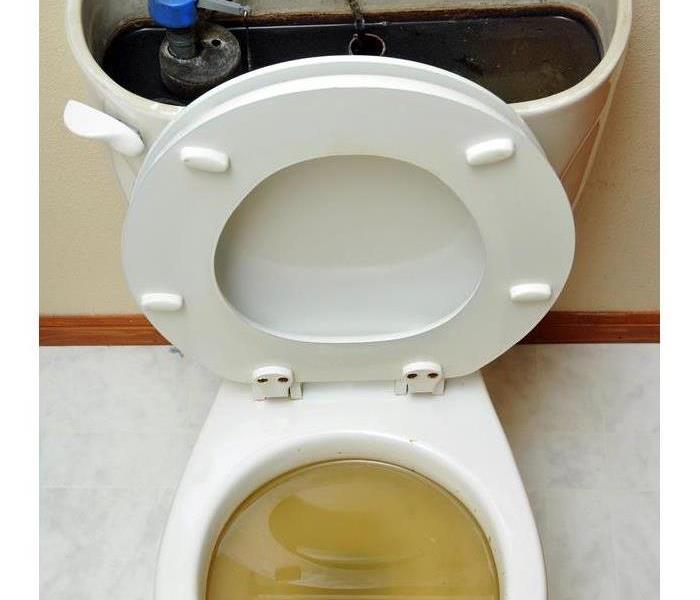 You will likely need professional help if sewage has flooded the floor or if you don't feel comfortable handling raw sewage.
You will likely need professional help if sewage has flooded the floor or if you don't feel comfortable handling raw sewage.
How To Clean A Sewage Backup In A Bathtub
Your sewer line can become clogged and result in your bathtub backing up. Don't worry, though, because you can always get help cleaning up your tub after a sewer backup in Hingham, MA, even if you have trouble doing it yourself. Follow these steps for cleaning up.
1. Determine Who Should Clean Up
Ascertain whether you should clean up yourself or whether you need to enlist professional cleaning and restoration services. You will likely need professional help if sewage has flooded the floor or if you don't feel comfortable handling raw sewage. You can attempt cleanup yourself if the sewage has not flowed outside of the tub, but professional help can save you the hassle.
2. Gather Equipment
Gather your gear before starting cleanup so the process is as simple as possible. You will need bleach, some water, a mild detergent and either a scrub brush or a sponge. It can be helpful to use disposable rubber gloves as well.
3. Remove the Bathtub Backup Debris
Remove all solid debris from the tub and place it into the garbage instead of the toilet. Trying to flush all this matter can result in the toilet overflowing and flooding your bathroom, so be sure to refrain from doing so. Sewer backup debris might include toilet paper, feces, hair or other solid particles.
4. Scrub It Clean
Scrub the tub thoroughly using a one-to-one mix of water and bleach. Clean the tub again using a mild detergent such as dish soap and a sponge to remove sticky residue. If the residue is particularly stubborn, use a soft-bristled brush. Whether you use a brush or a sponge, be sure that it is designated for bathroom use, not kitchen use, and disinfect it with bleach afterward. Once the tub is scrubbed clean, rinse it out.
These are the basic steps for cleaning up your tub after a sewer backup. After all that hard work, you might want to treat yourself to a nice bath in your clean tub!
4 Signs It’s the Right Fire Restoration Company
5/19/2022 (Permalink)
4 Signs You've Found The Right Fire Restoration Firm
The aftermath of a fire in your Quincy, MA, business is a messy situation. Along with needing smoke cleanup, there is likely water damage. Choosing a professional water and fire damage restoration company helps ensure the property is restored to preloss condition. But how do you know it’s the right company? Below are four indicators you’ve chosen correctly.
1. Commercial Fire Restoration Certified
A company that is licensed means that it has been certified by the IICRC. This requires regular certification, providing added peace of mind that the company adheres to established regulations and rules. The company will make it clear that it is certified.
2. Available 24/7
Since a disaster may strike at any time of the day, as well as during non-business hours, you need a trusted provider that is available 24/7. Round-the-clock communication and assistance are essential when there is fire and water damage. After receiving the call, the right company should be able to have an inspector scheduled to complete an assessment within 48 hours.
3. Versatile, Trained Technicians
Knowing that the damage sustained may run the gamut from soot to mold, you need a one-stop fire damage restoration company that can handle all forms of damage. If you choose a company that only handles one element, it means added delays that waste time and money. A company with cross-trained technicians means limited disruptions and work that is done right regardless of the work that is required.
4. Insurance Expertise
A key component of restoration is working with your insurance provider. While you need to focus on keeping operations going, an experienced restoration company will have the know-how to work directly with your insurance provider to ease the process.
Getting back to normal operations after a fire is vital to the success of a company. Choosing the right fire damage restoration company helps make that happen faster.
Maintaining Your Furnace To Prevent Fire Hazards
4/30/2022 (Permalink)
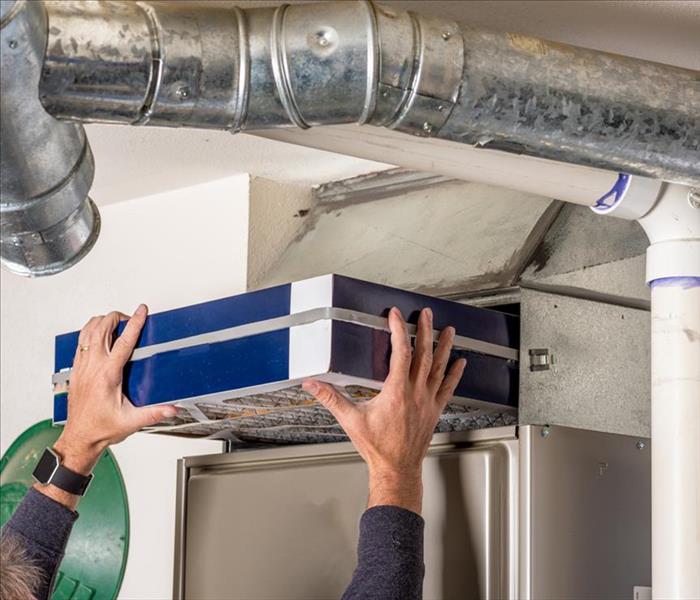 Homeowners should know that HVAC systems can become fire hazards without routine maintenance.
Homeowners should know that HVAC systems can become fire hazards without routine maintenance.
Preventing Fires By Maintaining Your Furnace
A residential fire is among the most common concerns for new and existing homeowners. While having insurance is nice for the aftermath of fire cleaning, it is not a preventative tool for the initial loss and devastation. One of the main contributors to fire risks in homes is poorly maintained HVAC units. According to many fire restoration professionals in Weymouth Landing, MA, maintaining these vital systems is a crucial component of any fire prevention plan. You can take four steps to ensure the operational integrity of your system.
1. Routinely Replace Filters
HVAC air filters need replacing every 30 to 90 days. The more people or pets you have in your home means the frequency is increased, especially with smokers in the house, smoke cleaning reduces the lifespan of a filter. Most professionals recommend changing air filters every 30 days to ensure optimum air quality.
2. Keep All Vents Clear and Open
Many people will close off vents in rooms they do not use often, but that is not a good idea. When you seal a vent, the HVAC system may need to work harder to maintain temperatures in the house.
People also have a tendency to place furniture over vents, leading to potential fire hazards. If you would like to avoid fire cleaning, keep vents clear. Your HVAC system works best with open and clear vents. If the temp seems off, consider contacting a professional to perform an assessment.
3. Perform Routine Inspections
Performing DIY assessments weekly or monthly is quite useful. You know your system and can likely identify slight changes better than others. Drastic changes in operation might require professional attention, but frequent DIY checks allow for early professional intervention.
4. Hire a Professional for Biannual Inspections
At least twice per year--the spring and fall--you will want to call a professional for a full system inspection. Professionals can identify problems early, ensuring you do not go the winter without heat.
Homeowners should know that HVAC systems can become fire hazards without routine maintenance. To prevent such dangers, use prevention and fire cleaning services to help, keeping up with maintenance schedules.
When Should You Replace Bathroom Supply Lines?
4/26/2022 (Permalink)
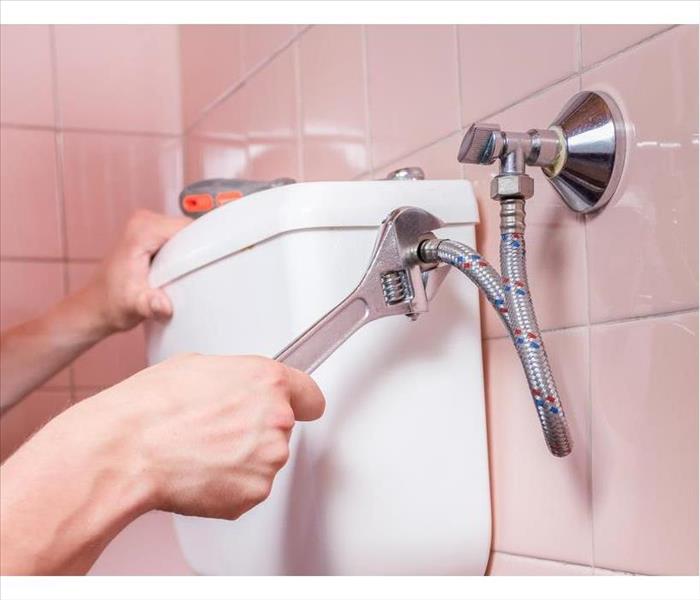 Examine the warranty carefully for signs of supply line damage. Water damage can be avoided by taking preventative measures.
Examine the warranty carefully for signs of supply line damage. Water damage can be avoided by taking preventative measures.
When Should Bathroom Supply Lines Be Replaced?
The supply lines in a bathroom may be rated to last anywhere from five years up to decades based on the material. Manufacturers’ warranties can give homeowners a good sense of when these lines should be replaced. Supply line damage may necessitate replacement sooner rather than later at a home in Weymouth, MA.
Check the Supply Line Warranty
The warranty on different types of supply lines range from five years up to a lifetime. Here are the average warranty lengths for common supply line materials:
- Copper lines may have 50 year or lifetime warranties
- PEX lines may have a 25 year warranty
- CPVC lines may have a 10 year warrant
- PVC lines may have a five to eight year warranty
The covered causes of malfunction vary based on usage. Although specifics vary, warranties give homeowners an idea of the length of time for which you can expect properly installed pipes to function without elevated risk of a bathroom leak.
Inspect Supply Line Condition
It is important to look for any signs of supply line damage regardless of the age of pipes. Make sure fittings are intact and in good condition and that pipes do not show signs of wear.
Replace Burst or Leaking Lines
While it is helpful to replace lines in advance of a supply line leak or break, homeowners often disregard these components until an emergency occurs. A plumber can replace broken lines, but experts can also inspect plumbing on a regular basis to anticipate disaster and prevent a pipe break.
If a line fails before the end of the warranty period under normal conditions of use, it may be possible to reduce the expenses associated with replacement. Carefully read the warranty and look for indications of supply line damage. Taking a proactive approach may make it possible to avoid major water damage at a residence located in Weymouth, MA.
Emergency Kit Preparedness for Businesses
4/19/2022 (Permalink)
 Only after an injured person has been treated should you call a commercial storm restoration service for assessment and repairs.
Only after an injured person has been treated should you call a commercial storm restoration service for assessment and repairs.
Business Emergency Kit Preparation
Are you ready in case a storm causes your office's windows to shatter and someone gets cut? What if the roof caves in with someone working underneath? Having a first aid kit on hand is essential to making sure you are able to handle these as well as any other perilous scenarios. Use the following information to properly assemble and maintain one for your business.
Emergency Kit Inclusions
Prestocked kits are available for purchase, although some office managers elect to put one together on their own. If you choose to create one, make sure yours includes:
- Multiple size gauze pads
- Variously shaped bandages
- Medical tape
- Scissors
- Tweezers
- Splints
- Wound cleaners
This list does not include many other items that should be included. Perform further research on what belongs before deciding if your first aid kit is complete.
Emergency Kit Management
Diligent emergency kit management is absolutely essential. Pick a smart location where yours will be stored. Make it an obvious spot that isn't prone to experiencing extreme temperatures. Inform everyone where it will stay and provide instructions on easily accessing it during a crisis.
Check your kit in Hingham, MA, once a month for any missing items and swiftly replace anything that has been removed. Perform this chore on the first of each month and become proactive about what other components you think should be added.
Have an emergency medical plan in place.
Train staff on the best ways to respond to these stressful situations. Emphasize that injured workers remain a priority over fixing structural damage to your building. Only after a wounded individual has been treated should you call a commercial storm restoration service to conduct an assessment and make repairs.
It is impossible to thoroughly eliminate the peril that comes with extreme weather conditions. You can, however, protect yourself and others with a comprehensive, well-designed first aid kit. Make sure your workspace has a good one in place.
Best Practices for Avoiding a Grill Fire
3/22/2022 (Permalink)
 A simple practice such as grill cleaning can eliminate many fires.
A simple practice such as grill cleaning can eliminate many fires.
The Best Ways To Avoid A Grill Fire
Many people in the spring and summer enjoy cooking out on a grill. While this activity is generally pretty safe, there are times when flames flare up and create a dangerous situation. If you are lucky, the only thing damaged is your meal. Sometimes, though, widespread damage to a garage, lawn or home results.
A simple practice such as grill cleaning can eliminate many fires. A dirty grill is often caked with flammable items such as grease and oil. Once these substances ignite, it is important to keep a calm attitude. Often the fire can be extinguished by turning off the grill and keeping the top closed.
The Role of Regular Grill Maintenance
It is crucial to make sure your grill is in good shape before turning it on. Make sure there are no loose parts or obvious problems with the grill. When you turn on the grill, make sure the fire looks stable. When it is time for grill cleaning, follow these steps:
- Turn off the grill and disconnect the propane tank
- Soak the grates and metal plates in a bucket of warm water and soap
- Use a grill brush to scrub dirty portions of the grill
- Empty the drip pan and soak it in the bucket
A thorough cleaning is the best way to avoid a grease fire. Proper maintenance increases the safety of your grill.
The Role of Fire Restoration
Any time a fire does break out in your home in Hingham, MA, it is important to call for professional help. An experienced fire remediation company will help you restore your home to its original condition. This includes removing all forms of soot and smoke damage as well as restoring any structural damage caused by the fire. In all areas of your home, it is important to practice fire safety. Grill cleaning is one simple way to protect your home from a devastating fire.
4 Ways SERVPRO Performance Guidelines Ensure Excellent Service
3/17/2022 (Permalink)
 If you are an insurance agent who needs a fast and reliable restoration option for your provider program, SERVPRO is here to help.
If you are an insurance agent who needs a fast and reliable restoration option for your provider program, SERVPRO is here to help.
SERVPRO's Performance Guidelines Ensure Excellent Service In Four Ways
The team at SERVPRO takes great pride in providing top-notch service to our clients. Whether you are an insurance agent or a business owner you can rest assured that our technicians have the skills, training and education they need to get the job done right. These are four of the ways our performance guidelines help ensure excellent service.
1. Institute of Inspection, Cleaning and Restoration Certification Validation
Our drying workbook is validated by the IICRC to ensure industry-standard practices are applied to every job. Insurance clients who choose to use SERVPRO as their vendor of choice in Weymouth, MA can include drying validation and correct equipment utilization in every claim file.
2. Claims Information Center
Our Claims Information Center provides the insurance agent with the most thorough mitigation reporting data possible. Claims agents have access to the complete electronic job file which includes the first notice of loss, digital photos, detailed estimates and scanned forms and paperwork. Additionally, they have access to new assignments, completed jobs, pending jobs and job cost data.
3. National Account Participation Agreement
All of our franchise professionals are required to agree to 21 different guidelines to be eligible to receive insurance client referrals. All of our guidelines are continuously maintained and evaluated for compliance by utilizing background checks on employees and insurance. This helps us guarantee that our customers only work with the best service providers in the industry.
4. Documentation
As soon as a loss is reported, we track and report on each step of the restoration process. Insurance professionals have access to complete documentation of every step of the claims process. Our clients always know exactly what has been done and still needs to be done on their claim.
If you're an insurance agent looking for a fast, reliable and customer-focused restoration resource for your vendor program, our SERVPRO franchises are ready to help. Our commitment to excellence is why we are Faster to Any Size Disaster.
How To Secure a Structure After a Fire
3/8/2022 (Permalink)
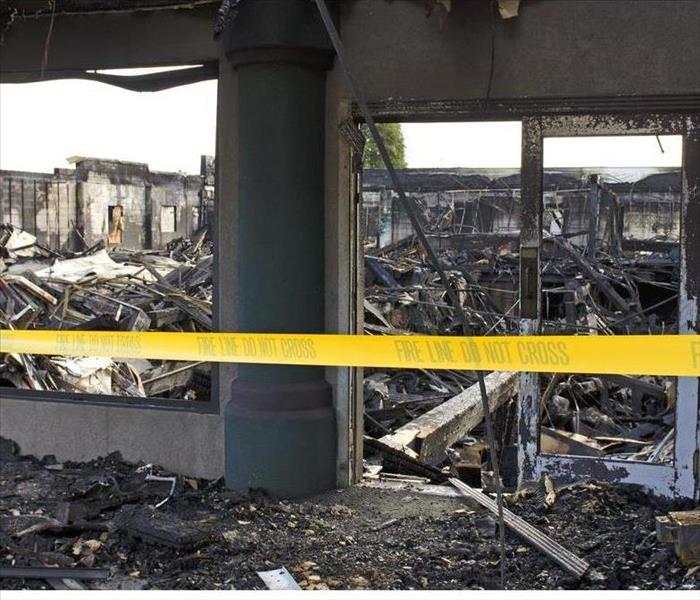 If you need assistance with emergency planning, or if you are currently dealing with fire damage and loss, contact SERVPRO, we can help you!
If you need assistance with emergency planning, or if you are currently dealing with fire damage and loss, contact SERVPRO, we can help you!
After A Fire, How Do You Secure A Structure?
A fire can cause extensive damage at a commercial property in Weymouth, MA. After the blaze has been extinguished, the structure may be at risk for additional damage and looting. Boarding up structural breaches and installing temporary fencing around the building are two of the best ways to limit these risks. Learn more about effective security measures for a building that has sustained fire damage.
Board Up
A fire can cause windows to break, destroy doors, and create holes in the walls or roof of a structure. Boarding up involves covering openings that can admit
• Debris
• Precipitation
• Trespassers
Boarding up will require at least two people, a sufficient amount of plywood, and nails or screws. Rely on a professional board up service to achieve the most secure results. Although tarping over a damaged roof may not add much additional security, it can help to keep out debris and water.
Fence
A building that has suffered fire damage may attract trespassers and looters who expect to find the location abandoned and unsecured. Even a damaged building may still contain valuable fixtures, inventory, or wiring. Security fencing can
• Restrict access
• Protect property
• Limit liability
Fencing can help to keep out passersby and limit secondary damage and losses. Contact a mitigation company to find out about the best options for securing a commercial property.
Monitor
It is important to document damage immediately after the fire occurs, prior to taking any steps toward mitigation. Afterward, the owner or manager should regularly check on the property. It is a good idea to leave up fencing until fire cleanup and restoration are complete.
These measures can help to prevent additional damage or losses from taking place at a damaged commercial building in Weymouth, MA. A fire damage mitigation company should provide all of these services, and commercial property insurers are likely to cover these protective measures.
How To Salvage Your Belongings After Water Damage
3/1/2022 (Permalink)
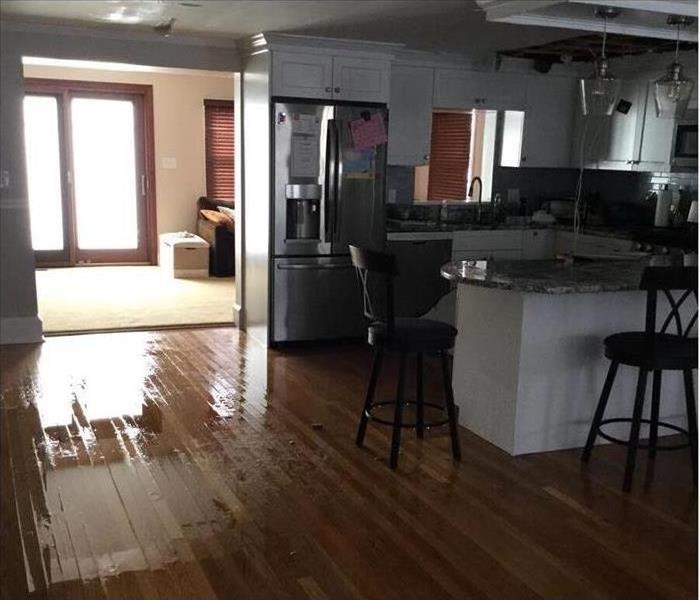 Do you know what to do if your home or business in Weymouth Landing, MA, suffers from a water damage event? Call SERVPRO!
Do you know what to do if your home or business in Weymouth Landing, MA, suffers from a water damage event? Call SERVPRO!
How To Recover Your Personal Property After Water Damage
Finding out your Weymouth Landing, MA, home has suffered significant water damage after a broken pipe leak or a hazardous flood is disruptive to anyone’s daily life. Moreover, it can be that much more heartbreaking when you come to find some of your favored treasures or heirlooms have been disturbed during the ordeal. However, there are various ways in which you can clean and restore your valuables that doesn’t have to end in devastation. Read on to learn some ideas for how to salvage your belongings after water in your home has invaded your personal items.
Focus on Print and Paper Items First
Documentation and important paperwork should be top priority when you’re searching through the damage to collect your things. While handling them, be gentle with them if they’re still wet or damp so they don’t tear. Items to be set aside to dry include:
- Certificates, deeds, licenses and other important paperwork
- Tax files
- Photographs
- Artwork
- Books, and more
If you’re unclear about the condition of the water in your home, leave the items in a cool, dry place and be sure to let a certified team of water damage specialists inspect them before simply putting them back safely into storage. This can help eliminate the chance of mold or mildew from growing and spreading in the future.
Treat All Clothing, Leather, or Furnished Items With Soap or Disinfectant
When it comes to fabrics and textiles, it’s important to address the state of the damage first. Clothing can be treated through professional dry cleaning if they’re soiled or stained. Furniture covered in leather or plastic can simply be wiped down with water and soap if necessary, but any water damage sustained deep into furnished pieces should be cleaned and sterilized by specialists.
Discovering water in your home and seeing your belongings hit by its destructive path can, at first glance, seem hopeless, as though your things might never be recovered. However, in many cases, your valuables can be restored to their original glory by following some of these methods, helping you to rebuild your cozy home "Like it never even happened."
Five Tips for Safely Using Candles in Your Home
2/15/2022 (Permalink)
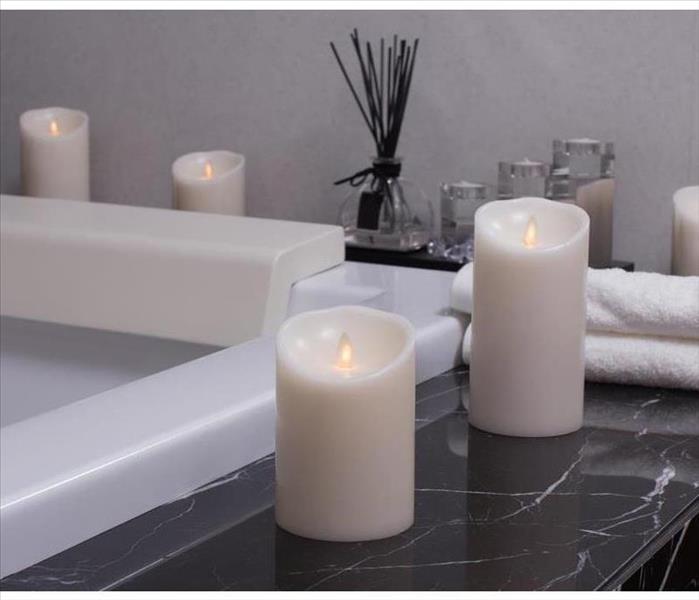 Because fire can be devastating to your home and smoke cleanup can be difficult, using a candle alternative can be a great choice.
Because fire can be devastating to your home and smoke cleanup can be difficult, using a candle alternative can be a great choice.
Five Tips For Using Candles Safely At Home
Candles can provide a warm and cozy atmosphere in your Hingham, MA home, but they can also be the cause of significant damage. A candle fire can easily become an emergency, so keep these tips in mind when using them in your home.
1. Keep Candles Away From Flammable Objects
When you are burning a candle, be sure not to use it too close to anything that could catch fire. You should place candles at least a foot away from curtains, bedding, papers and other flammable objects. You should be especially cautious of highly flammable liquids.
2. Don’t Leave Burning Candles Unattended
While it may seem like a hassle to extinguish the candle every time you may leave the room, it is unsafe to leave it burning unattended. If a fire were to start while you were out of the room, it could spread quickly before you return.
3. Keep Pets and Children Away From Lit Candles
If you have children and pets in your household, it is important to keep them away from any lit candles. As well as injuring themselves, a young child or pet might cause a candle fire by accidentally knocking it over.
4. Only Place Candles in Containers Specifically Made for This Use
You should never use a candle in a container that was not made to be used with them. A container that is not heat resistant could melt or burst, resulting in a fire.
5. Consider Using Candle Alternatives
Because fire can be devastating to your home and smoke cleanup can be difficult, using a candle alternative can be a great choice. Instead of using candles during a power outage, you should use a flashlight or other battery-operated light. For daily use, there are battery-powered candles that can give you the same ambiance as a burning candle without the safety risk.
Although candles are a commonly used item, a candle fire can cause a lot of damage. A fire restoration company can help after an emergency, but you should be sure to follow these tips to keep your home safe.
Why Quick Water Damage Response Matters
2/11/2022 (Permalink)
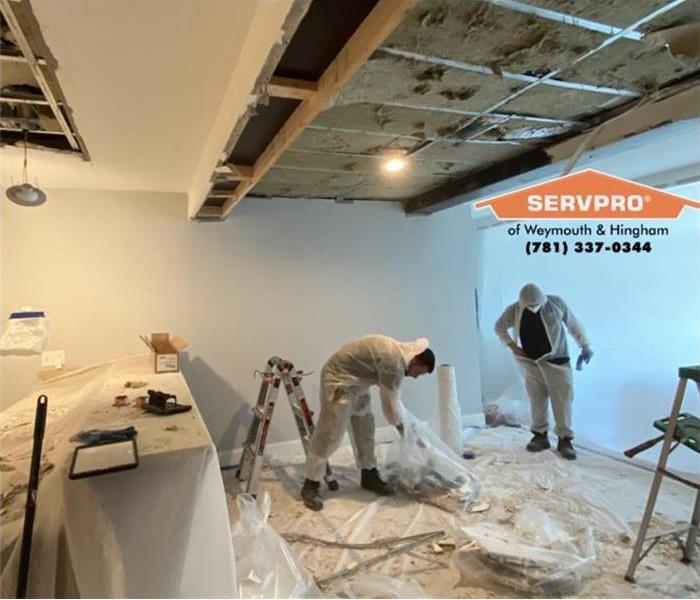 Make things easy on yourself – reach out to a 24 hour water damage restoration specialist for a fast response that minimizes long term damage.
Make things easy on yourself – reach out to a 24 hour water damage restoration specialist for a fast response that minimizes long term damage.
Why Is It Important To Respond Quickly To Water Damage?
When water damage strikes, it can be easy to drag your feet to respond. But a slow response to water damage is one of the easiest ways to ensure the damage becomes worse. That’s because water problems can progress very quickly. Check out this water damage timeline to learn just what happens after water damages your Weymouth, MA, building and why finding a 24 hour, always open water damage specialist is critical.
Within Water Damage
Water damage describes various losses caused by intruding water after attacking a material or system. Some of the fallout of such breaches include:
Minimizing the chances of any of the above depends on how fast you respond. Unfortunately, water damage can start multiplying quickly.
Within Minutes
Minutes after flooding, or another type of water catastrophe, walls, floors and other porous materials begin absorbing fluid. Furniture finishes begin to bleed, while the process of permanent staining begins on things like carpets. Paper goods, such as books and photographs, rapidly begin to swell and become irreversibly damaged. This is an ideal time to contact a 24 hour cleanup specialist.
Within 24 Hours
Within a day of water damage, drywall can begin to swell, leading to significant structural damage. Expect exposed metal surfaces to begin tarnishing, while furniture progresses from staining to swelling and cracking. At this point, an odor may also appear.
Within One Week
A week of water damage can be devastating to your belongings. After a week, anticipate warping of doors, windows and wood materials like floors. Meanwhile, odors may progress to rank mold and mildew.
In as little as a week, water damage can take your property to the point of no return, increasing costs and headaches while causing catastrophic damage. Make things easy on yourself – reach out to a 24 hour water damage restoration specialist for a fast response that minimizes long term damage.
Replace a Toilet In 10 Steps
2/1/2022 (Permalink)
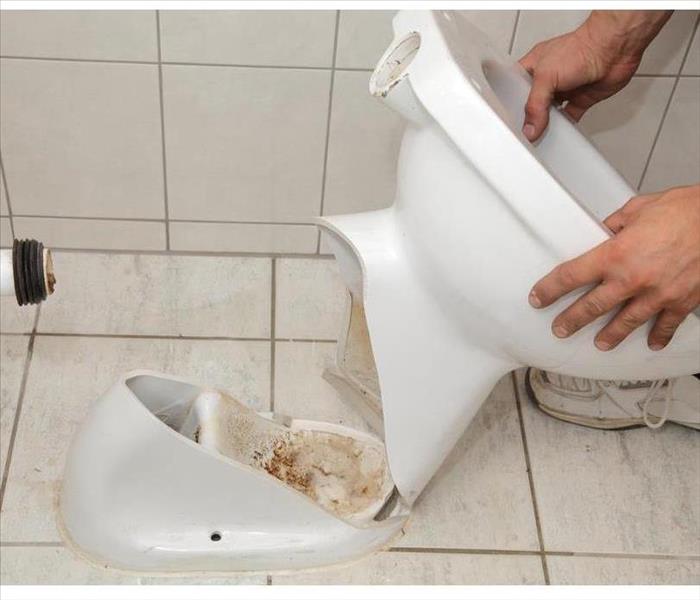 If you have water damage in your home, call SERVPRO. Our team has the right equipment for the job. Give us a call for your water damage, 24/7.
If you have water damage in your home, call SERVPRO. Our team has the right equipment for the job. Give us a call for your water damage, 24/7.
In Ten Simple Steps, You Can Replace A Toilet.
Homeowners may save money by replacing a broken or persistently leaking toilet. If you have a basic understanding of toilet repair and the necessary tools, these ten steps can guide you through the replacement process.
1. Measure
Measure from the wall behind the old toilet to the water supply line and closet bolts. You may also measure from the bowl to the sidewall.
2. Eliminate Water
Turn off the water supply and flush water from the tank. Use a sponge or solidifying gel to dry the tank. Disconnect the supply line.
3. Remove Tank and Bowl
Unscrew the nuts on the bottom of the tank and lift the tank up off the bowl. Loosen and remove the nuts connecting the bowl to the floor and remove the bowl.
4. Remove Wax Ring and Closet Bolts
Remove and dispose of the wax ring. Use a putty knife to scrape excess wax off of the flange. Remove the closet bolts.
5. Check Flange Condition
A damaged flange can cause a leaking toilet. Complete repairs before installing a new toilet.
6. Install New Closet Bolts and Wax Ring
Install new closet bolts. Turn the new toilet bowl upside-down and install a new wax ring on the outlet.
7. Install Toilet Bowl
Situate the bowl over the closet bolts. Install cap bases, washers, and nuts. Use a hacksaw to shorten the bolts and snap on caps.
8. Install Tank
Install bolts and a rubber gasket on the bottom of the tank. Set the tank in place and tighten nuts.
9. Reconnect Water Supply
Connect the supply line. Flush the toilet and look for any signs of leaks.
10. Install Seat and Cover Tank
Install the seat and cover the tank. The toilet installation is complete.
If a new toilet leaks, it may be necessary to tighten closet bolts or check components. Hire a plumber if you cannot locate the source of a leaking toilet. For a severe leak or backup, rely on water damage restoration professionals in Hingham, MA.
Commercial Insurance Coverage Limits Determine If the Fire Loss Is Partial
1/17/2022 (Permalink)
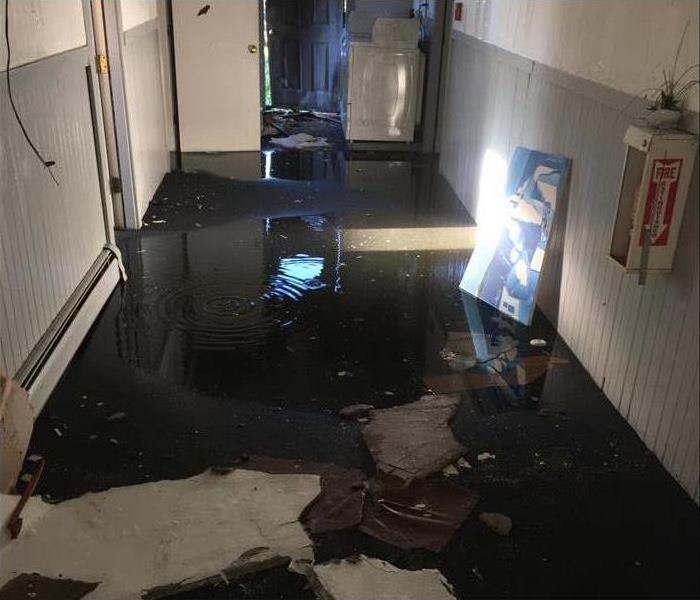 When extinguishing the fire, water was a friend. Now, it is an enemy.
When extinguishing the fire, water was a friend. Now, it is an enemy.
If The Fire Loss Is Partial, The Commercial Insurance Coverage Limits Determine This.
Simply put, the insurer will determine the loss to be partial if the policy limits are high enough to pay the cost of restoration. Damage inflicted by partial loss fires generally fall into three categories:
Water Cleanup Is the Top Priority After a Fire
When extinguishing the fire, water was a friend. Now, it is an enemy. It seeps into every porous material it encounters and continues inflicting damage in your building.
After the fire, aggressively remove the water as quickly as possible to minimize the fire loss. Any delay would be like sending mold an invitation to dinner. Water removal will require:
- Elimination of standing water using pumps and wet-vacs
- Removal of restorable wet fabrics, carpets and furniture
- Disposal of unrestorable wet fabrics and carpets
- Removal of everything not damaged by water
- Removal and disposal of damaged wallboard and other construction materials
- Deployment of high-volume fans to help dry out everything that remains
Smoke Damage Mitigation Is A Complex Process
While the water cleanup is underway, it would be a good idea to begin treating the damage caused by smoke. Smoke cleanup is usually a three-step process:
- Install air filtration equipment to remove residual smoke residue from the air
- Use ozone machines to neutralize smoke residue that has settled on surfaces everywhere
- Deodorize your building by thermal fogging
Ozone and thermal fog are both dangerous to humans. Therefore, the structure should be unoccupied while those tasks are taking place.
Fire Damage Is Often the Simplest Cleanup of All
Damage caused by flames is easily identifiable. Anything touched by fire needs to be removed, painted or sent out for restoration. Complete the treatment of fire damage before completing the air filtration step.
All the tasks associated with fire loss and cleanup require specialized skills and equipment. A team of fire restoration specialists is in the Hingham, MA, area. They are ready to get started and are waiting for the call.
3 Facts About Fire Damage at a Rental Property
1/17/2022 (Permalink)
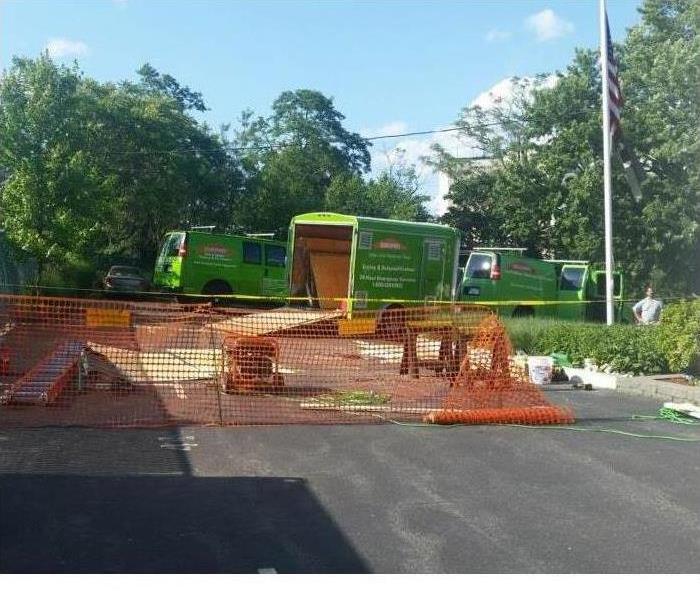 If you need assistance with emergency planning, or if you are currently dealing with fire damage and loss, contact SERVPRO, we can help you!
If you need assistance with emergency planning, or if you are currently dealing with fire damage and loss, contact SERVPRO, we can help you!
Three Fire-Related Facts For Renters
Rental property owners and tenants may be unsure about the limits of their responsibilities for fire damage. Here are three helpful facts about liability and insurance coverage in the event of an apartment fire in Weymouth Landing, MA.
1. Property Owners Are Responsible For Structural Damage
A landlord is responsible for covering damage caused by fire to the property itself. This includes building materials, systems, and provided contents, such as carpeting. A homeowners insurance policy should cover the cost of cleaning, restoring, or replacing damaged materials and items.
2. Tenants Are Responsible For Their Contents
Tenants are responsible for restoring or replacing their own possessions following an apartment fire. These contents may include clothing, furniture, electronic devices, and personal effects. This is likely to be the case regardless of the cause of a fire. Renters insurance can help to offset costs that accrue due to a fire at a rented residence. Tenants should make sure that that the policy they choose will cover replacement costs and not actual value with depreciation.
3. Renters Insurance Can Cover Additional Costs
Renters insurance policies may also provide a limited amount of liability coverage for negligence as well as injuries or property damage suffered by third parties. These policies may also help to offset a variety of expenses associated with loss of a use of a residence, such as additional living costs or the cost of temporary relocation for the duration of the mitigation and restoration process.
After an apartment fire has been extinguished, renters should document damage to contents and make a list of items in need of restoration, repair, or replacement. Try to locate proof of purchase if possible. Property owners should also document structural damage to support a separate homeowners insurance claim. Renters and landlords can both benefit from the expertise of a fire damage cleanup and restoration company in Weymouth Landing, MA.
Commercial Property Insurance 101: What Is Covered After a Storm and What Isn't?
1/17/2022 (Permalink)
 If your business qualifies for coverage, your storm insurance often covers damage that occurs to your building, even the storm damage restoration.
If your business qualifies for coverage, your storm insurance often covers damage that occurs to your building, even the storm damage restoration.
What Is Covered And What Isn't In Commercial Property Insurance After A Storm?
As a business owner in Weymouth, MA, it is essential you understand your commercial property insurance and what emergencies it covers. While there are a lot of situations you are often covered for, there are specific types of disasters and circumstances that will probably not be included. It is important you consider your specific location, needs, and current insurance coverage when considering adding on new policies to your existing plan. While your storm insurance will vary slightly depending on your policy, here is an overview on what most commercial property insurance policies cover after a storm.
Is Storm Damage Covered?
In short, the answer is yes that insurance is typically included in your commercial property insurance policy. Since storm damage can cover a wide variety of emergency types, here are specific situations you can expect to be covered for:
- Blizzards
- Tornadoes
- Hurricanes
- Lightening
In the situations your business qualifies for coverage, your storm insurance often covers damage that occurs to your building, including the cost of storm damage restoration. Your policy may also cover the contents of the building, including equipment, furniture, and inventory, up to the predetermined dollar limit listed on your policy.
What Damage Isn’t Covered?
Under a standard policy, there are several situations where you will often not be covered. For instance, flood damage isn’t covered, and you will need to check if your policy covers windstorm and hail damage. While some policies automatically include this type of coverage, others require an additional plan. It is also important to note you will not be compensated from insurance for the time you are out of business unless you purchase business interruption coverage. Additionally, your plan will generally only cover damage caused by the storm and will not cover anything thought to be a cause of wear and tear.
An important step in preparing your business for an emergency is to find out what your specific commercial property insurance policy covers. While your storm insurance coverage includes many types of emergencies, not everything is automatically included.
3 Ways To Start Restoring Your Home After Water Damage
1/17/2022 (Permalink)
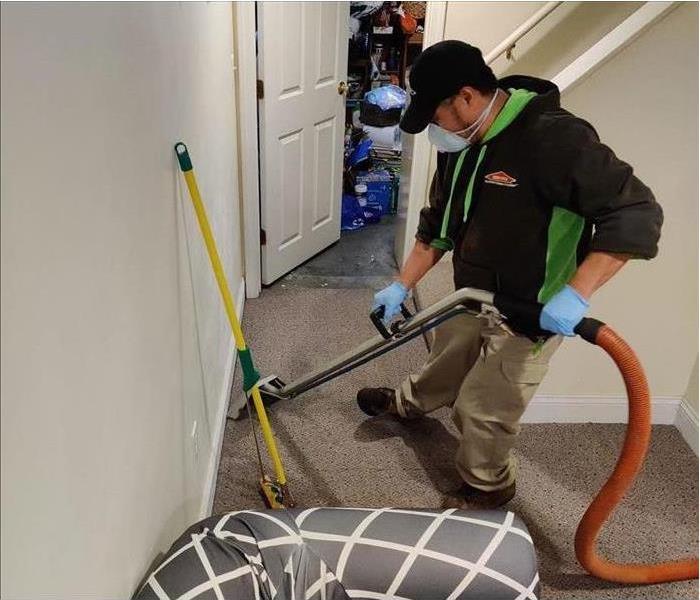 When a water loss occurs, the water can quickly become absorbed by the materials in your home. Call SERVPRO for help!
When a water loss occurs, the water can quickly become absorbed by the materials in your home. Call SERVPRO for help!
3 Ways To Begin Restoring Your Home After It Has Been Flooded
If you’ve recently come across water damage in your Hingham, MA, home, you probably know it’s important to act fast. However, you may not know where to start when it comes to handling the water cleanup. Here are three ways to begin the process of restoration in your home, whether it’s due to common broken pipes or a surprise natural disaster.
1. Shut off the main water supply in the home until help arrives.
If damage has resulted from common leaks in the home, the most important first step is ensuring that the source of the water is found and stopped. Turning off the main water valve is key to taking control of the issue and stopping any more serious damage from occurring. Once a trained water damage restoration team has been contacted to inspect the home, they can inform you when the source has been located, and it’s acceptable to turn the water supply back on throughout the house.
2. Determine the toxicity of the water involved.
There are different types of water to consider when dealing with damage to your home. Clean water comes from sources such as simple broken pipes, rain or condensation, and it can be swiftly removed without the need for proper protection. However, the type known as black water is the most severe, coming from sources such as sewage lines or flood waters from natural disasters that can contain unknown bacteria or other contaminants. If this is the case in your Hingham, MA, home, stay away from the water and call for professional help to decontaminate the area.
3. If you’re able, try to dry out the area where damage has occurred.
If it’s safe to use electricity in the home, simply staging fans or dehumidifiers near the water-affected zones can be a great help to start mitigating the damage.
If you’ve come across water damage in your residence and you don’t know where to turn, know that there are always professionals here to help restore your home and give you peace of mind.






 24/7 Emergency Service
24/7 Emergency Service





























































